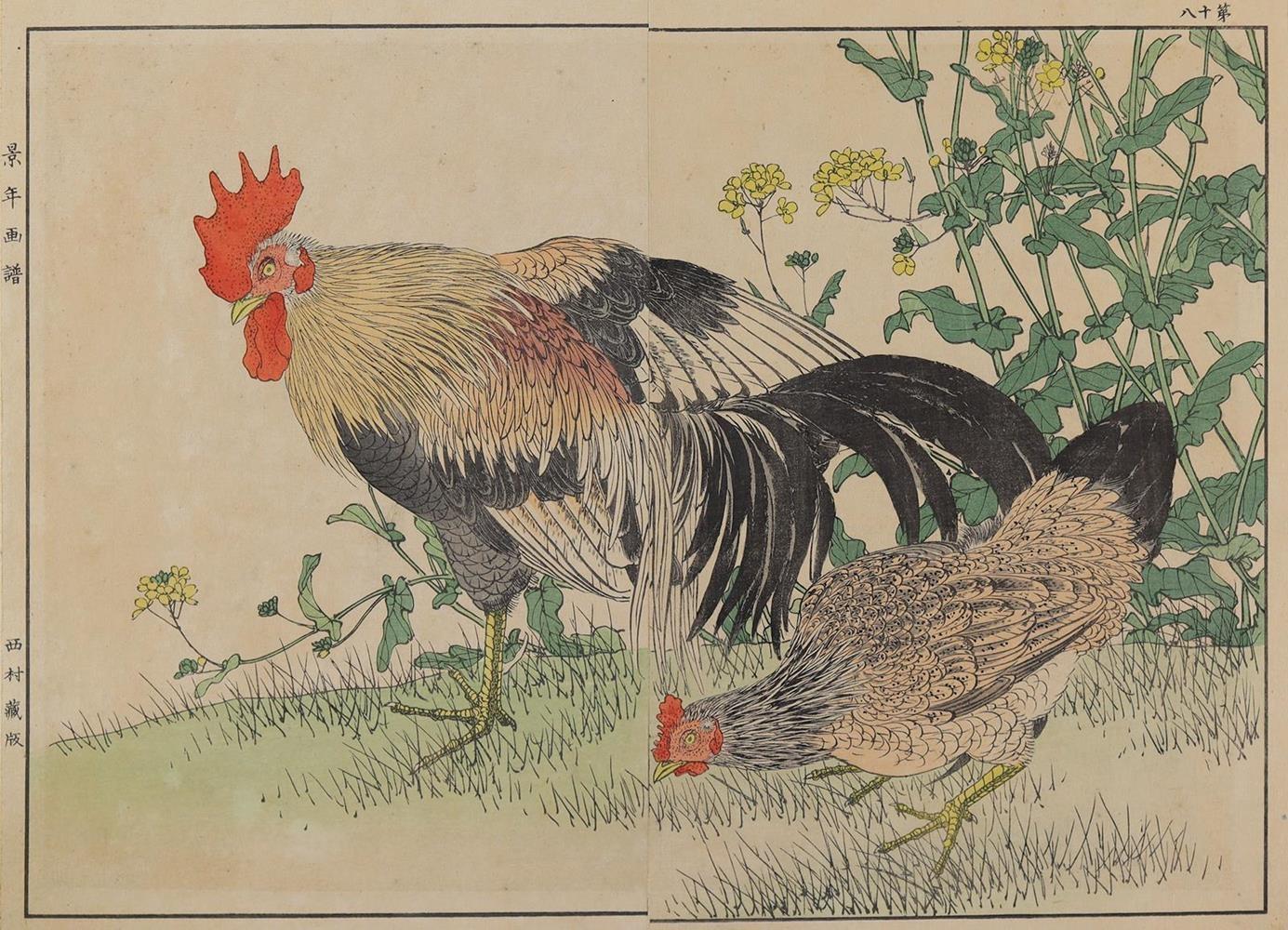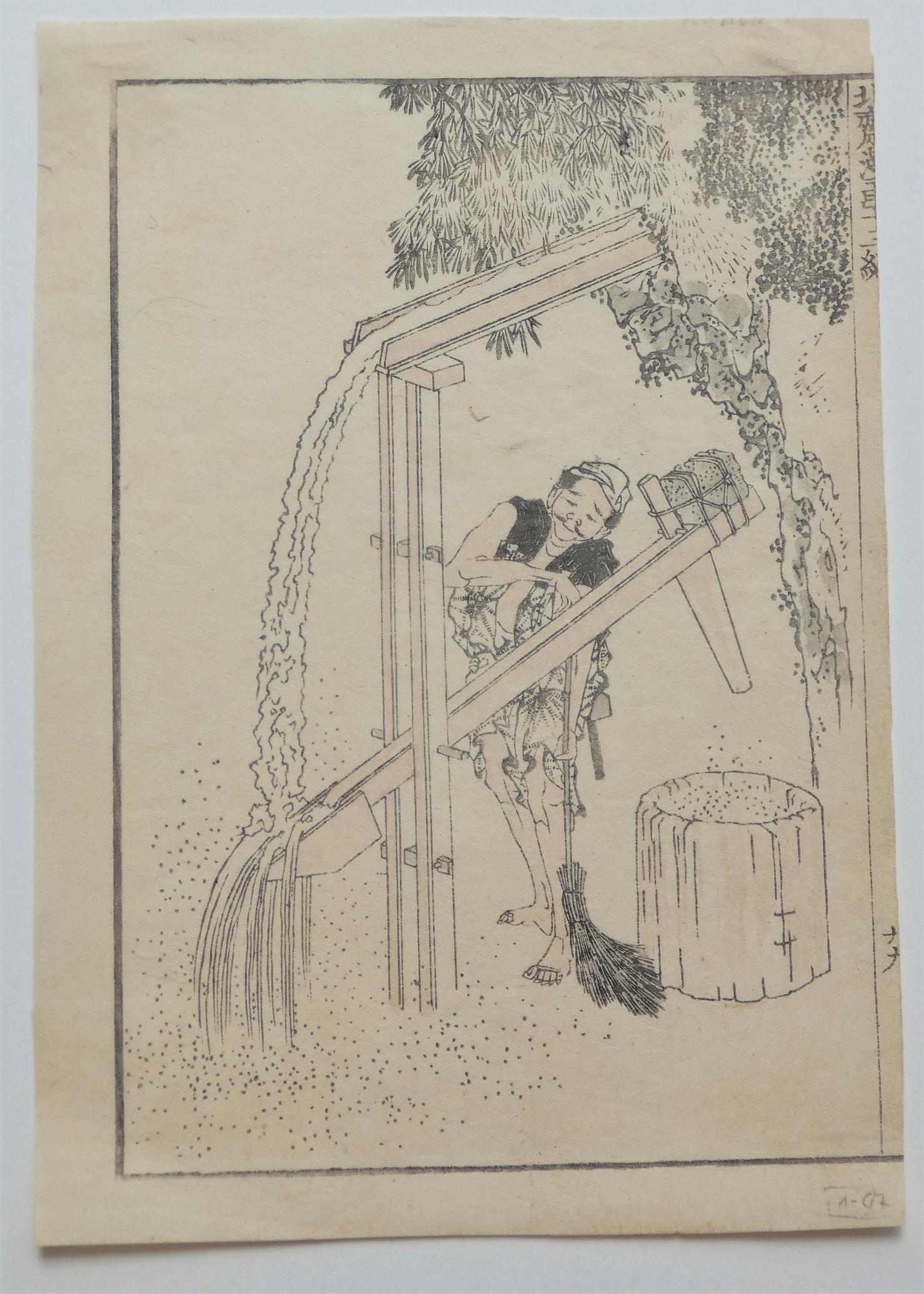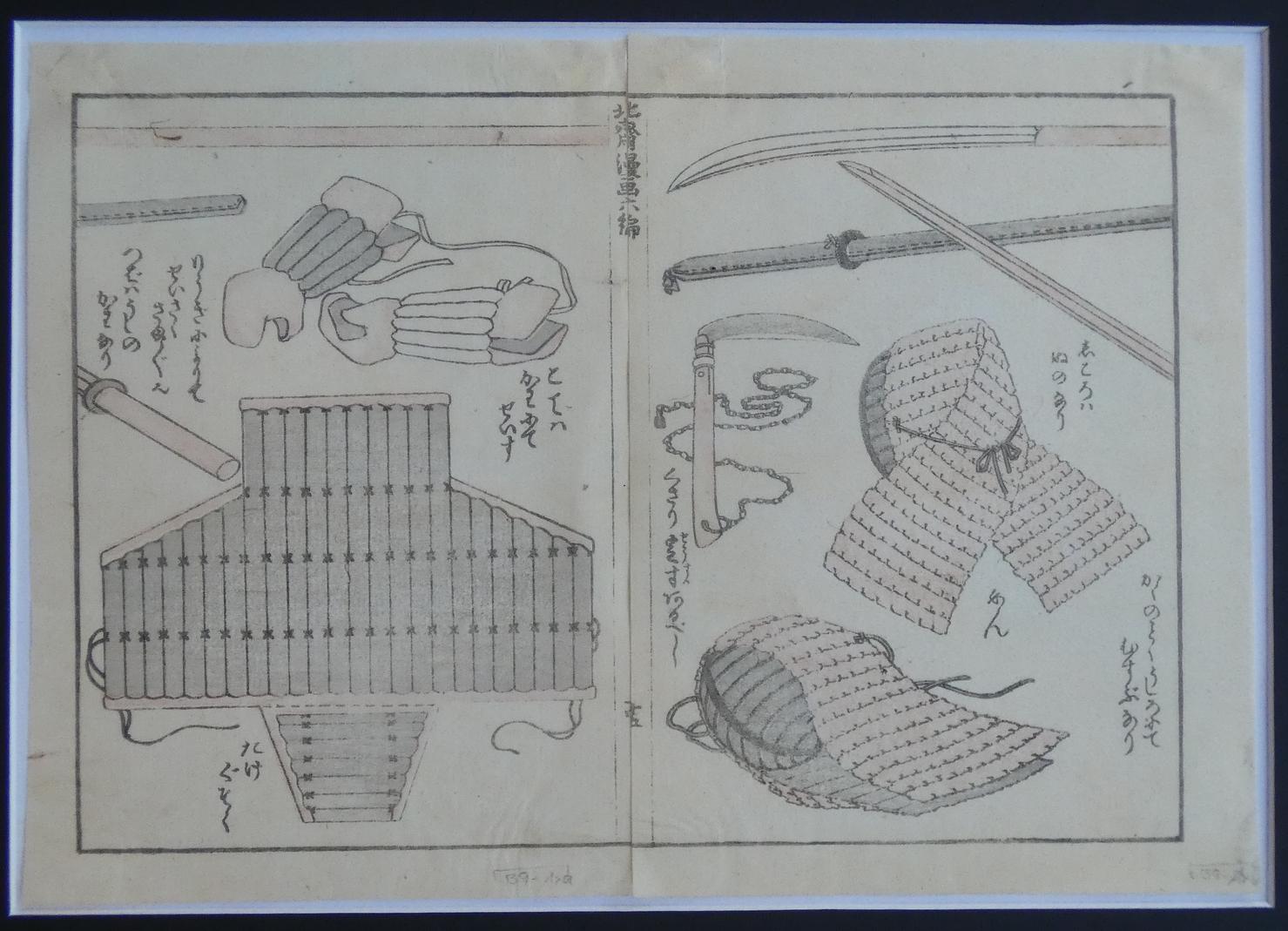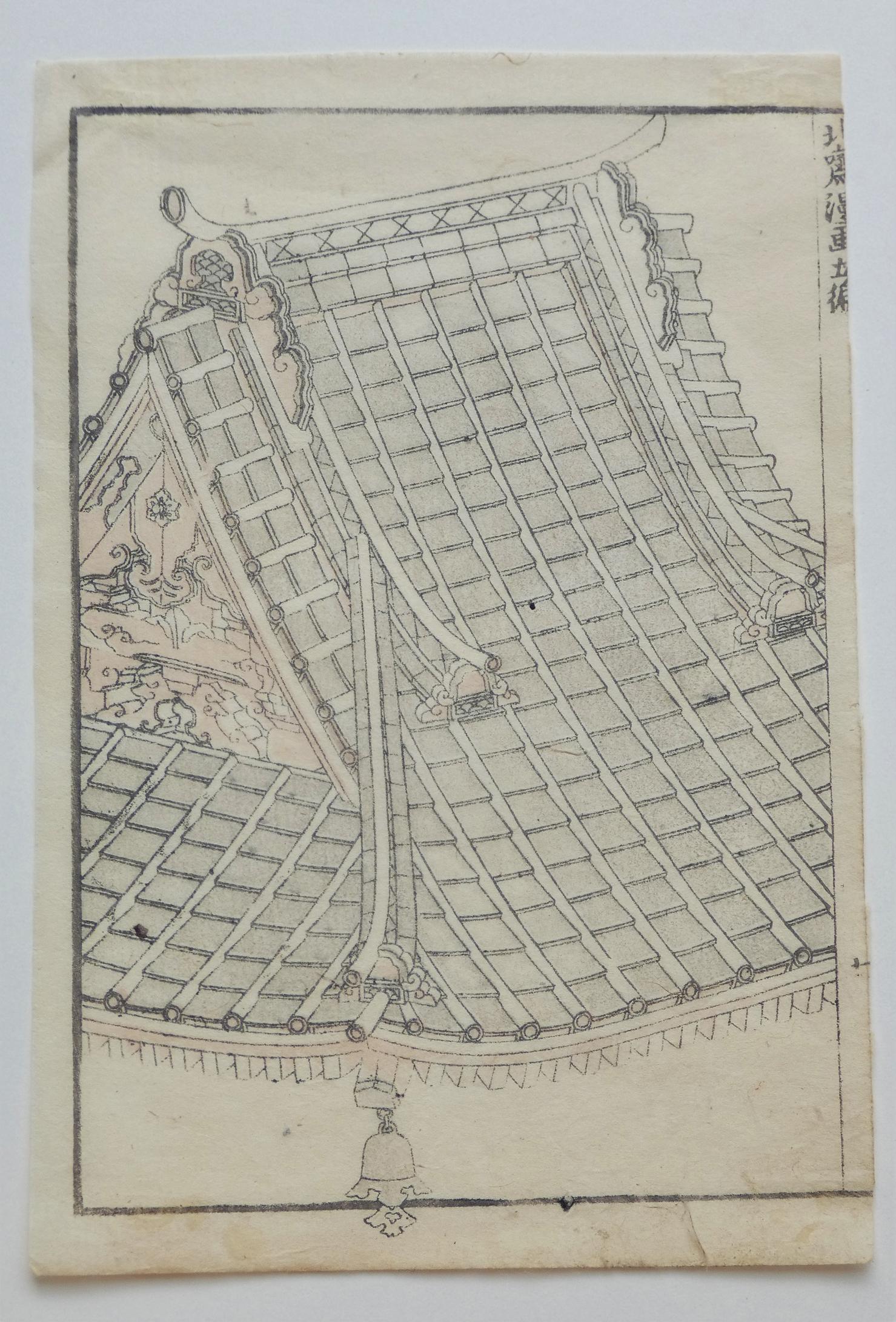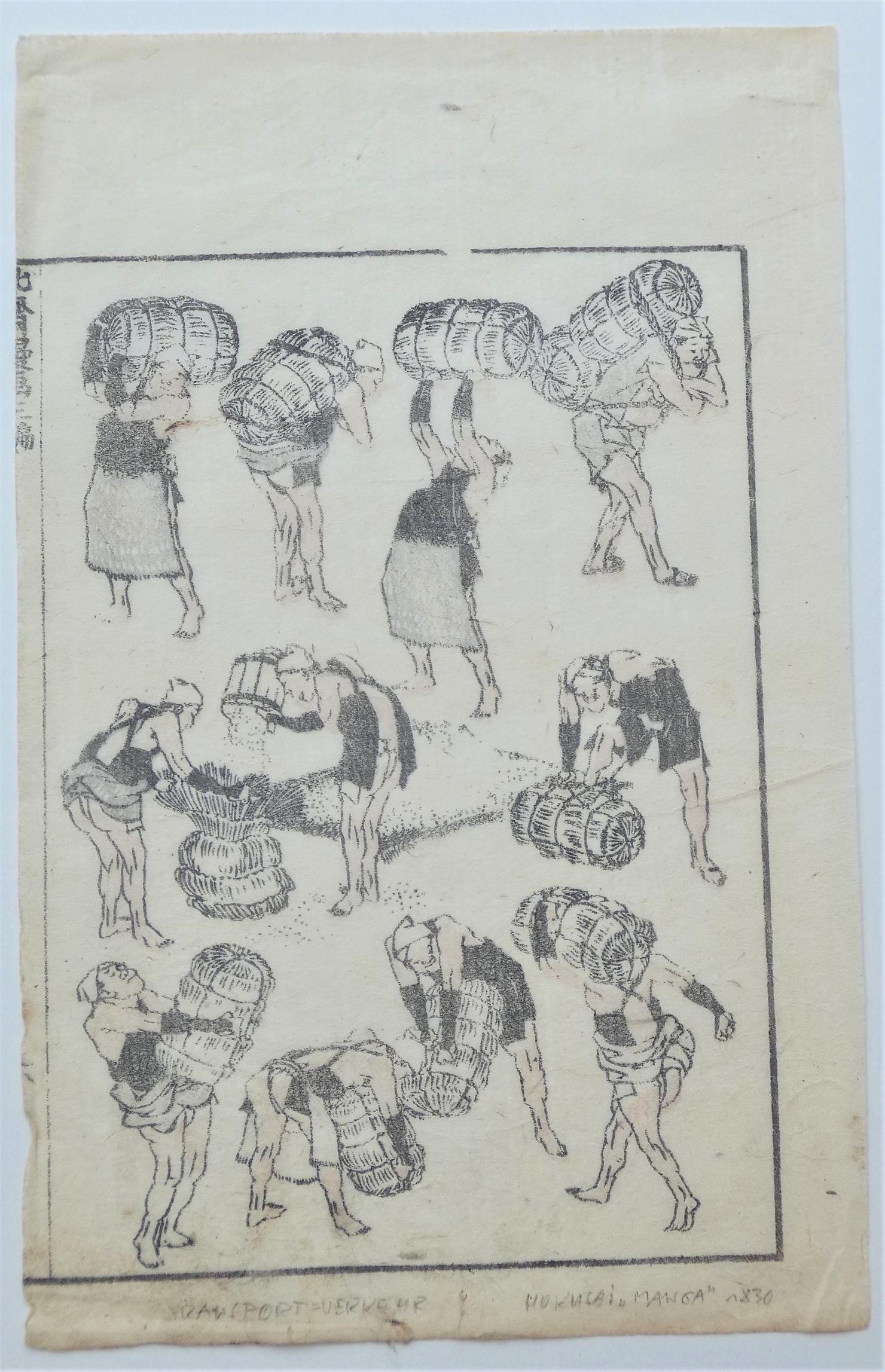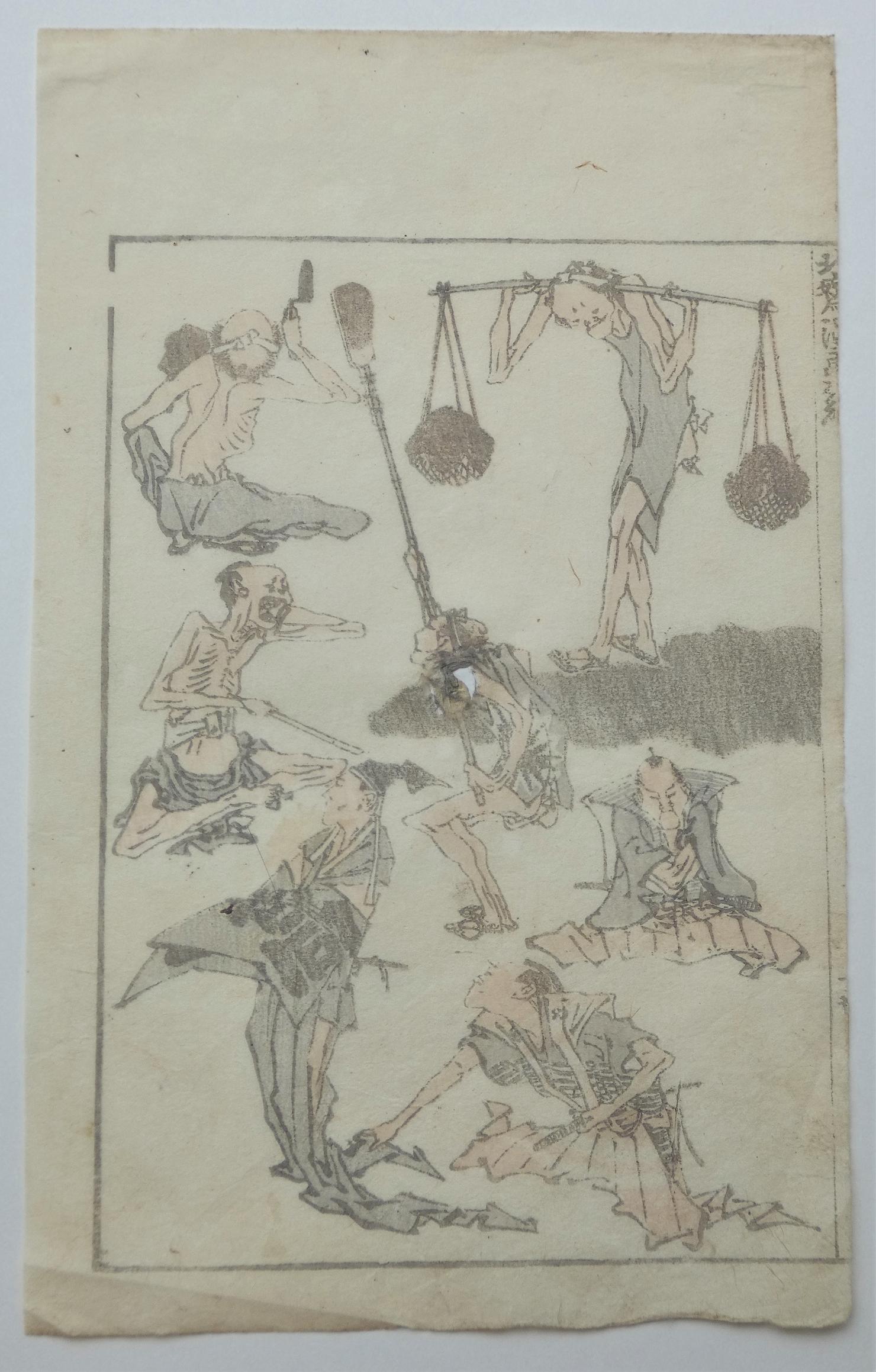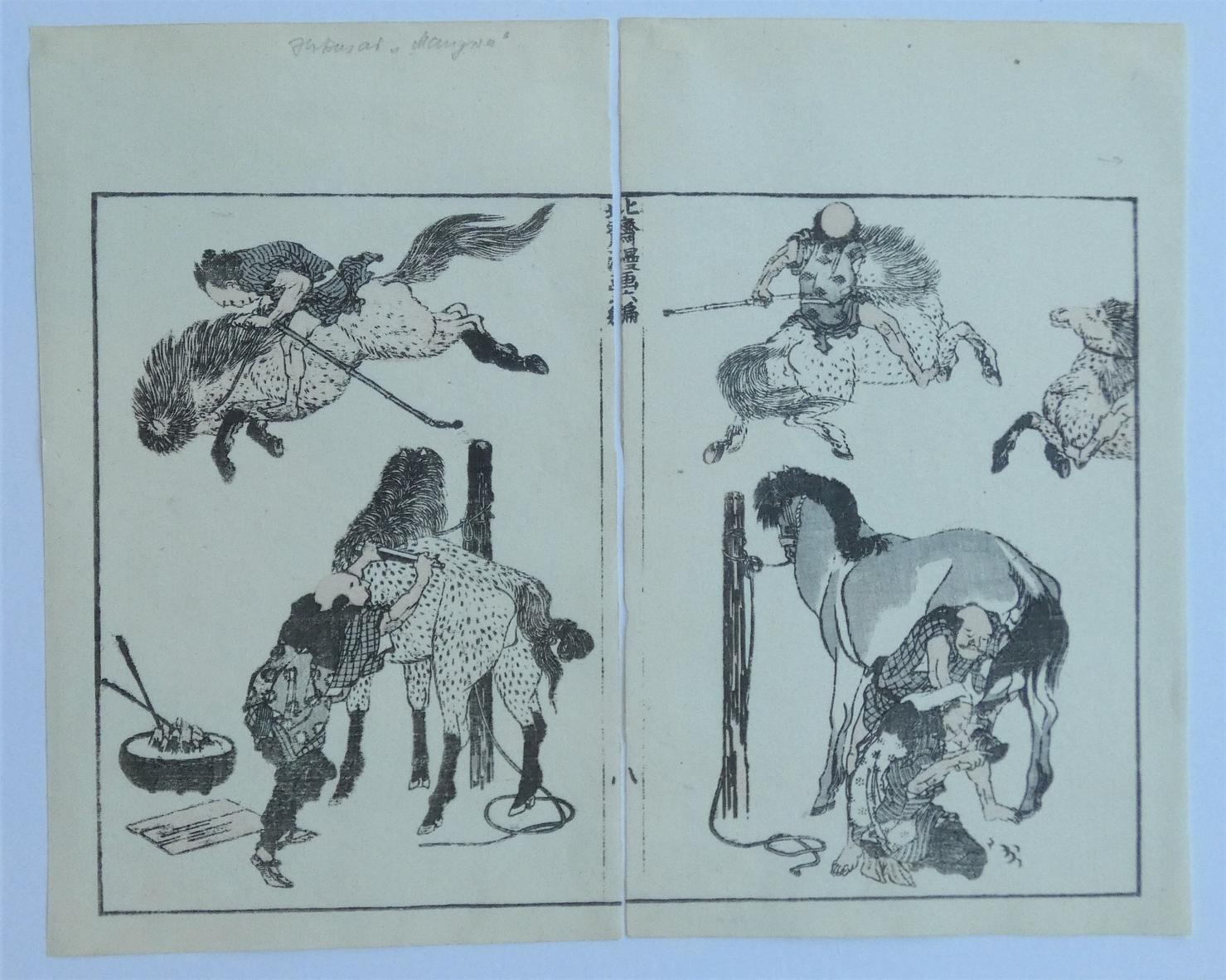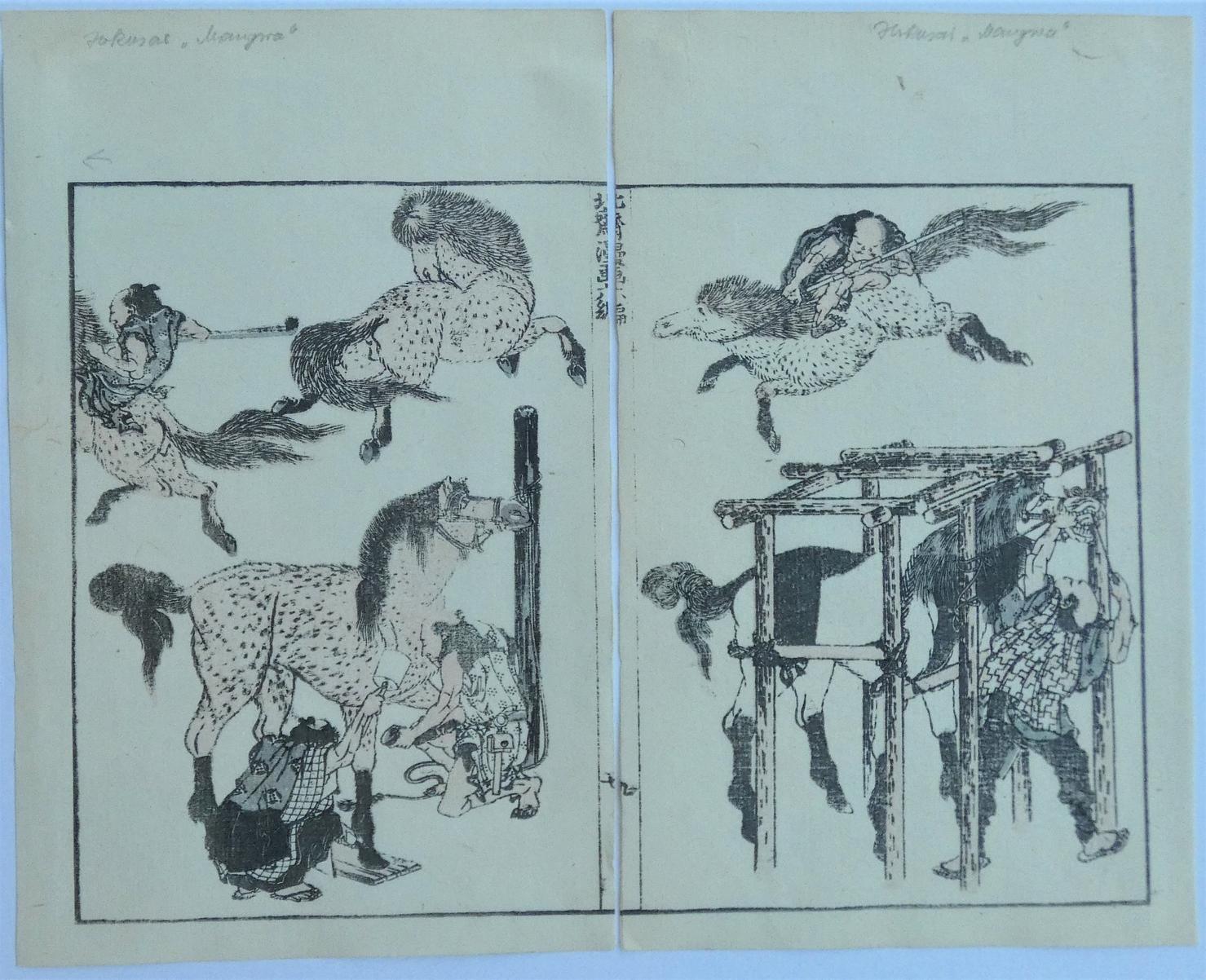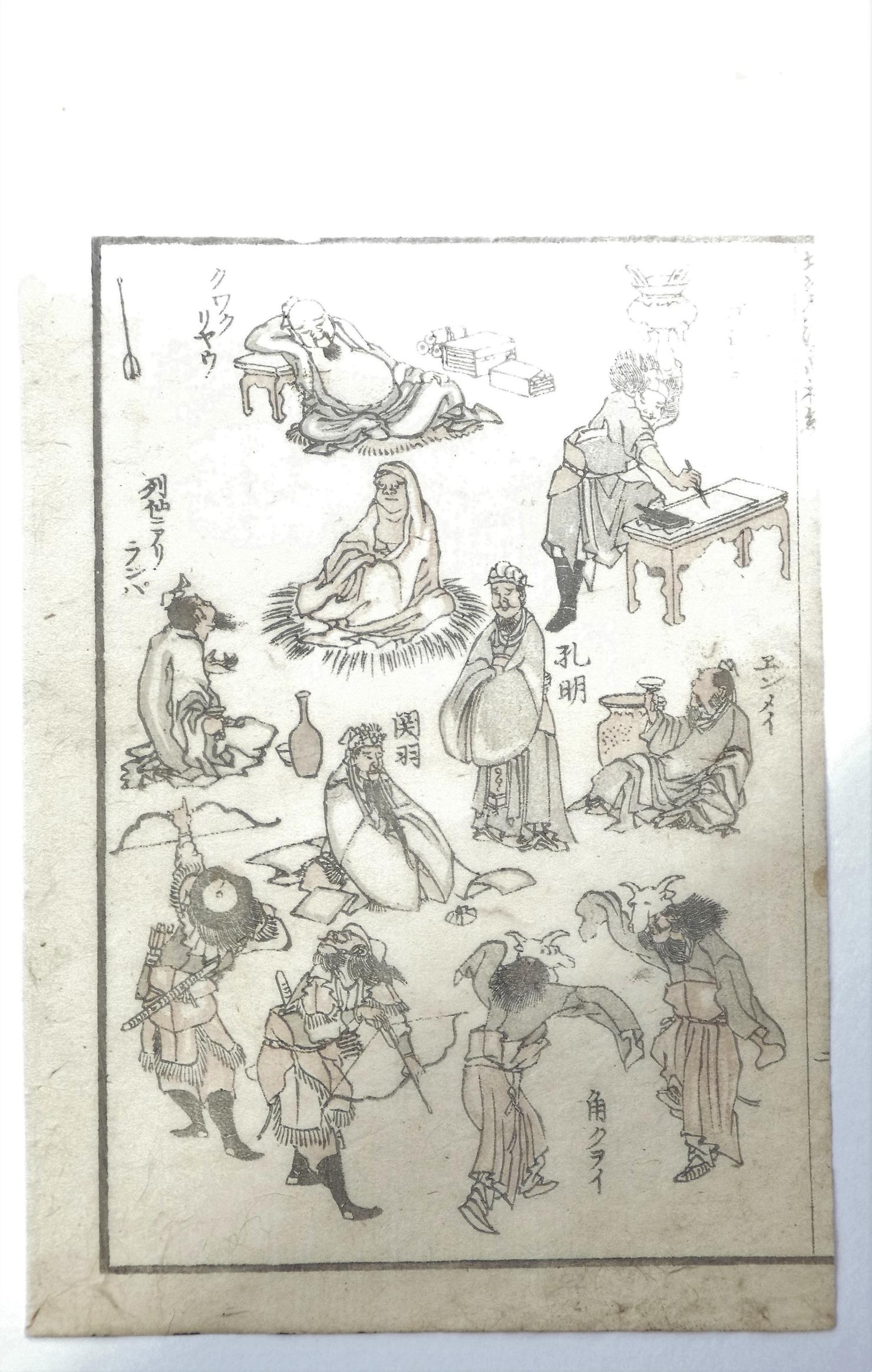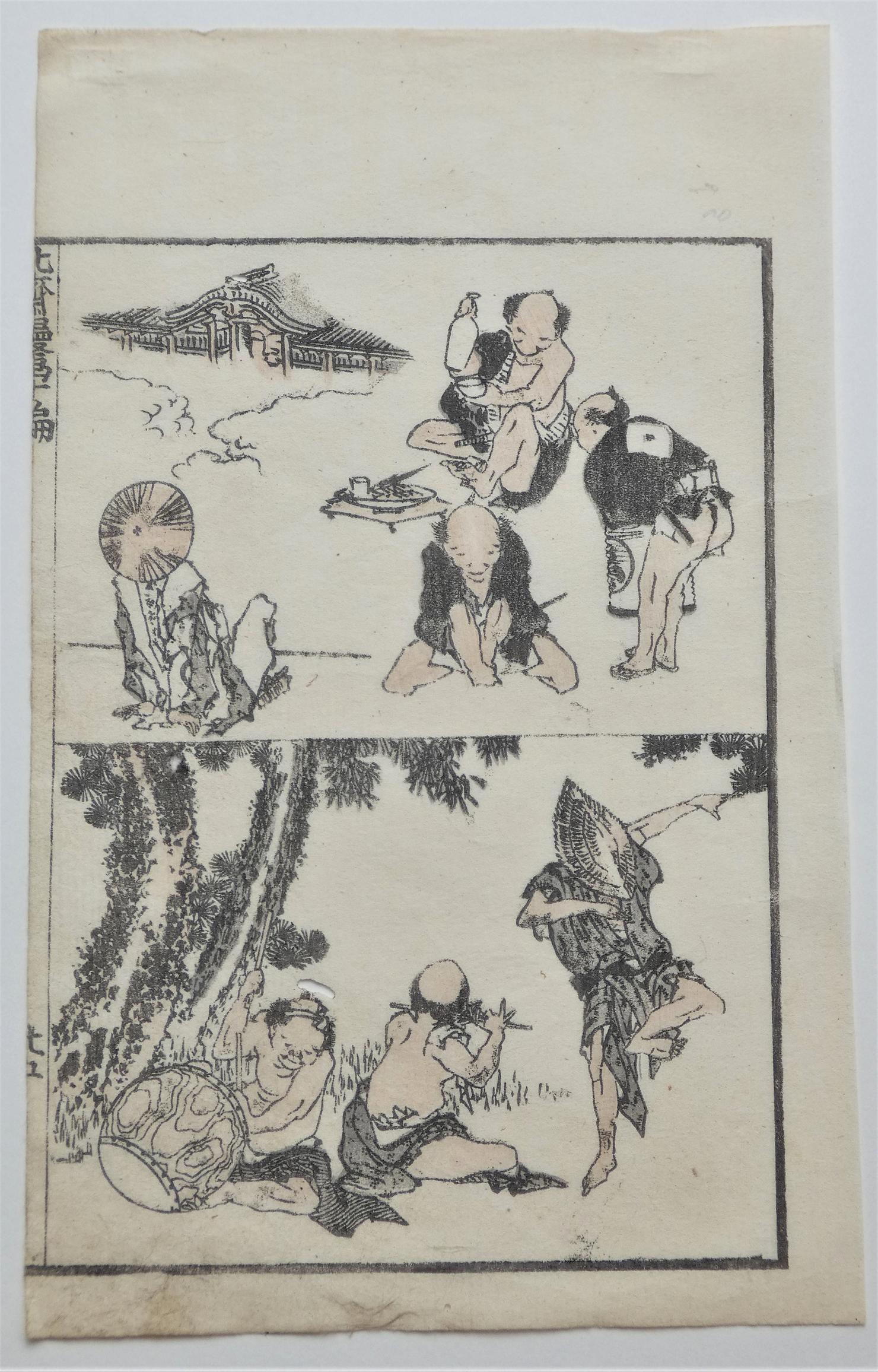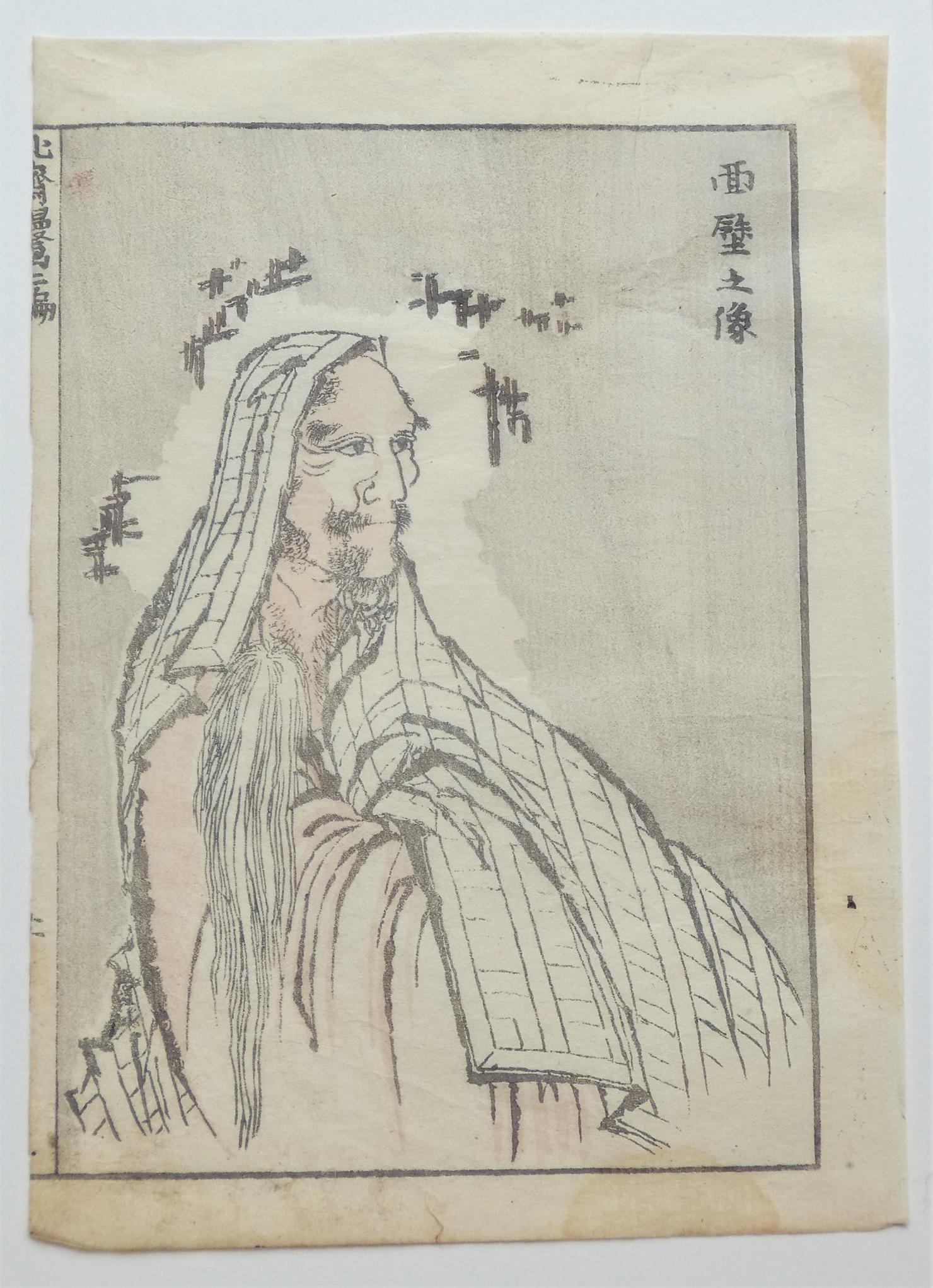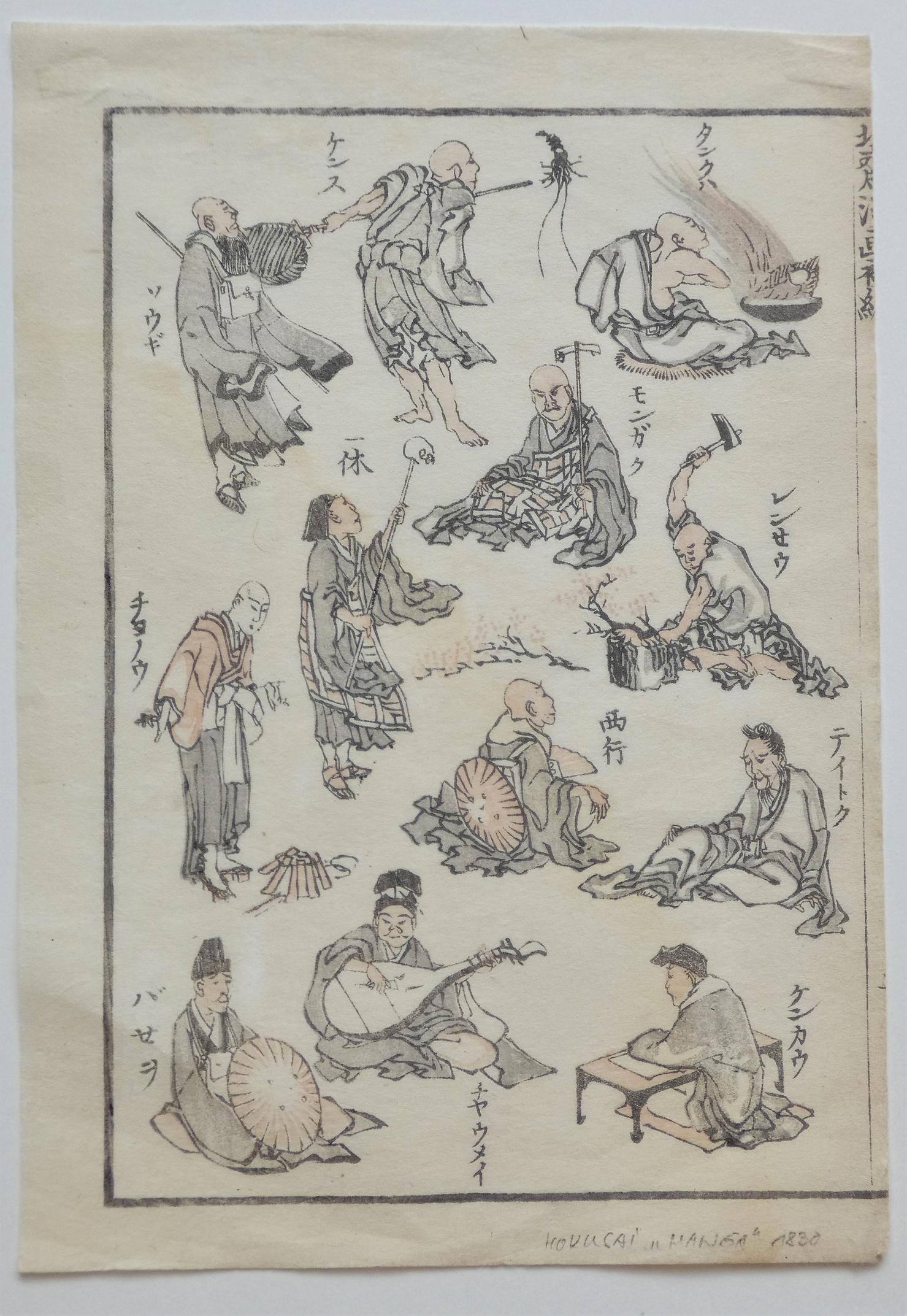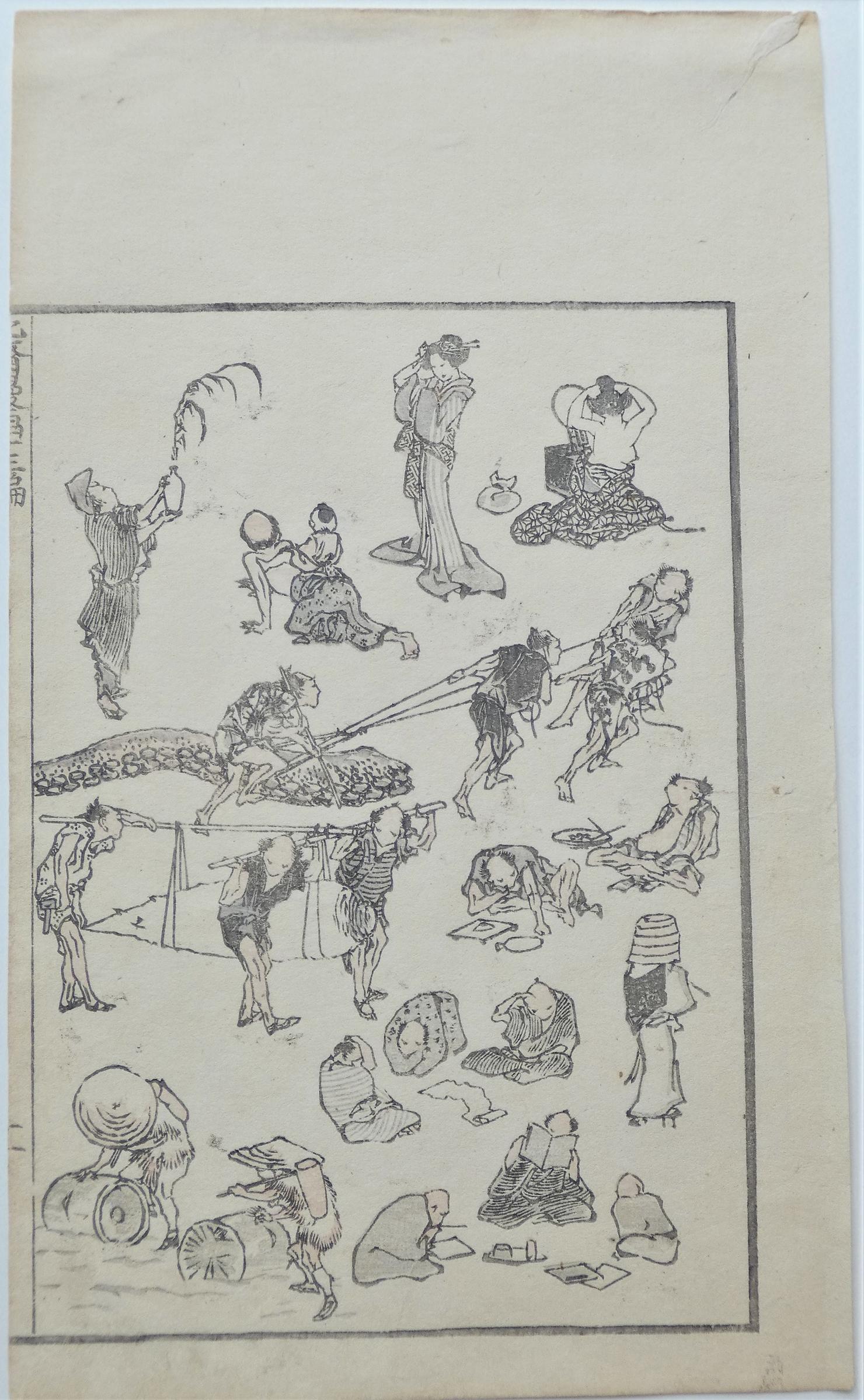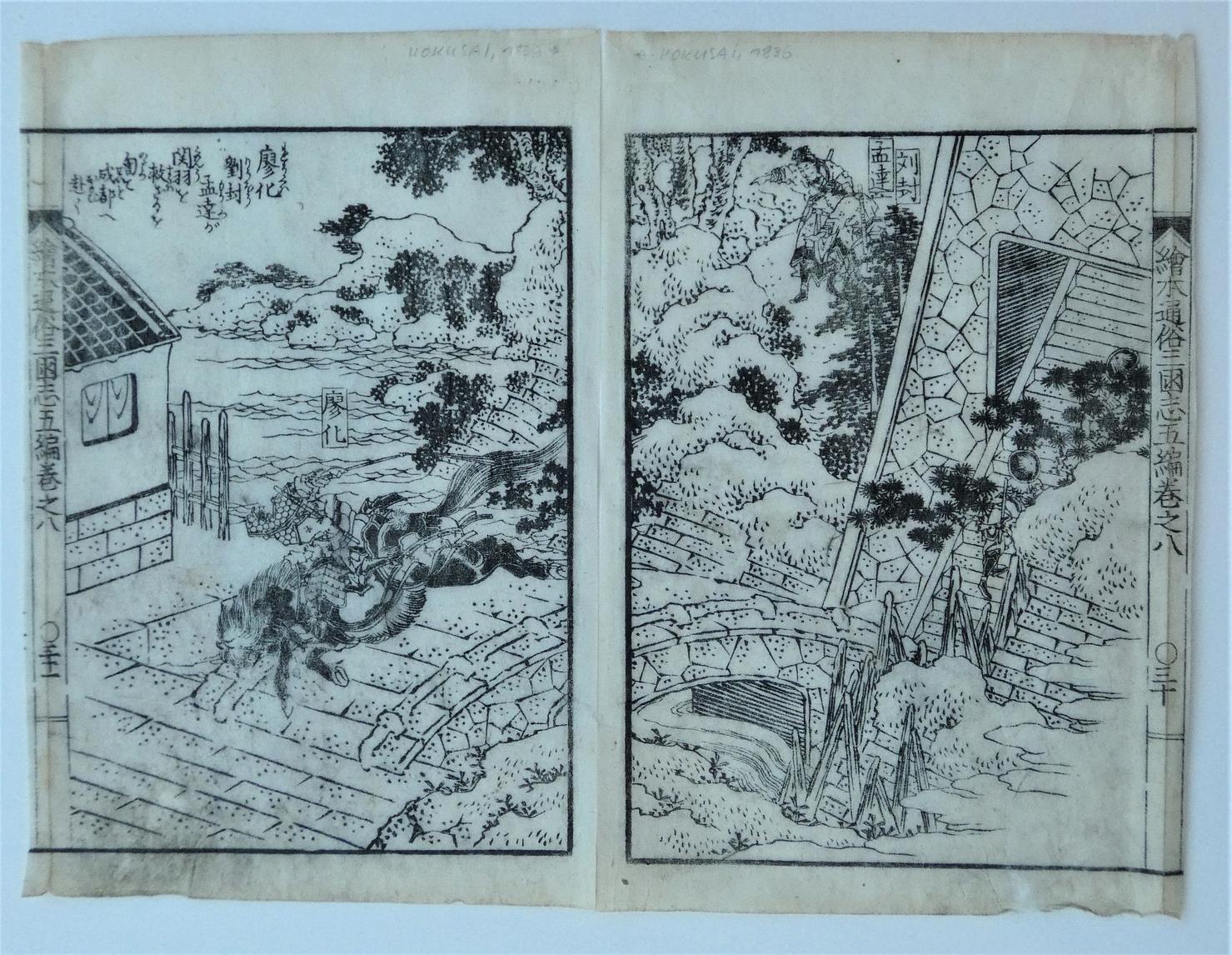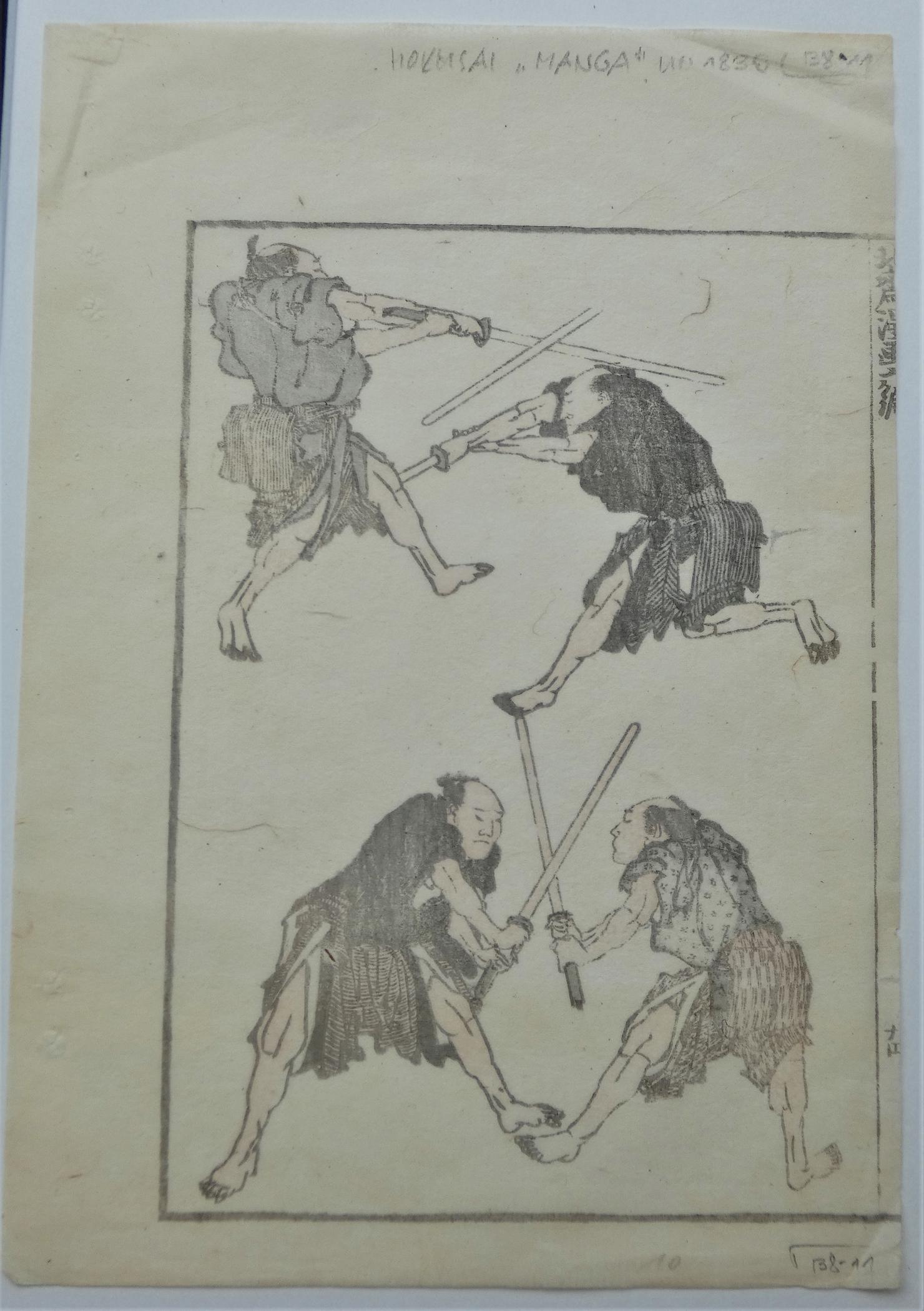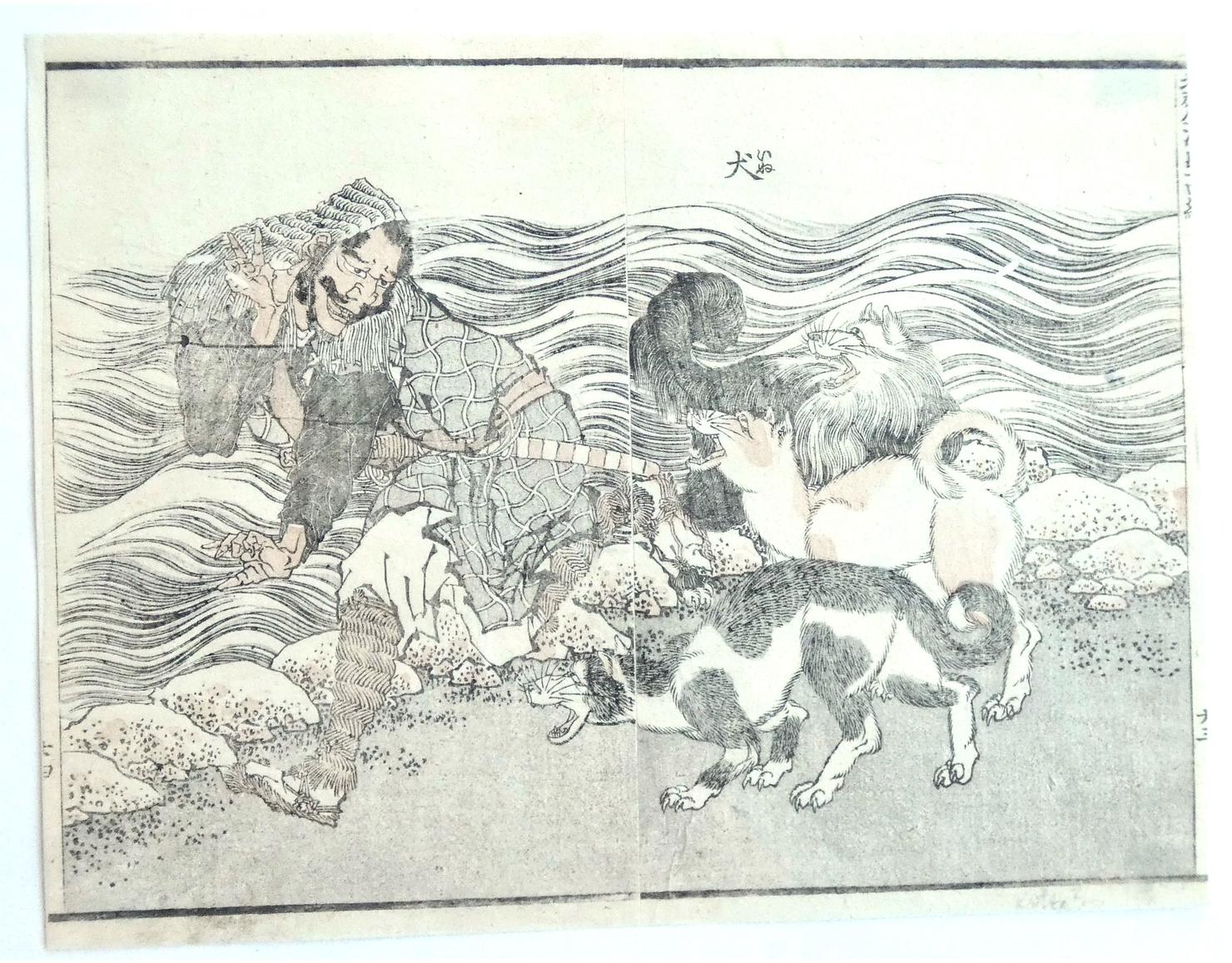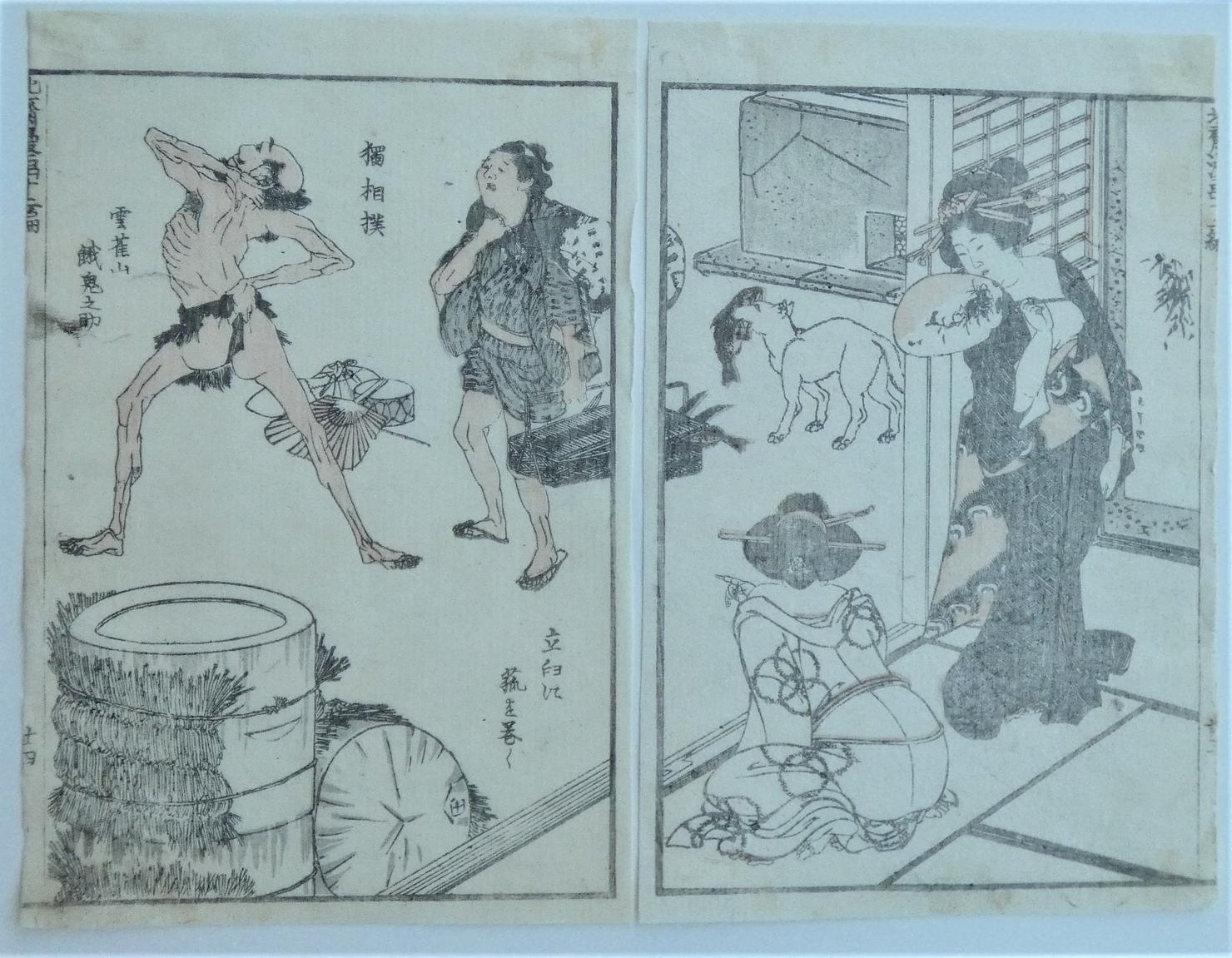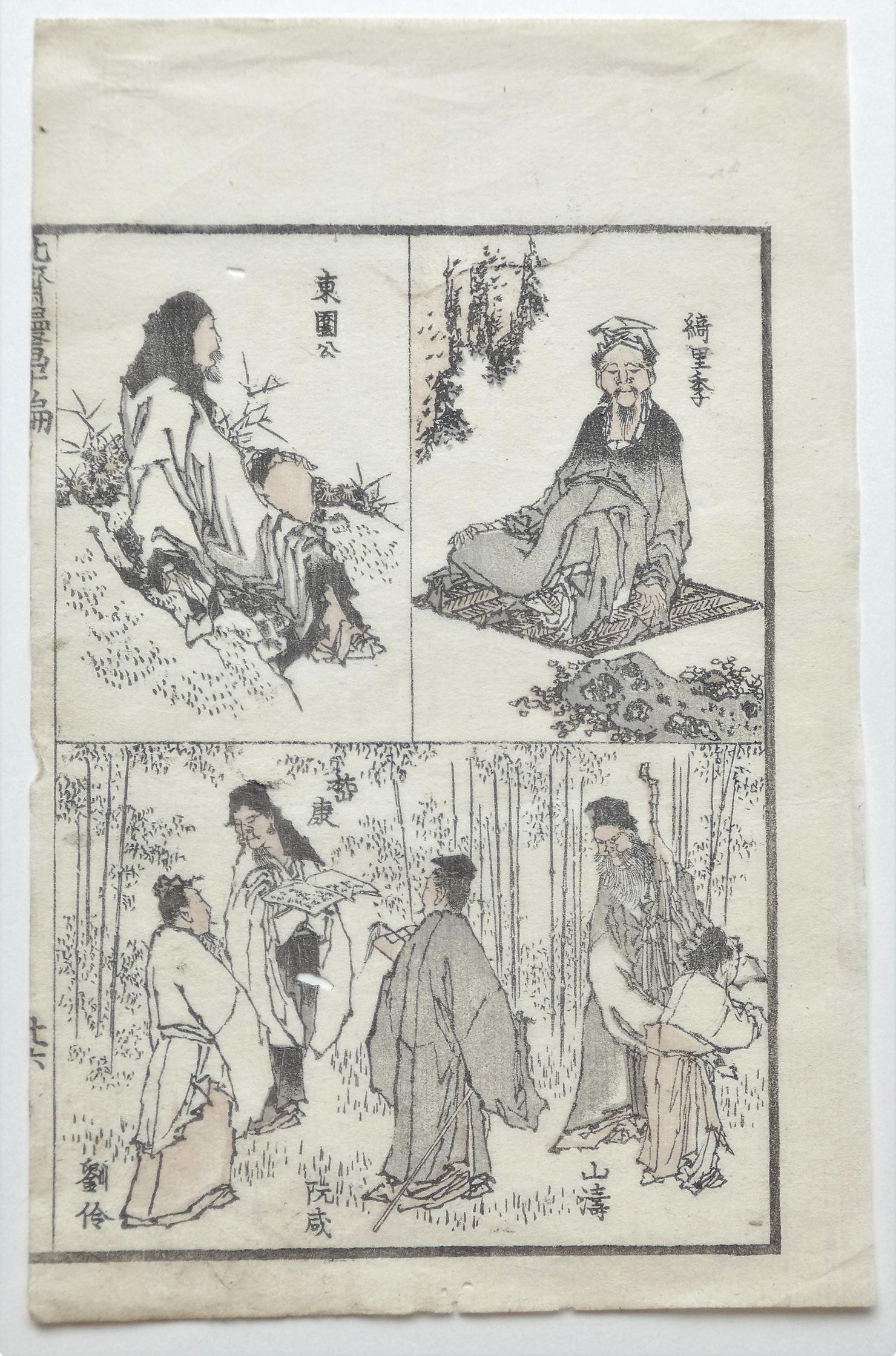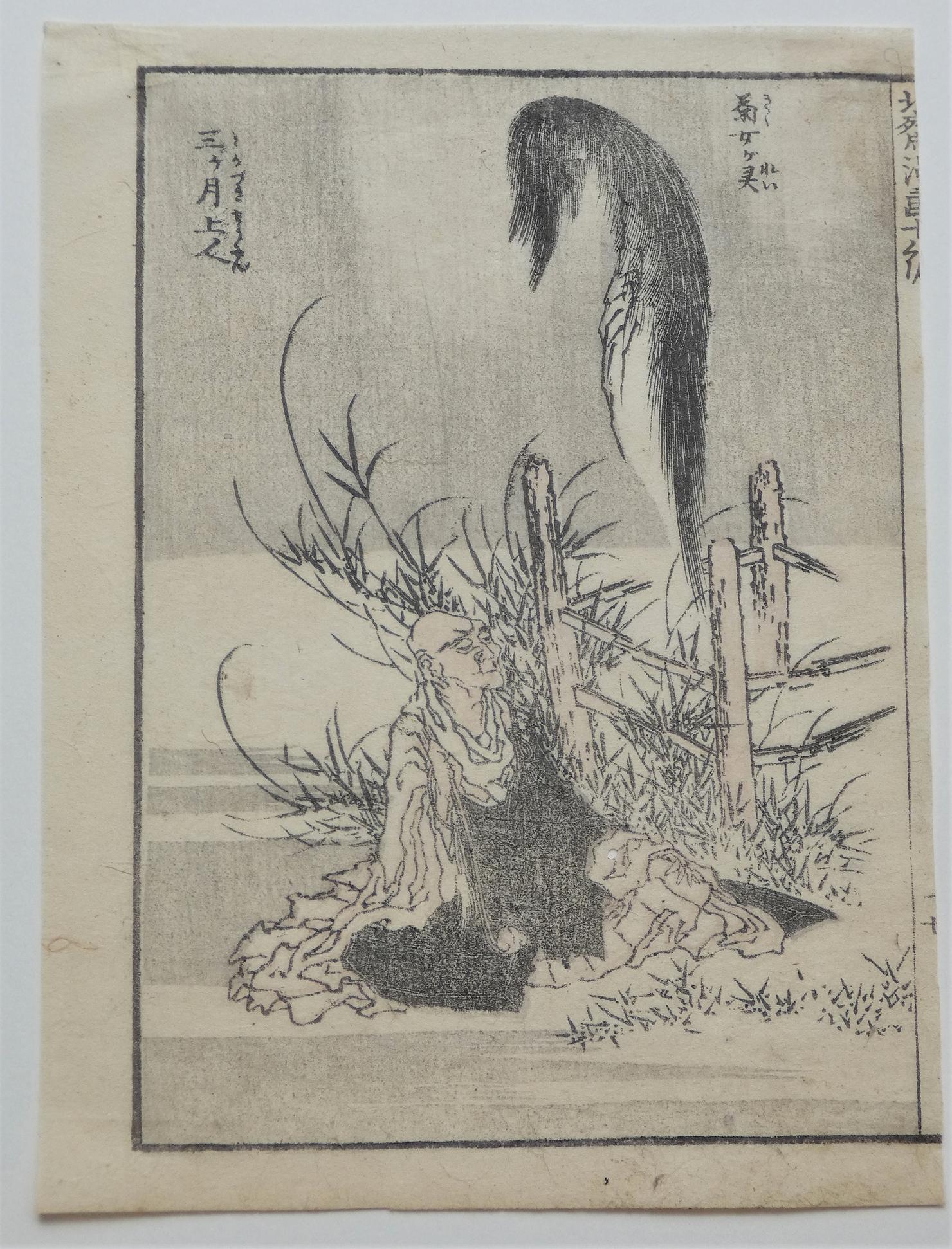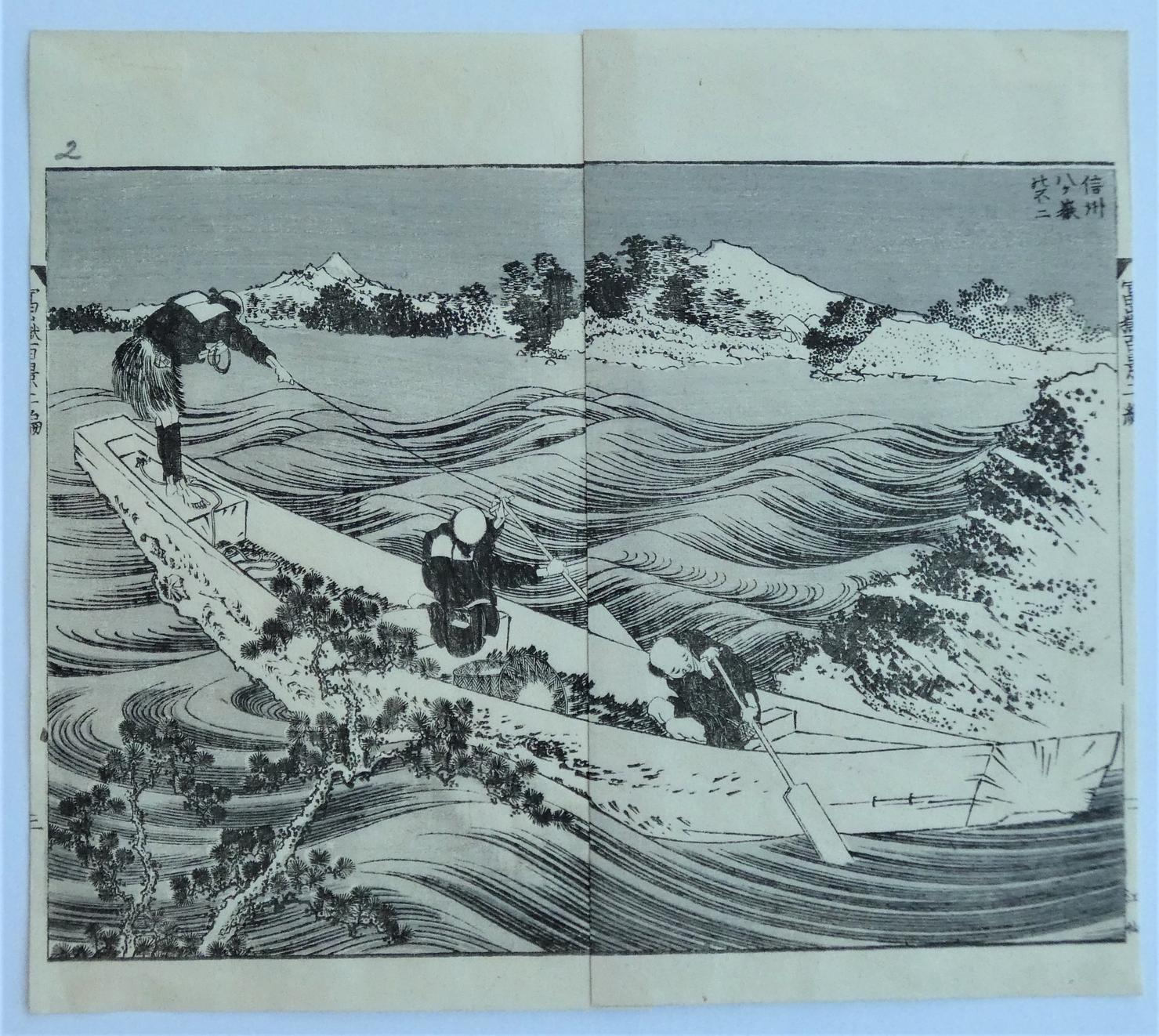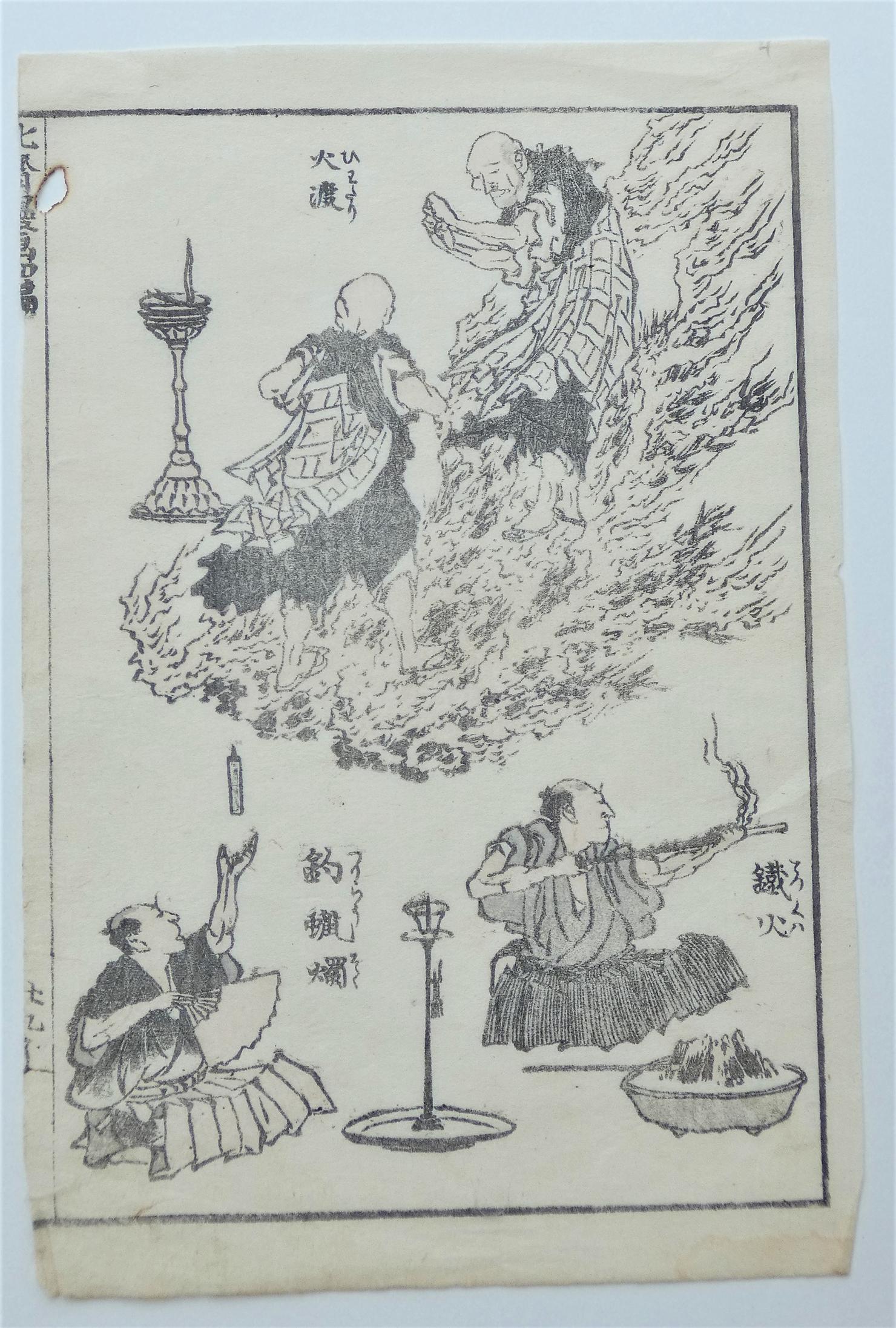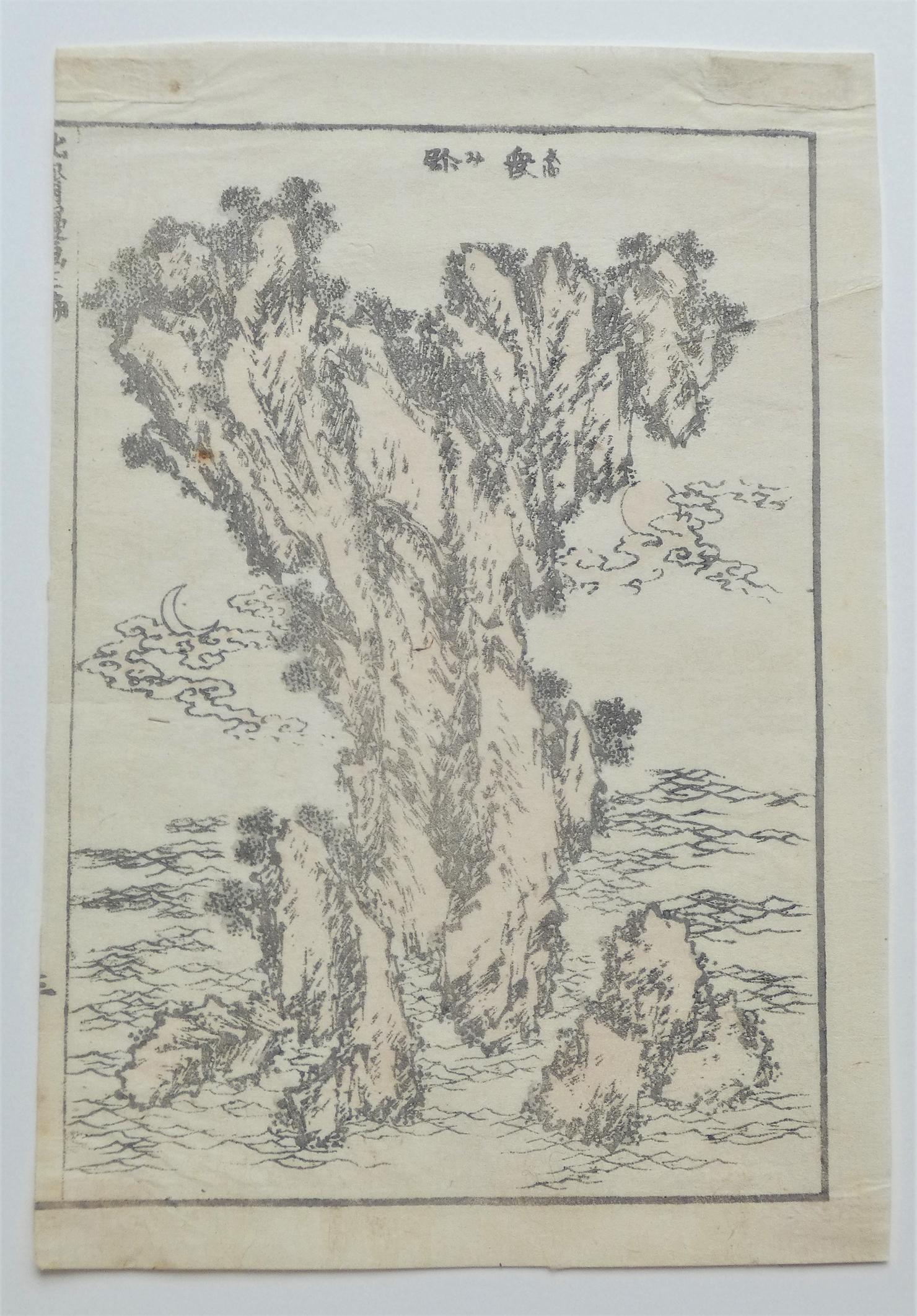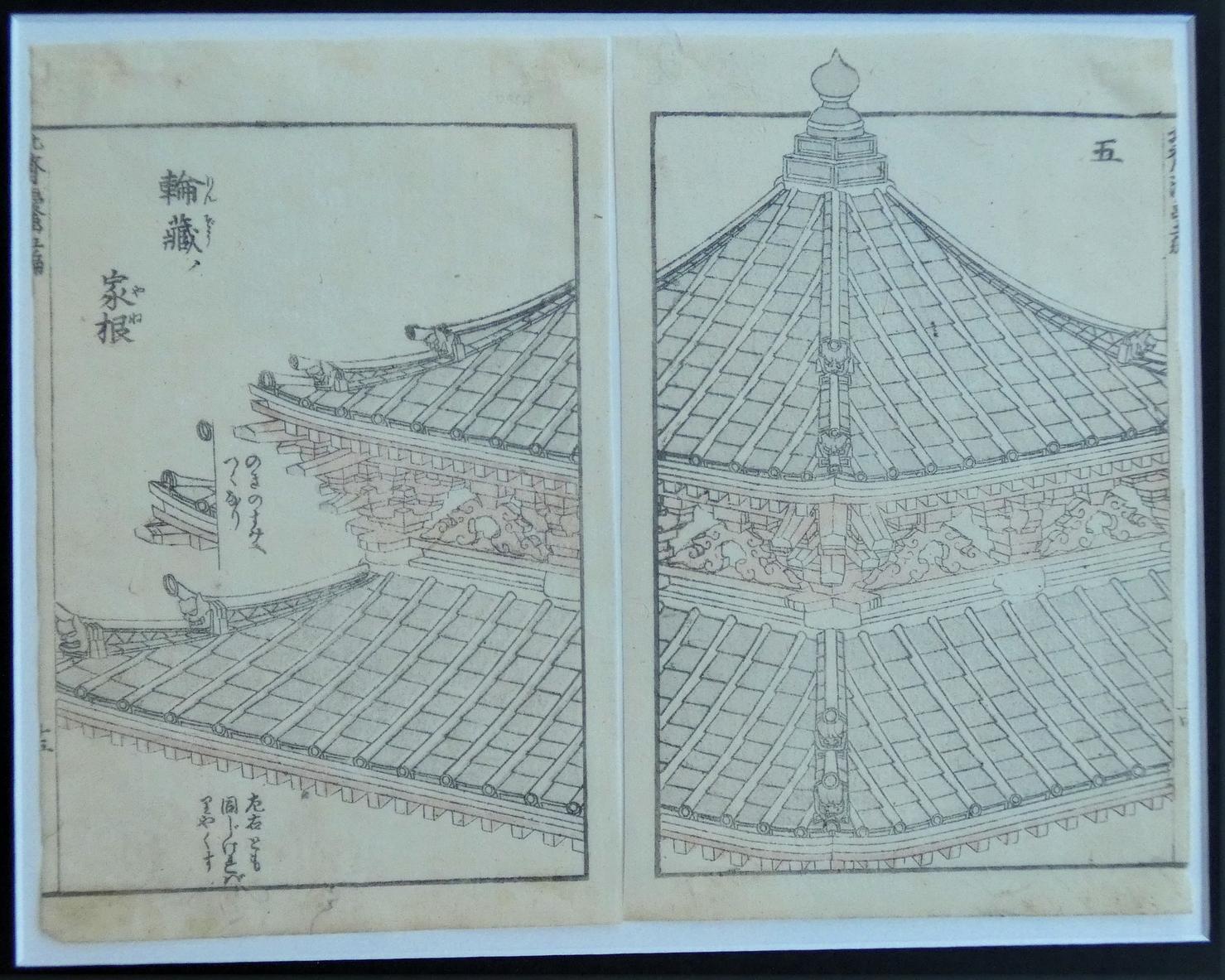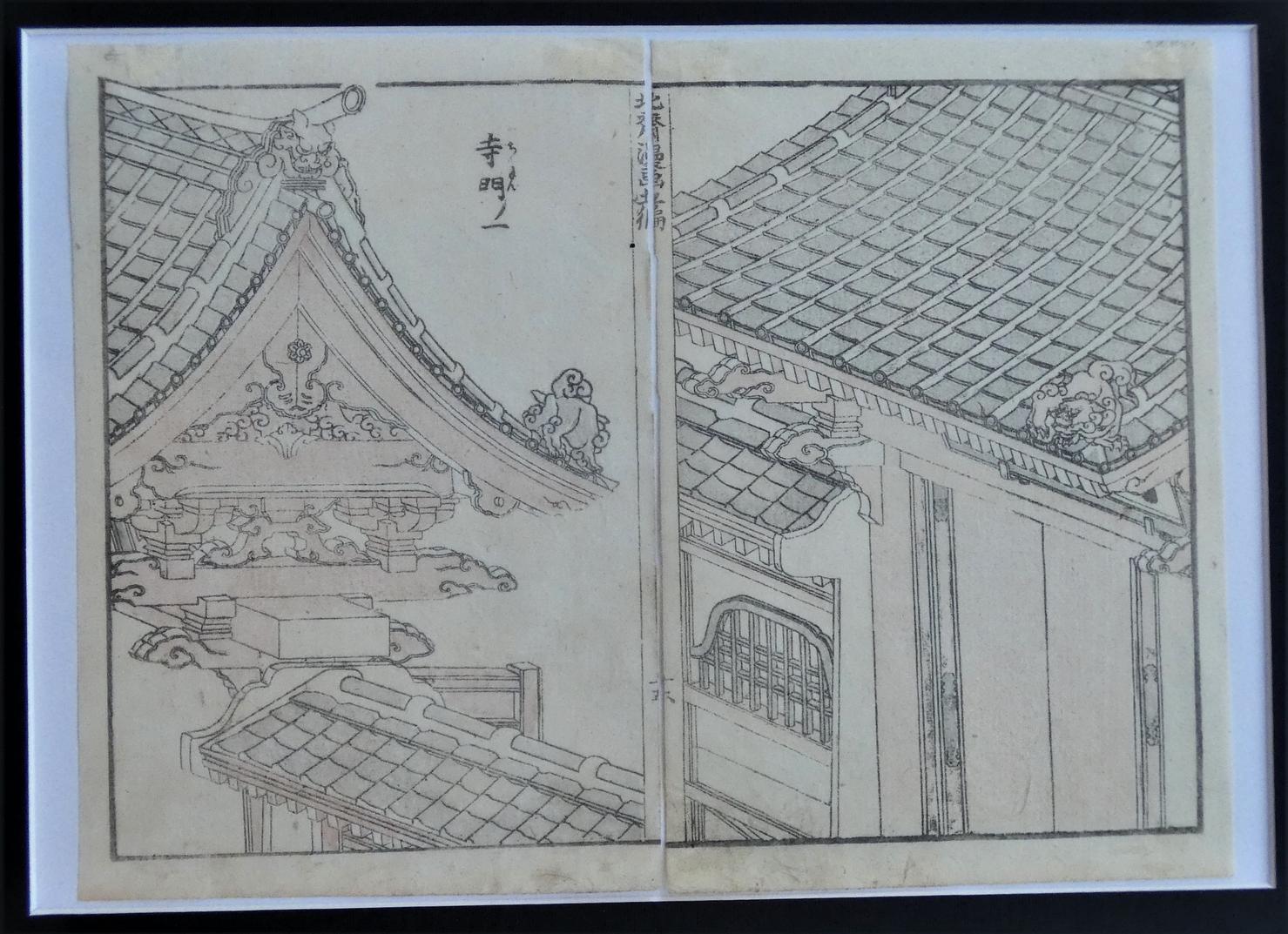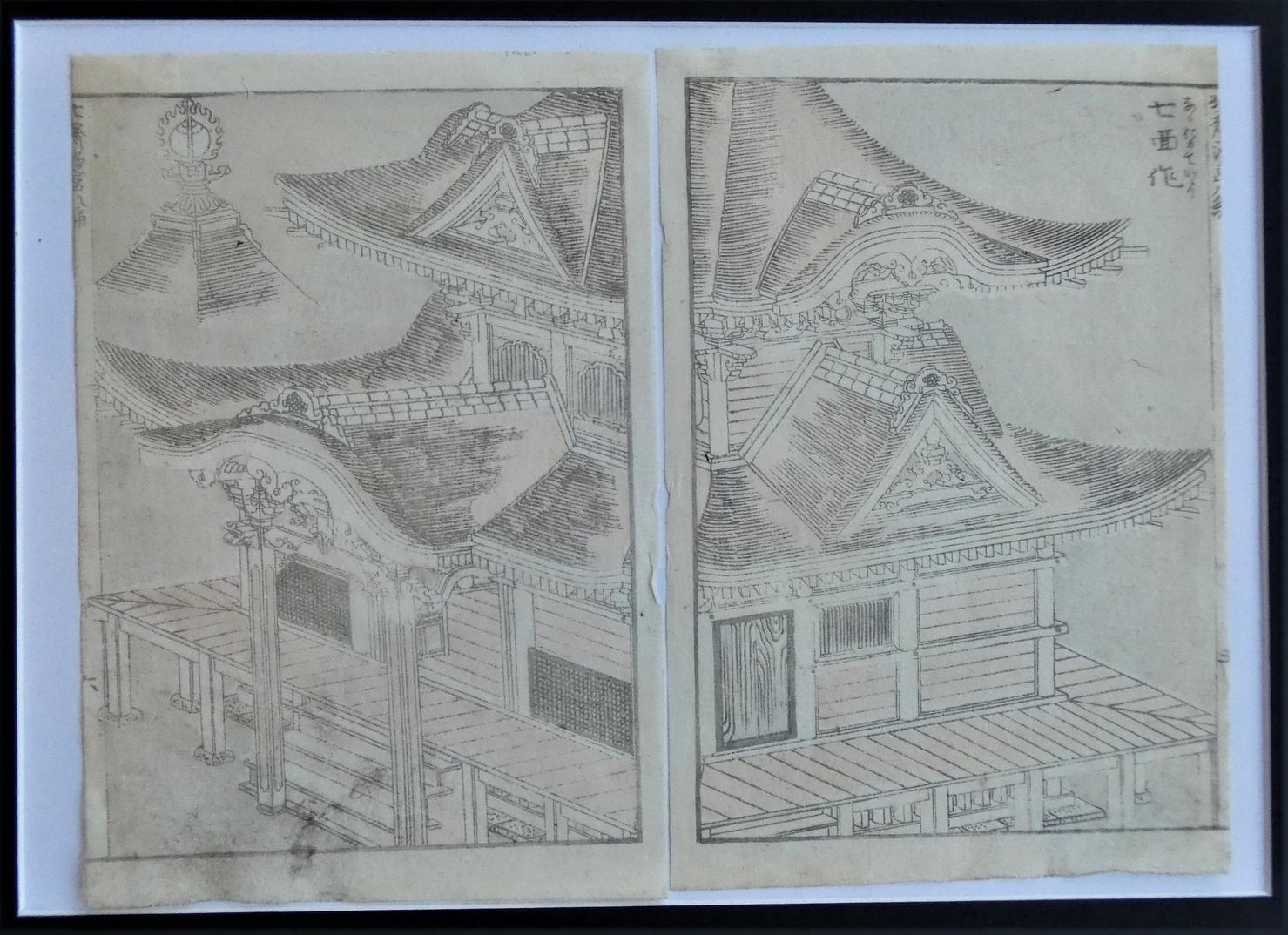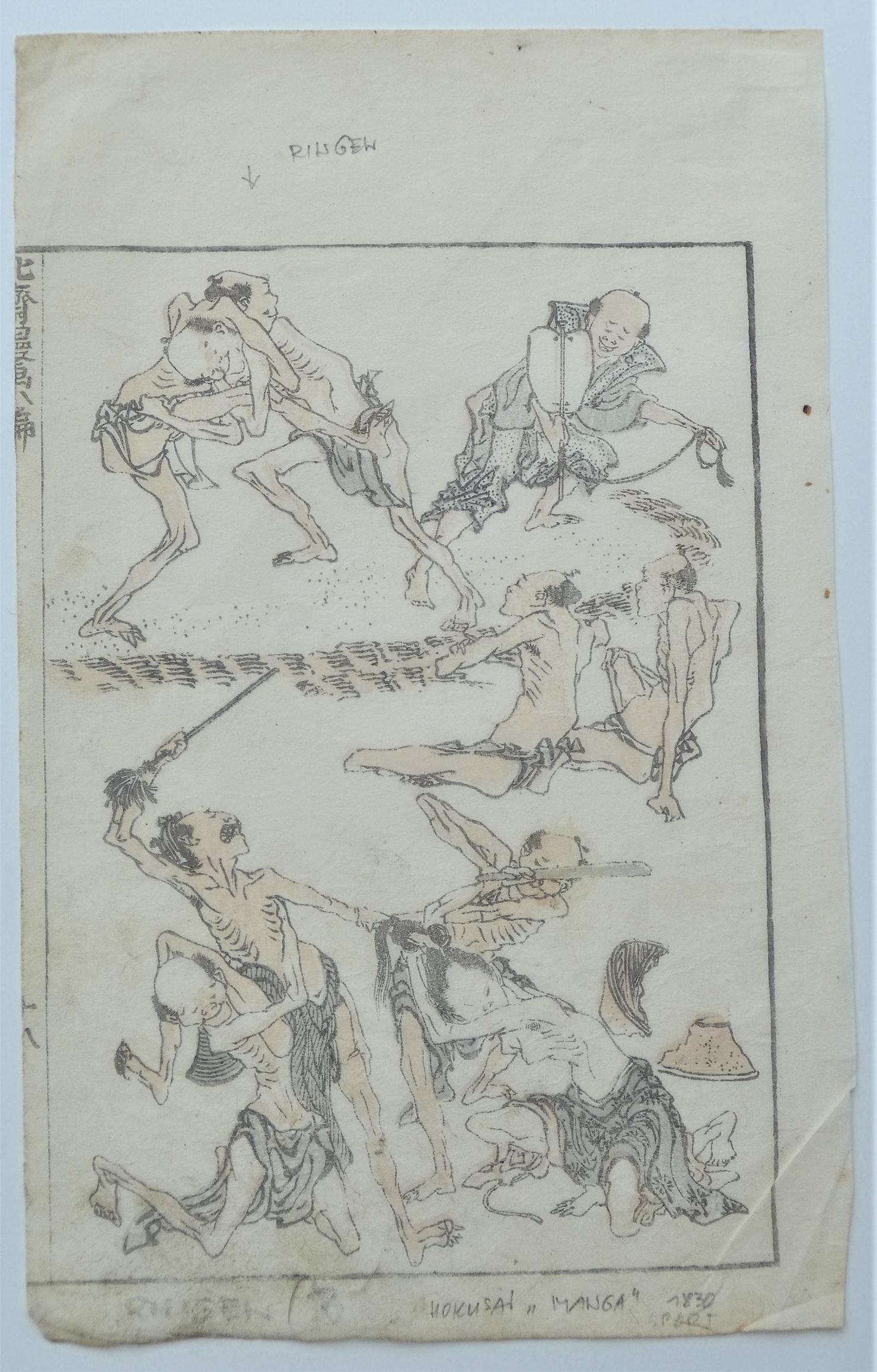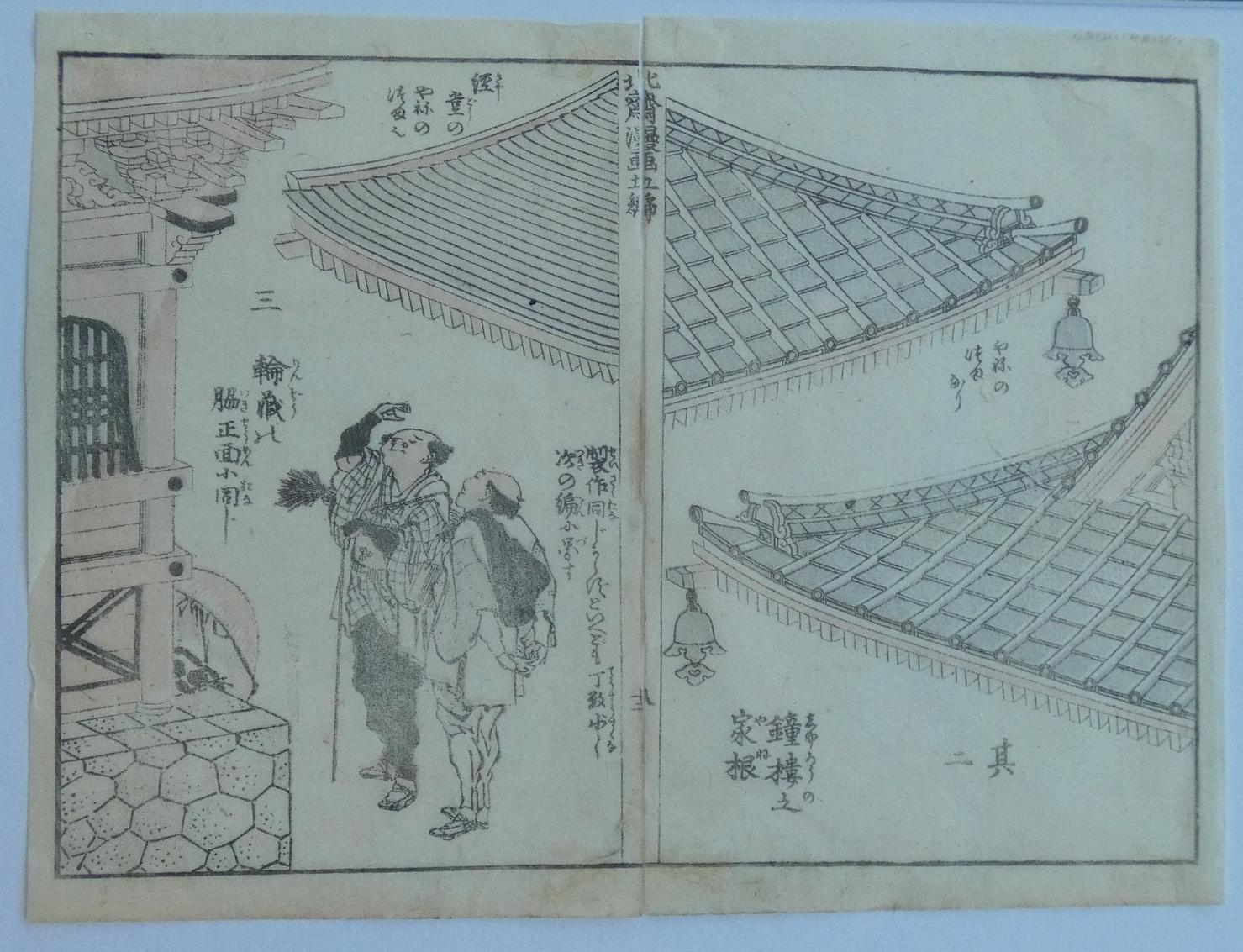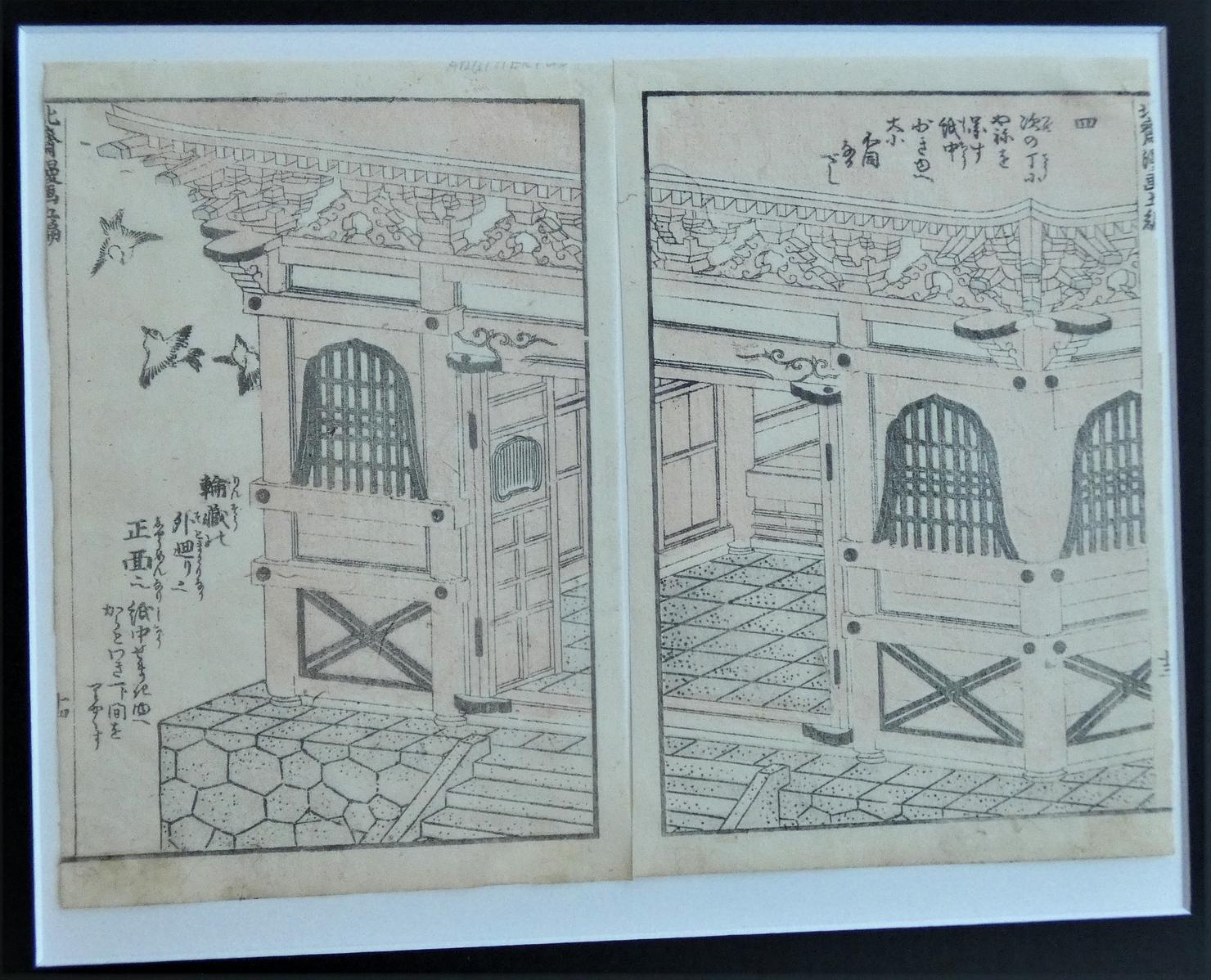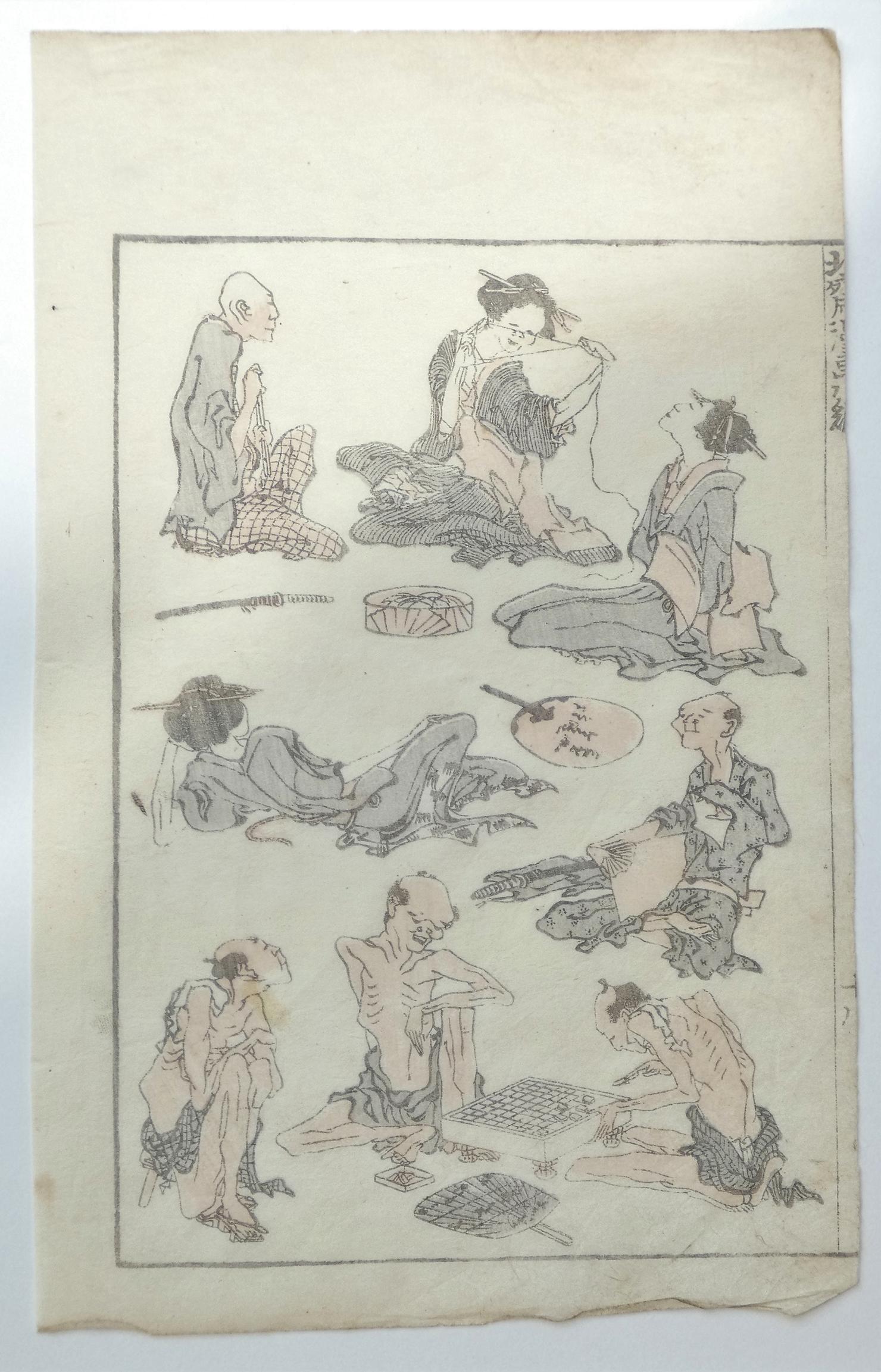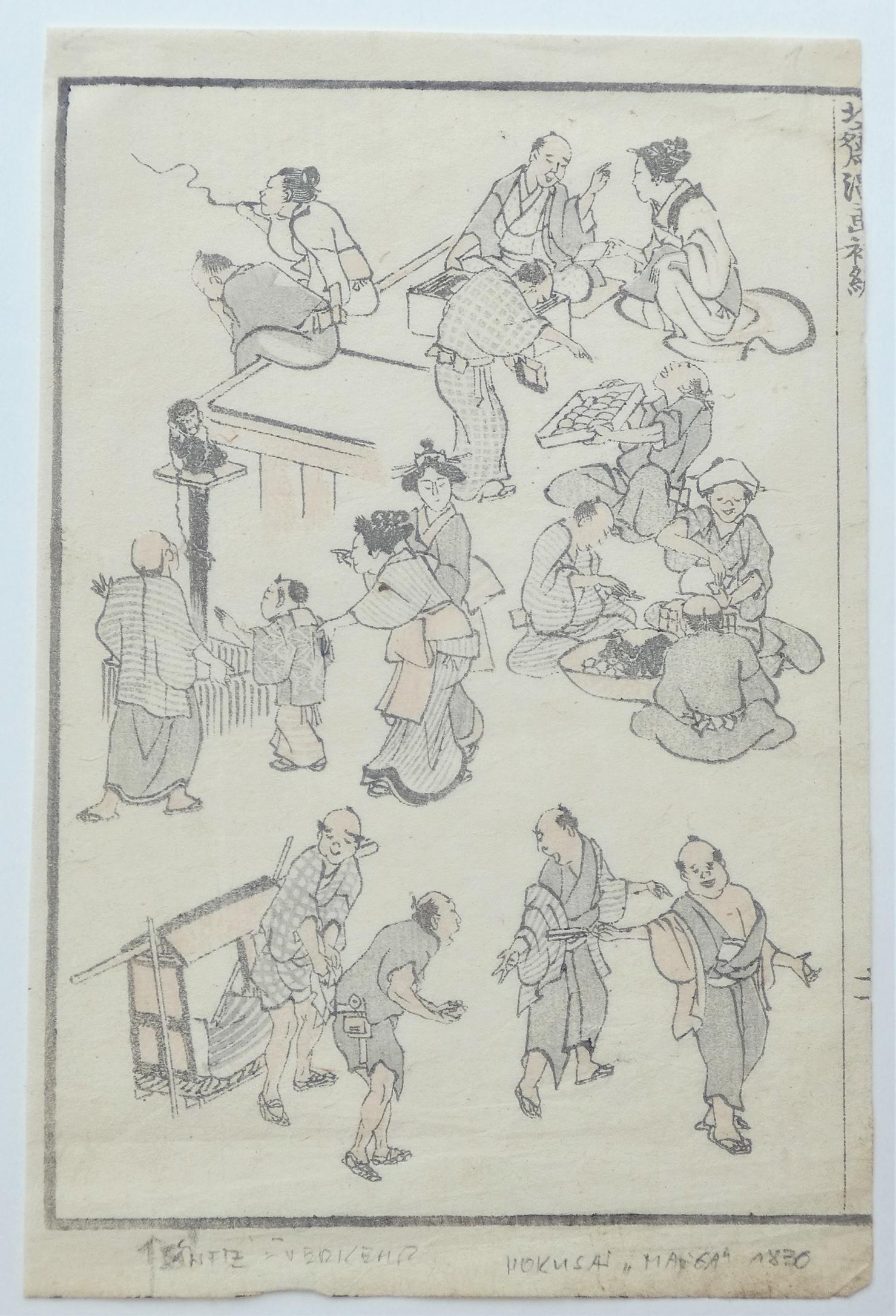Your enquiry email was sent successfully.
Your email was sent successfully.
Your favorites email was sent successfully.

Japanese woodcuts by Katsushika Hokusai; Imao Keinen and Kunichika Toyohara
Accompanying the exhibition "Made in Japan" at the Kunstmuseum Basel, which will run from 16 March to 21 July 2024:
Kunstmuseum Basel - Made in Japan – Kunstmuseum Basel
I am showing a selection of works by the following artists in Riehen, which will also be shown at the Kunstmuseum Basel:
Katsushika Hokusai popularised the term manga (roughly informal/unrestrained image), which is still used today for Japanese comics. His Hokusai mangas are sketches that were published between 1814 and 1878 in a total of 15 volumes (the last volume was published after his death in 1878. They do not tell coherent stories, but represent snapshots of Japanese society and culture during the late Edo period and depict the entire spectrum of human life.
Hokusai spent his entire life developing artistically. At the end of his life, he proudly described himself as a "farm labourer". On his deathbed, he is reported to have said: "If heaven had given me another five years, I would have become a great painter."
It must be recalled that the technique of Japanese prints is very close to the original design, since they affixed the drawing in ink on a piece of wood that the engraver was digging, following precisely the lines of the drawing itself, that was destroyed by this operation.
Hokusai spent his entire life developing artistically. At the end of his life, he proudly described himself as a "farm labourer". On his deathbed, he is reported to have said: "If heaven had given me another five years, I would have become a great painter."
The Hokusai Manga (北斎漫画, "Hokusai's Sketches") is a collection of sketches of various subjects by the Japanese artist Hokusai. Subjects of the sketches include landscapes, flora and fauna, everyday life and the supernatural.
The word manga in the title does not refer to the contemporary story-telling manga, as the sketches in the work are not connected to each other. While manga has come to mean "comics" in modern Japanese, the word was used in the Edo period to mean informal drawings, possibly preparatory sketches for paintings.
Block-printed in three colours (black, gray and pale flesh), the Hokusai Manga comprises thousands of images in ten volumes from 1814 to 1819, with five volumes added in 1834 to 1878. The first volume was published in 1814, when the artist was 55.
The final three volumes were published posthumously, two of them assembled by their publisher from previously unpublished material. The final volume was made up of previously published works, some not even by Hokusai, and is not considered authentic by art historians.
Publication history
The preface to the first volume of the work, written by Hanshū Sanjin (半洲散人), a minor artist of Nagoya, suggests that the publication of the work may have been aided by Hokusai's pupils. Part of the preface reads:
This autumn the master [Hokusai] happened to visit the Western Province and stopped over at our city [Nagoya]. We all met together with the painter Gekkōtei Bokusen (月光亭墨僊) [Utamasa II, well-known Nagoya artist, pupil of Hokusai’s, and collator of Hokusai’s later work] at the latter’s residence, it being a very joyous occasion. And there over three hundred sketches of all kinds were made – from immortals, Buddhas, scholars, and women on down to birds, beasts, grasses, and trees, the spirit of each captured fully by the brush.
The final volume is considered spurious by some art historians.
The initial publication is usually credited to Eirakuya Toshiro (永楽屋東四郎) of Nagoya[5] whose publishing house was renamed to Eito Shoten in 1914.
Sources of the Manga
Hokusai Manga depicting self-defense techniques (early 19th century)
The traditional view holds that, after the outburst of production, Hokusai carefully selected and redrew the sketches, arranging them into the patterns we see today. However, Michener (1958:30-34) argues that the pattern of the images on a particular plate were arranged by the wood carvers and publishers, not by the artist himself.
Legacy
The first volume of 'Manga' (Defined by Hokusai as 'Brush gone wild'), was an art instruction book published to aid his troubled finances. Shortly after he removed the text and republished it. The Manga show a dedication to artistic realism in the portrayal of people and the natural world. The work was an immediate success, and the subsequent volumes soon followed. The work became known to the West after Dutch-employed German physicist Philipp Franz von Siebold took lithographs of some of the sketches to Europe where they appeared in his influential book on Japan,[1] Nippon: Archiv Zur Beschreibung von Japon in 1832. The work began to circulate in the West soon after Matthew C. Perry's entry into Japan in 1854.
Katsushika Hokusai took the name Hokusai around 1798, when he was about 39 years old. This name is derived from two words: "Hoku", which means "north", and "sai", which refers to a meal offered to the Buddha. This name change coincided with an important transitional phase in his artistic career, which was characterised by the search for his own style and the exploration of different techniques and artistic influences. Under this new name, Hokusai became one of Japan's most famous artists and produced some of his best-known works, including the series "Thirty-six Views of Mount Fuji".
Katsushika Hokusai took the name Hokusai around 1798, when he was about 39 years old. This name is derived from two words: "Hoku", which means "north", and "sai", which refers to a meal offered to the Buddha. This name change coincided with an important transitional phase in his artistic career, which was characterised by the search for his own style and the exploration of different techniques and artistic influences. Under this new name, Hokusai became one of Japan's most famous artists and produced some of his best-known works, including the series "Thirty-six Views of Mount Fuji".
Quote: "At 73, I have roughly understood the structure of real nature, animals, grasses, trees, birds, fish and insects. Therefore, at 80, I will have made even more progress; at 90, I will penetrate the mystery of things; at 100, I will surely have become marvellous, and at 110, every point, every line will have a life of its own."
Toyohara Kunichika (Japanese 豊原 国周, real name: Arakawa Yasohachi (荒川 八十八), b. 30 June 1835 in Edo; d. 1 July 1900), Hōshunrō (豊春楼), Hōshunrō (米翁), Hōshunrō (豊春楼), Hōshunrō (米翁). July 1900) went by the artist names Beiō (米翁), Hōshunrō (豊春楼), Ichiōsai (一鶯斎), Kachōrō (華蝶楼), Shima Sanjin (志満山人) and Sōgenshi (豊玄子). He was a Japanese painter in the Ukiyoe style during the Meiji period and, together with Tsukioka Yoshitoshi and Kobayashi Kiyochika, was one of the "Three Outstanding [Artists]" (三傑, Sanketsu) of their style at the end of the 19th century.
Toyohara Kunichika (Japanese: 豊原 国周; 30 June 1835 – 1 July 1900) was a Japanese woodblock print artist. Talented as a child, at about thirteen he became a student of Tokyo's then-leading print maker, Utagawa Kunisada. His deep appreciation and knowledge of kabuki drama led to his production primarily of yakusha-e, which are woodblock prints of kabuki actors and scenes from popular plays of the time.
An alcoholic and womanizer, Kunichika also portrayed women deemed beautiful (bijinga), contemporary social life, and a few landscapes and historical scenes. He worked successfully in the Edo period, and carried those traditions into the Meiji period. To his contemporaries and now to some modern art historians, this has been seen as a significant achievement during a transitional period of great social and political change in Japan's history
At the time Kunichika began his serious studies the late Edo period, an extension of traditions based on a feudal society, was about to end. The "modern" Meiji era (1868–1912), a time of rapid modernization, industrialization, and extensive contact with the West, was in stark contrast to what had come before.
Ukiyo-e artists had traditionally illustrated urban life and society – especially the theater, for which their prints often served as advertising. The Meiji period brought competition from the new technologies of photography and photoengraving, effectively destroying the careers of most.
As Kunichika matured his reputation as a master of design and of drama grew steadily. In guides rating ukiyo-e artists his name appeared in the top ten in 1865, 1867, and 1885, when he was in eighth, fifth, and fourth place, respectively.[9] In 1867, one year before the collapse of the Tokugawa Shogunate, he received an official commission by the government to contribute ten pictures to the 1867 World Exhibition in Paris. He also had a print at the 1893 World's Columbian Exposition in Chicago.
Kunichika often portrayed beautiful women (bijinga), but his finest works are considered to have been bust, half- and three-quarter length, and close-up or "large-head" portraits of actors, and triptychs that presented "wide-screen" views of plays and popular stories.
Although Kunichika's Meiji-era works remained rooted in the traditions of his teachers, he made an effort to incorporate references to modern technology. In 1869 he did a series jointly with Yoshitoshi, a more "modern" artist in the sense that he depicted faces realistically. In addition, Kunichika experimented with "Western" vanishing point perspective.
The press affirmed that Kunichika's success continued into the Meiji era. In July 1874, the magazine Shinbun hentai said that: "Color woodcuts are one of the specialties of Tokyo, and that Kyôsai, Yoshitoshi, Yoshiiku, Kunichika, and Ginkô are the experts in this area." In September 1874 The same journal held that: "The masters of Ukiyoe: Yoshiiku, Kunichika and Yoshitoshi. They are the most popular Ukiyo-e artists." In 1890, the book Tôkyô meishô doku annai (Famous Views of Tokyo), under the heading of woodblock artist, gave as examples Kunichika, Kunisada, Yoshiiku, and Yoshitoshi. In November 1890 a reporter for the newspaper Yomiuri Shimbun wrote about the specializations of artists of the Utagawa school: "Yoshitoshi was the specialist for warrior prints, Kunichika the woodblock artist known for portraits of actors, and Chikanobu for court ladies."
Contemporary observers noted Kunichika's skillful use of color in his actor prints, but he was also criticized for his choices. Unlike most artists of the period, he made use of strong reds and dark purples, often as background colors, rather than the softer colors that had previously been used. These new colors were made of aniline dyes imported in the Meiji period from Germany. (For the Japanese the color red meant progress and enlightenment in the new era of Western-style progress.)
Like most artists of his era and genre, Kunichika created many series of prints, including: Yoshiwara beauties compared with thirty-six poems; Thirty-two fashionable physiognomies; Sixteen Musashi parodying modern customs; Thirty-six good and evil beauties; Thirty-six modern restaurants; Mirror of the flowering of manners and customs; Fifty-four modern feelings matched with chapters of The Tale of Genji; Scenes of the twenty-four hours parodied; Actors in theatrical hits as great heroes in robber plays; Eight views of bandits parodied.
In 1863 Kunichika was one of a number of artists who contributed landscape prints to two series of famous Tokaido scenes commissioned to commemorate the journey made by the shōgun Iemochi from Edo to Kyoto to pay his respects to the emperor. Otherwise, his landscapes were primarily theater sets, or backgrounds for groups of beauties enjoying the out-of-doors. He recorded some popular myths and tales, but rarely illustrated battles. When portraying people he only occasionally showed figures wearing Western dress, despite its growing popularity in Japan. He is known to have done some shunga (erotic art) prints but attribution can be difficult as, like most artists of the time, he did not always sign them. Kunichika had many students but few attained recognition as print artists. In the changing art scene they could not support themselves designing woodblock prints, but had to make illustrations for such popular media as books, magazines and newspapers. His best-known students were Toyohara Chikanobu and Morikawa Chikashige. Both initially followed their master's interest in theater, but later Chikanobu more enthusiastically portrayed women's fashions, and Chikashige did illustrations. Neither is considered by critics to have achieved his master's high reputation.
Kunichika had one female student, Toyohara Chikayoshi, who reportedly became his partner in his later years. Her work reflected the Utagawa style. She competently depicted actors, and the manners and customs of the day.
Imao Keinen was born as the third son of Imao Inosuke (今尾 猪助). The family ran a shop called Iseya (伊勢谷) and was on friendly terms with the Mitsui family's clothing business. Initially, Keinen created preliminary drawings for a type of stencil printing on textiles for the Yūsen-some[A 1]. At the age of 11, he became a pupil of the ukiyo-e artist Umegawa Tōkyo (梅川東居), who in turn had learnt from Umegawa Tōnan (梅川東南), who had apparently studied engraving. Three years later, Keinen continued his training under Suzuki Hyakunen (1828-1891), who taught him the style of the Maruyama Shijō school. Keinen then adopted the nen from Hyakunen and the kei from Matsumura Keibun, whom he admired.
Keinen explored various styles and then focussed primarily on the classical flower-and-bird theme (花鳥画, Kachō-ga), whereby he developed into the leading representative of the more conservative style of painting. In 1895, his painting Yabakei "耶馬渓図" was honoured at the 4th "Exhibition for the Promotion of Domestic Trade and Industry" (内国勧業博覧会, Kokunai kangyō hakurankai).
Together with Suzuki Shōnen (鈴木松年; 1848-1918), son of Hyakunen, Keinen occupied a leading position in Kyōto's artistic circles. In 1895, he co-founded the "如雲社" (Nyounsha), the later "京都後素協会" (Kyōto kōso kyōkai), of which he became chairman. In 1919, he became a member of the Imperial Academy of Arts (帝国術術院, Teikoku Geijutsuin). In 1891, four volumes were published with the title "景年花鳥画譜" (Keinen kachō gafu, picture collection of flowers and birds of Keinen). Keinen was also exhibited at the Paris World's Fair in 1889 and the World's Columbian Exposition in Chicago in 1893.
The word manga in the title does not refer to the contemporary story-telling manga, as the sketches in the work are not connected to each other. While manga has come to mean "comics" in modern Japanese, the word was used in the Edo period to mean informal drawings, possibly preparatory sketches for paintings.
Block-printed in three colours (black, gray and pale flesh), the Hokusai Manga comprises thousands of images in ten volumes from 1814 to 1819, with five volumes added in 1834 to 1878. The first volume was published in 1814, when the artist was 55.
The final three volumes were published posthumously, two of them assembled by their publisher from previously unpublished material. The final volume was made up of previously published works, some not even by Hokusai, and is not considered authentic by art historians.
Publication history
The preface to the first volume of the work, written by Hanshū Sanjin (半洲散人), a minor artist of Nagoya, suggests that the publication of the work may have been aided by Hokusai's pupils. Part of the preface reads:
This autumn the master [Hokusai] happened to visit the Western Province and stopped over at our city [Nagoya]. We all met together with the painter Gekkōtei Bokusen (月光亭墨僊) [Utamasa II, well-known Nagoya artist, pupil of Hokusai’s, and collator of Hokusai’s later work] at the latter’s residence, it being a very joyous occasion. And there over three hundred sketches of all kinds were made – from immortals, Buddhas, scholars, and women on down to birds, beasts, grasses, and trees, the spirit of each captured fully by the brush.
The final volume is considered spurious by some art historians.
The initial publication is usually credited to Eirakuya Toshiro (永楽屋東四郎) of Nagoya[5] whose publishing house was renamed to Eito Shoten in 1914.
Sources of the Manga
Hokusai Manga depicting self-defense techniques (early 19th century)
The traditional view holds that, after the outburst of production, Hokusai carefully selected and redrew the sketches, arranging them into the patterns we see today. However, Michener (1958:30-34) argues that the pattern of the images on a particular plate were arranged by the wood carvers and publishers, not by the artist himself.
Legacy
The first volume of 'Manga' (Defined by Hokusai as 'Brush gone wild'), was an art instruction book published to aid his troubled finances. Shortly after he removed the text and republished it. The Manga show a dedication to artistic realism in the portrayal of people and the natural world. The work was an immediate success, and the subsequent volumes soon followed. The work became known to the West after Dutch-employed German physicist Philipp Franz von Siebold took lithographs of some of the sketches to Europe where they appeared in his influential book on Japan,[1] Nippon: Archiv Zur Beschreibung von Japon in 1832. The work began to circulate in the West soon after Matthew C. Perry's entry into Japan in 1854.
The word manga in the title does not refer to the contemporary story-telling manga, as the sketches in the work are not connected to each other. While manga has come to mean "comics" in modern Japanese, the word was used in the Edo period to mean informal drawings, possibly preparatory sketches for paintings.
Block-printed in three colours (black, gray and pale flesh), the Hokusai Manga comprises thousands of images in ten volumes from 1814 to 1819, with five volumes added in 1834 to 1878. The first volume was published in 1814, when the artist was 55.
The final three volumes were published posthumously, two of them assembled by their publisher from previously unpublished material. The final volume was made up of previously published works, some not even by Hokusai, and is not considered authentic by art historians.
Publication history
The preface to the first volume of the work, written by Hanshū Sanjin (半洲散人), a minor artist of Nagoya, suggests that the publication of the work may have been aided by Hokusai's pupils. Part of the preface reads:
This autumn the master [Hokusai] happened to visit the Western Province and stopped over at our city [Nagoya]. We all met together with the painter Gekkōtei Bokusen (月光亭墨僊) [Utamasa II, well-known Nagoya artist, pupil of Hokusai’s, and collator of Hokusai’s later work] at the latter’s residence, it being a very joyous occasion. And there over three hundred sketches of all kinds were made – from immortals, Buddhas, scholars, and women on down to birds, beasts, grasses, and trees, the spirit of each captured fully by the brush.
The final volume is considered spurious by some art historians.
The initial publication is usually credited to Eirakuya Toshiro (永楽屋東四郎) of Nagoya[5] whose publishing house was renamed to Eito Shoten in 1914.
Sources of the Manga
Hokusai Manga depicting self-defense techniques (early 19th century)
The traditional view holds that, after the outburst of production, Hokusai carefully selected and redrew the sketches, arranging them into the patterns we see today. However, Michener (1958:30-34) argues that the pattern of the images on a particular plate were arranged by the wood carvers and publishers, not by the artist himself.
Legacy
The first volume of 'Manga' (Defined by Hokusai as 'Brush gone wild'), was an art instruction book published to aid his troubled finances. Shortly after he removed the text and republished it. The Manga show a dedication to artistic realism in the portrayal of people and the natural world. The work was an immediate success, and the subsequent volumes soon followed. The work became known to the West after Dutch-employed German physicist Philipp Franz von Siebold took lithographs of some of the sketches to Europe where they appeared in his influential book on Japan,[1] Nippon: Archiv Zur Beschreibung von Japon in 1832. The work began to circulate in the West soon after Matthew C. Perry's entry into Japan in 1854.
The word manga in the title does not refer to the contemporary story-telling manga, as the sketches in the work are not connected to each other. While manga has come to mean "comics" in modern Japanese, the word was used in the Edo period to mean informal drawings, possibly preparatory sketches for paintings.
Block-printed in three colours (black, gray and pale flesh), the Hokusai Manga comprises thousands of images in ten volumes from 1814 to 1819, with five volumes added in 1834 to 1878. The first volume was published in 1814, when the artist was 55.
The final three volumes were published posthumously, two of them assembled by their publisher from previously unpublished material. The final volume was made up of previously published works, some not even by Hokusai, and is not considered authentic by art historians.
Publication history
The preface to the first volume of the work, written by Hanshū Sanjin (半洲散人), a minor artist of Nagoya, suggests that the publication of the work may have been aided by Hokusai's pupils. Part of the preface reads:
This autumn the master [Hokusai] happened to visit the Western Province and stopped over at our city [Nagoya]. We all met together with the painter Gekkōtei Bokusen (月光亭墨僊) [Utamasa II, well-known Nagoya artist, pupil of Hokusai’s, and collator of Hokusai’s later work] at the latter’s residence, it being a very joyous occasion. And there over three hundred sketches of all kinds were made – from immortals, Buddhas, scholars, and women on down to birds, beasts, grasses, and trees, the spirit of each captured fully by the brush.
The final volume is considered spurious by some art historians.
The initial publication is usually credited to Eirakuya Toshiro (永楽屋東四郎) of Nagoya[5] whose publishing house was renamed to Eito Shoten in 1914.
Sources of the Manga
Hokusai Manga depicting self-defense techniques (early 19th century)
The traditional view holds that, after the outburst of production, Hokusai carefully selected and redrew the sketches, arranging them into the patterns we see today. However, Michener (1958:30-34) argues that the pattern of the images on a particular plate were arranged by the wood carvers and publishers, not by the artist himself.
Legacy
The first volume of 'Manga' (Defined by Hokusai as 'Brush gone wild'), was an art instruction book published to aid his troubled finances. Shortly after he removed the text and republished it. The Manga show a dedication to artistic realism in the portrayal of people and the natural world. The work was an immediate success, and the subsequent volumes soon followed. The work became known to the West after Dutch-employed German physicist Philipp Franz von Siebold took lithographs of some of the sketches to Europe where they appeared in his influential book on Japan,[1] Nippon: Archiv Zur Beschreibung von Japon in 1832. The work began to circulate in the West soon after Matthew C. Perry's entry into Japan in 1854.
The word manga in the title does not refer to the contemporary story-telling manga, as the sketches in the work are not connected to each other. While manga has come to mean "comics" in modern Japanese, the word was used in the Edo period to mean informal drawings, possibly preparatory sketches for paintings.
Block-printed in three colours (black, gray and pale flesh), the Hokusai Manga comprises thousands of images in ten volumes from 1814 to 1819, with five volumes added in 1834 to 1878. The first volume was published in 1814, when the artist was 55.
The final three volumes were published posthumously, two of them assembled by their publisher from previously unpublished material. The final volume was made up of previously published works, some not even by Hokusai, and is not considered authentic by art historians.
Publication history
The preface to the first volume of the work, written by Hanshū Sanjin (半洲散人), a minor artist of Nagoya, suggests that the publication of the work may have been aided by Hokusai's pupils. Part of the preface reads:
This autumn the master [Hokusai] happened to visit the Western Province and stopped over at our city [Nagoya]. We all met together with the painter Gekkōtei Bokusen (月光亭墨僊) [Utamasa II, well-known Nagoya artist, pupil of Hokusai’s, and collator of Hokusai’s later work] at the latter’s residence, it being a very joyous occasion. And there over three hundred sketches of all kinds were made – from immortals, Buddhas, scholars, and women on down to birds, beasts, grasses, and trees, the spirit of each captured fully by the brush.
The final volume is considered spurious by some art historians.
The initial publication is usually credited to Eirakuya Toshiro (永楽屋東四郎) of Nagoya[5] whose publishing house was renamed to Eito Shoten in 1914.
Sources of the Manga
Hokusai Manga depicting self-defense techniques (early 19th century)
The traditional view holds that, after the outburst of production, Hokusai carefully selected and redrew the sketches, arranging them into the patterns we see today. However, Michener (1958:30-34) argues that the pattern of the images on a particular plate were arranged by the wood carvers and publishers, not by the artist himself.
Legacy
The first volume of 'Manga' (Defined by Hokusai as 'Brush gone wild'), was an art instruction book published to aid his troubled finances. Shortly after he removed the text and republished it. The Manga show a dedication to artistic realism in the portrayal of people and the natural world. The work was an immediate success, and the subsequent volumes soon followed. The work became known to the West after Dutch-employed German physicist Philipp Franz von Siebold took lithographs of some of the sketches to Europe where they appeared in his influential book on Japan,[1] Nippon: Archiv Zur Beschreibung von Japon in 1832. The work began to circulate in the West soon after Matthew C. Perry's entry into Japan in 1854.
The word manga in the title does not refer to the contemporary story-telling manga, as the sketches in the work are not connected to each other. While manga has come to mean "comics" in modern Japanese, the word was used in the Edo period to mean informal drawings, possibly preparatory sketches for paintings.
Block-printed in three colours (black, gray and pale flesh), the Hokusai Manga comprises thousands of images in ten volumes from 1814 to 1819, with five volumes added in 1834 to 1878. The first volume was published in 1814, when the artist was 55.
The final three volumes were published posthumously, two of them assembled by their publisher from previously unpublished material. The final volume was made up of previously published works, some not even by Hokusai, and is not considered authentic by art historians.
Publication history
The preface to the first volume of the work, written by Hanshū Sanjin (半洲散人), a minor artist of Nagoya, suggests that the publication of the work may have been aided by Hokusai's pupils. Part of the preface reads:
This autumn the master [Hokusai] happened to visit the Western Province and stopped over at our city [Nagoya]. We all met together with the painter Gekkōtei Bokusen (月光亭墨僊) [Utamasa II, well-known Nagoya artist, pupil of Hokusai’s, and collator of Hokusai’s later work] at the latter’s residence, it being a very joyous occasion. And there over three hundred sketches of all kinds were made – from immortals, Buddhas, scholars, and women on down to birds, beasts, grasses, and trees, the spirit of each captured fully by the brush.
The final volume is considered spurious by some art historians.
The initial publication is usually credited to Eirakuya Toshiro (永楽屋東四郎) of Nagoya[5] whose publishing house was renamed to Eito Shoten in 1914.
Sources of the Manga
Hokusai Manga depicting self-defense techniques (early 19th century)
The traditional view holds that, after the outburst of production, Hokusai carefully selected and redrew the sketches, arranging them into the patterns we see today. However, Michener (1958:30-34) argues that the pattern of the images on a particular plate were arranged by the wood carvers and publishers, not by the artist himself.
Legacy
The first volume of 'Manga' (Defined by Hokusai as 'Brush gone wild'), was an art instruction book published to aid his troubled finances. Shortly after he removed the text and republished it. The Manga show a dedication to artistic realism in the portrayal of people and the natural world. The work was an immediate success, and the subsequent volumes soon followed. The work became known to the West after Dutch-employed German physicist Philipp Franz von Siebold took lithographs of some of the sketches to Europe where they appeared in his influential book on Japan,[1] Nippon: Archiv Zur Beschreibung von Japon in 1832. The work began to circulate in the West soon after Matthew C. Perry's entry into Japan in 1854.
The word manga in the title does not refer to the contemporary story-telling manga, as the sketches in the work are not connected to each other. While manga has come to mean "comics" in modern Japanese, the word was used in the Edo period to mean informal drawings, possibly preparatory sketches for paintings.
Block-printed in three colours (black, gray and pale flesh), the Hokusai Manga comprises thousands of images in ten volumes from 1814 to 1819, with five volumes added in 1834 to 1878. The first volume was published in 1814, when the artist was 55.
The final three volumes were published posthumously, two of them assembled by their publisher from previously unpublished material. The final volume was made up of previously published works, some not even by Hokusai, and is not considered authentic by art historians.
Publication history
The preface to the first volume of the work, written by Hanshū Sanjin (半洲散人), a minor artist of Nagoya, suggests that the publication of the work may have been aided by Hokusai's pupils. Part of the preface reads:
This autumn the master [Hokusai] happened to visit the Western Province and stopped over at our city [Nagoya]. We all met together with the painter Gekkōtei Bokusen (月光亭墨僊) [Utamasa II, well-known Nagoya artist, pupil of Hokusai’s, and collator of Hokusai’s later work] at the latter’s residence, it being a very joyous occasion. And there over three hundred sketches of all kinds were made – from immortals, Buddhas, scholars, and women on down to birds, beasts, grasses, and trees, the spirit of each captured fully by the brush.
The final volume is considered spurious by some art historians.
The initial publication is usually credited to Eirakuya Toshiro (永楽屋東四郎) of Nagoya[5] whose publishing house was renamed to Eito Shoten in 1914.
Sources of the Manga
Hokusai Manga depicting self-defense techniques (early 19th century)
The traditional view holds that, after the outburst of production, Hokusai carefully selected and redrew the sketches, arranging them into the patterns we see today. However, Michener (1958:30-34) argues that the pattern of the images on a particular plate were arranged by the wood carvers and publishers, not by the artist himself.
Legacy
The first volume of 'Manga' (Defined by Hokusai as 'Brush gone wild'), was an art instruction book published to aid his troubled finances. Shortly after he removed the text and republished it. The Manga show a dedication to artistic realism in the portrayal of people and the natural world. The work was an immediate success, and the subsequent volumes soon followed. The work became known to the West after Dutch-employed German physicist Philipp Franz von Siebold took lithographs of some of the sketches to Europe where they appeared in his influential book on Japan,[1] Nippon: Archiv Zur Beschreibung von Japon in 1832. The work began to circulate in the West soon after Matthew C. Perry's entry into Japan in 1854.
The word manga in the title does not refer to the contemporary story-telling manga, as the sketches in the work are not connected to each other. While manga has come to mean "comics" in modern Japanese, the word was used in the Edo period to mean informal drawings, possibly preparatory sketches for paintings.
Block-printed in three colours (black, gray and pale flesh), the Hokusai Manga comprises thousands of images in ten volumes from 1814 to 1819, with five volumes added in 1834 to 1878. The first volume was published in 1814, when the artist was 55.
The final three volumes were published posthumously, two of them assembled by their publisher from previously unpublished material. The final volume was made up of previously published works, some not even by Hokusai, and is not considered authentic by art historians.
Publication history
The preface to the first volume of the work, written by Hanshū Sanjin (半洲散人), a minor artist of Nagoya, suggests that the publication of the work may have been aided by Hokusai's pupils. Part of the preface reads:
This autumn the master [Hokusai] happened to visit the Western Province and stopped over at our city [Nagoya]. We all met together with the painter Gekkōtei Bokusen (月光亭墨僊) [Utamasa II, well-known Nagoya artist, pupil of Hokusai’s, and collator of Hokusai’s later work] at the latter’s residence, it being a very joyous occasion. And there over three hundred sketches of all kinds were made – from immortals, Buddhas, scholars, and women on down to birds, beasts, grasses, and trees, the spirit of each captured fully by the brush.
The final volume is considered spurious by some art historians.
The initial publication is usually credited to Eirakuya Toshiro (永楽屋東四郎) of Nagoya[5] whose publishing house was renamed to Eito Shoten in 1914.
Sources of the Manga
Hokusai Manga depicting self-defense techniques (early 19th century)
The traditional view holds that, after the outburst of production, Hokusai carefully selected and redrew the sketches, arranging them into the patterns we see today. However, Michener (1958:30-34) argues that the pattern of the images on a particular plate were arranged by the wood carvers and publishers, not by the artist himself.
Legacy
The first volume of 'Manga' (Defined by Hokusai as 'Brush gone wild'), was an art instruction book published to aid his troubled finances. Shortly after he removed the text and republished it. The Manga show a dedication to artistic realism in the portrayal of people and the natural world. The work was an immediate success, and the subsequent volumes soon followed. The work became known to the West after Dutch-employed German physicist Philipp Franz von Siebold took lithographs of some of the sketches to Europe where they appeared in his influential book on Japan,[1] Nippon: Archiv Zur Beschreibung von Japon in 1832. The work began to circulate in the West soon after Matthew C. Perry's entry into Japan in 1854.
The word manga in the title does not refer to the contemporary story-telling manga, as the sketches in the work are not connected to each other. While manga has come to mean "comics" in modern Japanese, the word was used in the Edo period to mean informal drawings, possibly preparatory sketches for paintings.
Block-printed in three colours (black, gray and pale flesh), the Hokusai Manga comprises thousands of images in ten volumes from 1814 to 1819, with five volumes added in 1834 to 1878. The first volume was published in 1814, when the artist was 55.
The final three volumes were published posthumously, two of them assembled by their publisher from previously unpublished material. The final volume was made up of previously published works, some not even by Hokusai, and is not considered authentic by art historians.
Publication history
The preface to the first volume of the work, written by Hanshū Sanjin (半洲散人), a minor artist of Nagoya, suggests that the publication of the work may have been aided by Hokusai's pupils. Part of the preface reads:
This autumn the master [Hokusai] happened to visit the Western Province and stopped over at our city [Nagoya]. We all met together with the painter Gekkōtei Bokusen (月光亭墨僊) [Utamasa II, well-known Nagoya artist, pupil of Hokusai’s, and collator of Hokusai’s later work] at the latter’s residence, it being a very joyous occasion. And there over three hundred sketches of all kinds were made – from immortals, Buddhas, scholars, and women on down to birds, beasts, grasses, and trees, the spirit of each captured fully by the brush.
The final volume is considered spurious by some art historians.
The initial publication is usually credited to Eirakuya Toshiro (永楽屋東四郎) of Nagoya[5] whose publishing house was renamed to Eito Shoten in 1914.
Sources of the Manga
Hokusai Manga depicting self-defense techniques (early 19th century)
The traditional view holds that, after the outburst of production, Hokusai carefully selected and redrew the sketches, arranging them into the patterns we see today. However, Michener (1958:30-34) argues that the pattern of the images on a particular plate were arranged by the wood carvers and publishers, not by the artist himself.
Legacy
The first volume of 'Manga' (Defined by Hokusai as 'Brush gone wild'), was an art instruction book published to aid his troubled finances. Shortly after he removed the text and republished it. The Manga show a dedication to artistic realism in the portrayal of people and the natural world. The work was an immediate success, and the subsequent volumes soon followed. The work became known to the West after Dutch-employed German physicist Philipp Franz von Siebold took lithographs of some of the sketches to Europe where they appeared in his influential book on Japan,[1] Nippon: Archiv Zur Beschreibung von Japon in 1832. The work began to circulate in the West soon after Matthew C. Perry's entry into Japan in 1854.
The word manga in the title does not refer to the contemporary story-telling manga, as the sketches in the work are not connected to each other. While manga has come to mean "comics" in modern Japanese, the word was used in the Edo period to mean informal drawings, possibly preparatory sketches for paintings.
Block-printed in three colours (black, gray and pale flesh), the Hokusai Manga comprises thousands of images in ten volumes from 1814 to 1819, with five volumes added in 1834 to 1878. The first volume was published in 1814, when the artist was 55.
The final three volumes were published posthumously, two of them assembled by their publisher from previously unpublished material. The final volume was made up of previously published works, some not even by Hokusai, and is not considered authentic by art historians.
Publication history
The preface to the first volume of the work, written by Hanshū Sanjin (半洲散人), a minor artist of Nagoya, suggests that the publication of the work may have been aided by Hokusai's pupils. Part of the preface reads:
This autumn the master [Hokusai] happened to visit the Western Province and stopped over at our city [Nagoya]. We all met together with the painter Gekkōtei Bokusen (月光亭墨僊) [Utamasa II, well-known Nagoya artist, pupil of Hokusai’s, and collator of Hokusai’s later work] at the latter’s residence, it being a very joyous occasion. And there over three hundred sketches of all kinds were made – from immortals, Buddhas, scholars, and women on down to birds, beasts, grasses, and trees, the spirit of each captured fully by the brush.
The final volume is considered spurious by some art historians.
The initial publication is usually credited to Eirakuya Toshiro (永楽屋東四郎) of Nagoya[5] whose publishing house was renamed to Eito Shoten in 1914.
Sources of the Manga
Hokusai Manga depicting self-defense techniques (early 19th century)
The traditional view holds that, after the outburst of production, Hokusai carefully selected and redrew the sketches, arranging them into the patterns we see today. However, Michener (1958:30-34) argues that the pattern of the images on a particular plate were arranged by the wood carvers and publishers, not by the artist himself.
Legacy
The first volume of 'Manga' (Defined by Hokusai as 'Brush gone wild'), was an art instruction book published to aid his troubled finances. Shortly after he removed the text and republished it. The Manga show a dedication to artistic realism in the portrayal of people and the natural world. The work was an immediate success, and the subsequent volumes soon followed. The work became known to the West after Dutch-employed German physicist Philipp Franz von Siebold took lithographs of some of the sketches to Europe where they appeared in his influential book on Japan,[1] Nippon: Archiv Zur Beschreibung von Japon in 1832. The work began to circulate in the West soon after Matthew C. Perry's entry into Japan in 1854.
The word manga in the title does not refer to the contemporary story-telling manga, as the sketches in the work are not connected to each other. While manga has come to mean "comics" in modern Japanese, the word was used in the Edo period to mean informal drawings, possibly preparatory sketches for paintings.
Block-printed in three colours (black, gray and pale flesh), the Hokusai Manga comprises thousands of images in ten volumes from 1814 to 1819, with five volumes added in 1834 to 1878. The first volume was published in 1814, when the artist was 55.
The final three volumes were published posthumously, two of them assembled by their publisher from previously unpublished material. The final volume was made up of previously published works, some not even by Hokusai, and is not considered authentic by art historians.
Publication history
The preface to the first volume of the work, written by Hanshū Sanjin (半洲散人), a minor artist of Nagoya, suggests that the publication of the work may have been aided by Hokusai's pupils. Part of the preface reads:
This autumn the master [Hokusai] happened to visit the Western Province and stopped over at our city [Nagoya]. We all met together with the painter Gekkōtei Bokusen (月光亭墨僊) [Utamasa II, well-known Nagoya artist, pupil of Hokusai’s, and collator of Hokusai’s later work] at the latter’s residence, it being a very joyous occasion. And there over three hundred sketches of all kinds were made – from immortals, Buddhas, scholars, and women on down to birds, beasts, grasses, and trees, the spirit of each captured fully by the brush.
The final volume is considered spurious by some art historians.
The initial publication is usually credited to Eirakuya Toshiro (永楽屋東四郎) of Nagoya[5] whose publishing house was renamed to Eito Shoten in 1914.
Sources of the Manga
Hokusai Manga depicting self-defense techniques (early 19th century)
The traditional view holds that, after the outburst of production, Hokusai carefully selected and redrew the sketches, arranging them into the patterns we see today. However, Michener (1958:30-34) argues that the pattern of the images on a particular plate were arranged by the wood carvers and publishers, not by the artist himself.
Legacy
The first volume of 'Manga' (Defined by Hokusai as 'Brush gone wild'), was an art instruction book published to aid his troubled finances. Shortly after he removed the text and republished it. The Manga show a dedication to artistic realism in the portrayal of people and the natural world. The work was an immediate success, and the subsequent volumes soon followed. The work became known to the West after Dutch-employed German physicist Philipp Franz von Siebold took lithographs of some of the sketches to Europe where they appeared in his influential book on Japan,[1] Nippon: Archiv Zur Beschreibung von Japon in 1832. The work began to circulate in the West soon after Matthew C. Perry's entry into Japan in 1854.
The word manga in the title does not refer to the contemporary story-telling manga, as the sketches in the work are not connected to each other. While manga has come to mean "comics" in modern Japanese, the word was used in the Edo period to mean informal drawings, possibly preparatory sketches for paintings.
Block-printed in three colours (black, gray and pale flesh), the Hokusai Manga comprises thousands of images in ten volumes from 1814 to 1819, with five volumes added in 1834 to 1878. The first volume was published in 1814, when the artist was 55.
The final three volumes were published posthumously, two of them assembled by their publisher from previously unpublished material. The final volume was made up of previously published works, some not even by Hokusai, and is not considered authentic by art historians.
Publication history
The preface to the first volume of the work, written by Hanshū Sanjin (半洲散人), a minor artist of Nagoya, suggests that the publication of the work may have been aided by Hokusai's pupils. Part of the preface reads:
This autumn the master [Hokusai] happened to visit the Western Province and stopped over at our city [Nagoya]. We all met together with the painter Gekkōtei Bokusen (月光亭墨僊) [Utamasa II, well-known Nagoya artist, pupil of Hokusai’s, and collator of Hokusai’s later work] at the latter’s residence, it being a very joyous occasion. And there over three hundred sketches of all kinds were made – from immortals, Buddhas, scholars, and women on down to birds, beasts, grasses, and trees, the spirit of each captured fully by the brush.
The final volume is considered spurious by some art historians.
The initial publication is usually credited to Eirakuya Toshiro (永楽屋東四郎) of Nagoya[5] whose publishing house was renamed to Eito Shoten in 1914.
Sources of the Manga
Hokusai Manga depicting self-defense techniques (early 19th century)
The traditional view holds that, after the outburst of production, Hokusai carefully selected and redrew the sketches, arranging them into the patterns we see today. However, Michener (1958:30-34) argues that the pattern of the images on a particular plate were arranged by the wood carvers and publishers, not by the artist himself.
Legacy
The first volume of 'Manga' (Defined by Hokusai as 'Brush gone wild'), was an art instruction book published to aid his troubled finances. Shortly after he removed the text and republished it. The Manga show a dedication to artistic realism in the portrayal of people and the natural world. The work was an immediate success, and the subsequent volumes soon followed. The work became known to the West after Dutch-employed German physicist Philipp Franz von Siebold took lithographs of some of the sketches to Europe where they appeared in his influential book on Japan,[1] Nippon: Archiv Zur Beschreibung von Japon in 1832. The work began to circulate in the West soon after Matthew C. Perry's entry into Japan in 1854.
The word manga in the title does not refer to the contemporary story-telling manga, as the sketches in the work are not connected to each other. While manga has come to mean "comics" in modern Japanese, the word was used in the Edo period to mean informal drawings, possibly preparatory sketches for paintings.
Block-printed in three colours (black, gray and pale flesh), the Hokusai Manga comprises thousands of images in ten volumes from 1814 to 1819, with five volumes added in 1834 to 1878. The first volume was published in 1814, when the artist was 55.
The final three volumes were published posthumously, two of them assembled by their publisher from previously unpublished material. The final volume was made up of previously published works, some not even by Hokusai, and is not considered authentic by art historians.
Publication history
The preface to the first volume of the work, written by Hanshū Sanjin (半洲散人), a minor artist of Nagoya, suggests that the publication of the work may have been aided by Hokusai's pupils. Part of the preface reads:
This autumn the master [Hokusai] happened to visit the Western Province and stopped over at our city [Nagoya]. We all met together with the painter Gekkōtei Bokusen (月光亭墨僊) [Utamasa II, well-known Nagoya artist, pupil of Hokusai’s, and collator of Hokusai’s later work] at the latter’s residence, it being a very joyous occasion. And there over three hundred sketches of all kinds were made – from immortals, Buddhas, scholars, and women on down to birds, beasts, grasses, and trees, the spirit of each captured fully by the brush.
The final volume is considered spurious by some art historians.
The initial publication is usually credited to Eirakuya Toshiro (永楽屋東四郎) of Nagoya[5] whose publishing house was renamed to Eito Shoten in 1914.
Sources of the Manga
Hokusai Manga depicting self-defense techniques (early 19th century)
The traditional view holds that, after the outburst of production, Hokusai carefully selected and redrew the sketches, arranging them into the patterns we see today. However, Michener (1958:30-34) argues that the pattern of the images on a particular plate were arranged by the wood carvers and publishers, not by the artist himself.
Legacy
The first volume of 'Manga' (Defined by Hokusai as 'Brush gone wild'), was an art instruction book published to aid his troubled finances. Shortly after he removed the text and republished it. The Manga show a dedication to artistic realism in the portrayal of people and the natural world. The work was an immediate success, and the subsequent volumes soon followed. The work became known to the West after Dutch-employed German physicist Philipp Franz von Siebold took lithographs of some of the sketches to Europe where they appeared in his influential book on Japan,[1] Nippon: Archiv Zur Beschreibung von Japon in 1832. The work began to circulate in the West soon after Matthew C. Perry's entry into Japan in 1854.
The word manga in the title does not refer to the contemporary story-telling manga, as the sketches in the work are not connected to each other. While manga has come to mean "comics" in modern Japanese, the word was used in the Edo period to mean informal drawings, possibly preparatory sketches for paintings.
Block-printed in three colours (black, gray and pale flesh), the Hokusai Manga comprises thousands of images in ten volumes from 1814 to 1819, with five volumes added in 1834 to 1878. The first volume was published in 1814, when the artist was 55.
The final three volumes were published posthumously, two of them assembled by their publisher from previously unpublished material. The final volume was made up of previously published works, some not even by Hokusai, and is not considered authentic by art historians.
Publication history
The preface to the first volume of the work, written by Hanshū Sanjin (半洲散人), a minor artist of Nagoya, suggests that the publication of the work may have been aided by Hokusai's pupils. Part of the preface reads:
This autumn the master [Hokusai] happened to visit the Western Province and stopped over at our city [Nagoya]. We all met together with the painter Gekkōtei Bokusen (月光亭墨僊) [Utamasa II, well-known Nagoya artist, pupil of Hokusai’s, and collator of Hokusai’s later work] at the latter’s residence, it being a very joyous occasion. And there over three hundred sketches of all kinds were made – from immortals, Buddhas, scholars, and women on down to birds, beasts, grasses, and trees, the spirit of each captured fully by the brush.
The final volume is considered spurious by some art historians.
The initial publication is usually credited to Eirakuya Toshiro (永楽屋東四郎) of Nagoya[5] whose publishing house was renamed to Eito Shoten in 1914.
Sources of the Manga
Hokusai Manga depicting self-defense techniques (early 19th century)
The traditional view holds that, after the outburst of production, Hokusai carefully selected and redrew the sketches, arranging them into the patterns we see today. However, Michener (1958:30-34) argues that the pattern of the images on a particular plate were arranged by the wood carvers and publishers, not by the artist himself.
Legacy
The first volume of 'Manga' (Defined by Hokusai as 'Brush gone wild'), was an art instruction book published to aid his troubled finances. Shortly after he removed the text and republished it. The Manga show a dedication to artistic realism in the portrayal of people and the natural world. The work was an immediate success, and the subsequent volumes soon followed. The work became known to the West after Dutch-employed German physicist Philipp Franz von Siebold took lithographs of some of the sketches to Europe where they appeared in his influential book on Japan,[1] Nippon: Archiv Zur Beschreibung von Japon in 1832. The work began to circulate in the West soon after Matthew C. Perry's entry into Japan in 1854.
The word manga in the title does not refer to the contemporary story-telling manga, as the sketches in the work are not connected to each other. While manga has come to mean "comics" in modern Japanese, the word was used in the Edo period to mean informal drawings, possibly preparatory sketches for paintings.
Block-printed in three colours (black, gray and pale flesh), the Hokusai Manga comprises thousands of images in ten volumes from 1814 to 1819, with five volumes added in 1834 to 1878. The first volume was published in 1814, when the artist was 55.
The final three volumes were published posthumously, two of them assembled by their publisher from previously unpublished material. The final volume was made up of previously published works, some not even by Hokusai, and is not considered authentic by art historians.
Publication history
The preface to the first volume of the work, written by Hanshū Sanjin (半洲散人), a minor artist of Nagoya, suggests that the publication of the work may have been aided by Hokusai's pupils. Part of the preface reads:
This autumn the master [Hokusai] happened to visit the Western Province and stopped over at our city [Nagoya]. We all met together with the painter Gekkōtei Bokusen (月光亭墨僊) [Utamasa II, well-known Nagoya artist, pupil of Hokusai’s, and collator of Hokusai’s later work] at the latter’s residence, it being a very joyous occasion. And there over three hundred sketches of all kinds were made – from immortals, Buddhas, scholars, and women on down to birds, beasts, grasses, and trees, the spirit of each captured fully by the brush.
The final volume is considered spurious by some art historians.
The initial publication is usually credited to Eirakuya Toshiro (永楽屋東四郎) of Nagoya[5] whose publishing house was renamed to Eito Shoten in 1914.
Sources of the Manga
Hokusai Manga depicting self-defense techniques (early 19th century)
The traditional view holds that, after the outburst of production, Hokusai carefully selected and redrew the sketches, arranging them into the patterns we see today. However, Michener (1958:30-34) argues that the pattern of the images on a particular plate were arranged by the wood carvers and publishers, not by the artist himself.
Legacy
The first volume of 'Manga' (Defined by Hokusai as 'Brush gone wild'), was an art instruction book published to aid his troubled finances. Shortly after he removed the text and republished it. The Manga show a dedication to artistic realism in the portrayal of people and the natural world. The work was an immediate success, and the subsequent volumes soon followed. The work became known to the West after Dutch-employed German physicist Philipp Franz von Siebold took lithographs of some of the sketches to Europe where they appeared in his influential book on Japan,[1] Nippon: Archiv Zur Beschreibung von Japon in 1832. The work began to circulate in the West soon after Matthew C. Perry's entry into Japan in 1854.
The word manga in the title does not refer to the contemporary story-telling manga, as the sketches in the work are not connected to each other. While manga has come to mean "comics" in modern Japanese, the word was used in the Edo period to mean informal drawings, possibly preparatory sketches for paintings.
Block-printed in three colours (black, gray and pale flesh), the Hokusai Manga comprises thousands of images in ten volumes from 1814 to 1819, with five volumes added in 1834 to 1878. The first volume was published in 1814, when the artist was 55.
The final three volumes were published posthumously, two of them assembled by their publisher from previously unpublished material. The final volume was made up of previously published works, some not even by Hokusai, and is not considered authentic by art historians.
Publication history
The preface to the first volume of the work, written by Hanshū Sanjin (半洲散人), a minor artist of Nagoya, suggests that the publication of the work may have been aided by Hokusai's pupils. Part of the preface reads:
This autumn the master [Hokusai] happened to visit the Western Province and stopped over at our city [Nagoya]. We all met together with the painter Gekkōtei Bokusen (月光亭墨僊) [Utamasa II, well-known Nagoya artist, pupil of Hokusai’s, and collator of Hokusai’s later work] at the latter’s residence, it being a very joyous occasion. And there over three hundred sketches of all kinds were made – from immortals, Buddhas, scholars, and women on down to birds, beasts, grasses, and trees, the spirit of each captured fully by the brush.
The final volume is considered spurious by some art historians.
The initial publication is usually credited to Eirakuya Toshiro (永楽屋東四郎) of Nagoya[5] whose publishing house was renamed to Eito Shoten in 1914.
Sources of the Manga
Hokusai Manga depicting self-defense techniques (early 19th century)
The traditional view holds that, after the outburst of production, Hokusai carefully selected and redrew the sketches, arranging them into the patterns we see today. However, Michener (1958:30-34) argues that the pattern of the images on a particular plate were arranged by the wood carvers and publishers, not by the artist himself.
Legacy
The first volume of 'Manga' (Defined by Hokusai as 'Brush gone wild'), was an art instruction book published to aid his troubled finances. Shortly after he removed the text and republished it. The Manga show a dedication to artistic realism in the portrayal of people and the natural world. The work was an immediate success, and the subsequent volumes soon followed. The work became known to the West after Dutch-employed German physicist Philipp Franz von Siebold took lithographs of some of the sketches to Europe where they appeared in his influential book on Japan,[1] Nippon: Archiv Zur Beschreibung von Japon in 1832. The work began to circulate in the West soon after Matthew C. Perry's entry into Japan in 1854.
The word manga in the title does not refer to the contemporary story-telling manga, as the sketches in the work are not connected to each other. While manga has come to mean "comics" in modern Japanese, the word was used in the Edo period to mean informal drawings, possibly preparatory sketches for paintings.
Block-printed in three colours (black, gray and pale flesh), the Hokusai Manga comprises thousands of images in ten volumes from 1814 to 1819, with five volumes added in 1834 to 1878. The first volume was published in 1814, when the artist was 55.
The final three volumes were published posthumously, two of them assembled by their publisher from previously unpublished material. The final volume was made up of previously published works, some not even by Hokusai, and is not considered authentic by art historians.
Publication history
The preface to the first volume of the work, written by Hanshū Sanjin (半洲散人), a minor artist of Nagoya, suggests that the publication of the work may have been aided by Hokusai's pupils. Part of the preface reads:
This autumn the master [Hokusai] happened to visit the Western Province and stopped over at our city [Nagoya]. We all met together with the painter Gekkōtei Bokusen (月光亭墨僊) [Utamasa II, well-known Nagoya artist, pupil of Hokusai’s, and collator of Hokusai’s later work] at the latter’s residence, it being a very joyous occasion. And there over three hundred sketches of all kinds were made – from immortals, Buddhas, scholars, and women on down to birds, beasts, grasses, and trees, the spirit of each captured fully by the brush.
The final volume is considered spurious by some art historians.
The initial publication is usually credited to Eirakuya Toshiro (永楽屋東四郎) of Nagoya[5] whose publishing house was renamed to Eito Shoten in 1914.
Sources of the Manga
Hokusai Manga depicting self-defense techniques (early 19th century)
The traditional view holds that, after the outburst of production, Hokusai carefully selected and redrew the sketches, arranging them into the patterns we see today. However, Michener (1958:30-34) argues that the pattern of the images on a particular plate were arranged by the wood carvers and publishers, not by the artist himself.
Legacy
The first volume of 'Manga' (Defined by Hokusai as 'Brush gone wild'), was an art instruction book published to aid his troubled finances. Shortly after he removed the text and republished it. The Manga show a dedication to artistic realism in the portrayal of people and the natural world. The work was an immediate success, and the subsequent volumes soon followed. The work became known to the West after Dutch-employed German physicist Philipp Franz von Siebold took lithographs of some of the sketches to Europe where they appeared in his influential book on Japan,[1] Nippon: Archiv Zur Beschreibung von Japon in 1832. The work began to circulate in the West soon after Matthew C. Perry's entry into Japan in 1854.
The word manga in the title does not refer to the contemporary story-telling manga, as the sketches in the work are not connected to each other. While manga has come to mean "comics" in modern Japanese, the word was used in the Edo period to mean informal drawings, possibly preparatory sketches for paintings.
Block-printed in three colours (black, gray and pale flesh), the Hokusai Manga comprises thousands of images in ten volumes from 1814 to 1819, with five volumes added in 1834 to 1878. The first volume was published in 1814, when the artist was 55.
The final three volumes were published posthumously, two of them assembled by their publisher from previously unpublished material. The final volume was made up of previously published works, some not even by Hokusai, and is not considered authentic by art historians.
Publication history
The preface to the first volume of the work, written by Hanshū Sanjin (半洲散人), a minor artist of Nagoya, suggests that the publication of the work may have been aided by Hokusai's pupils. Part of the preface reads:
This autumn the master [Hokusai] happened to visit the Western Province and stopped over at our city [Nagoya]. We all met together with the painter Gekkōtei Bokusen (月光亭墨僊) [Utamasa II, well-known Nagoya artist, pupil of Hokusai’s, and collator of Hokusai’s later work] at the latter’s residence, it being a very joyous occasion. And there over three hundred sketches of all kinds were made – from immortals, Buddhas, scholars, and women on down to birds, beasts, grasses, and trees, the spirit of each captured fully by the brush.
The final volume is considered spurious by some art historians.
The initial publication is usually credited to Eirakuya Toshiro (永楽屋東四郎) of Nagoya whose publishing house was renamed to Eito Shoten in 1914.
Sources of the Manga
Hokusai Manga depicting self-defense techniques (early 19th century)
The traditional view holds that, after the outburst of production, Hokusai carefully selected and redrew the sketches, arranging them into the patterns we see today. However, Michener (1958:30-34) argues that the pattern of the images on a particular plate were arranged by the wood carvers and publishers, not by the artist himself.
Legacy
The first volume of 'Manga' (Defined by Hokusai as 'Brush gone wild'), was an art instruction book published to aid his troubled finances. Shortly after he removed the text and republished it. The Manga show a dedication to artistic realism in the portrayal of people and the natural world. The work was an immediate success, and the subsequent volumes soon followed. The work became known to the West after Dutch-employed German physicist Philipp Franz von Siebold took lithographs of some of the sketches to Europe where they appeared in his influential book on Japan, Nippon: Archiv Zur Beschreibung von Japon in 1832. The work began to circulate in the West soon after Matthew C. Perry's entry into Japan in 1854.
Katsushika Hokusai took the name Hokusai around 1798, when he was about 39 years old. This name is derived from two words: "Hoku", which means "north", and "sai", which refers to a meal offered to the Buddha. This name changes coincided with an important transitional phase in his artistic career, which was characterised by the search for his own style and the exploration of different techniques and artistic influences. Under this new name, Hokusai became one of Japan's most famous artists and produced some of his best-known works, including the series "Thirty-six Views of Mount Fuji".
Katsushika Hokusai took the name Hokusai around 1798, when he was about 39 years old. This name is derived from two words: "Hoku", which means "north", and "sai", which refers to a meal offered to the Buddha. This name changes coincided with an important transitional phase in his artistic career, which was characterised by the search for his own style and the exploration of different techniques and artistic influences. Under this new name, Hokusai became one of Japan's most famous artists and produced some of his best-known works, including the series "Thirty-six Views of Mount Fuji".
Quote: "At 73, I have roughly understood the structure of real nature, animals, grasses, trees, birds, fish and insects. Therefore, at 80, I will have made even more progress; at 90, I will penetrate the mystery of things; at 100, I will surely have become marvellous, and at 110, every point, every line will have a life of its own."
The word manga in the title does not refer to the contemporary story-telling manga, as the sketches in the work are not connected to each other. While manga has come to mean "comics" in modern Japanese, the word was used in the Edo period to mean informal drawings, possibly preparatory sketches for paintings.
Block-printed in three colours (black, gray and pale flesh), the Hokusai Manga comprises thousands of images in ten volumes from 1814 to 1819, with five volumes added in 1834 to 1878. The first volume was published in 1814, when the artist was 55.
The final three volumes were published posthumously, two of them assembled by their publisher from previously unpublished material. The final volume was made up of previously published works, some not even by Hokusai, and is not considered authentic by art historians.
Publication history
The preface to the first volume of the work, written by Hanshū Sanjin (半洲散人), a minor artist of Nagoya, suggests that the publication of the work may have been aided by Hokusai's pupils. Part of the preface reads:
This autumn the master [Hokusai] happened to visit the Western Province and stopped over at our city [Nagoya]. We all met together with the painter Gekkōtei Bokusen (月光亭墨僊) [Utamasa II, well-known Nagoya artist, pupil of Hokusai’s, and collator of Hokusai’s later work] at the latter’s residence, it being a very joyous occasion. And there over three hundred sketches of all kinds were made – from immortals, Buddhas, scholars, and women on down to birds, beasts, grasses, and trees, the spirit of each captured fully by the brush.
The final volume is considered spurious by some art historians.
The initial publication is usually credited to Eirakuya Toshiro (永楽屋東四郎) of Nagoya[5] whose publishing house was renamed to Eito Shoten in 1914.
Sources of the Manga
Hokusai Manga depicting self-defense techniques (early 19th century)
The traditional view holds that, after the outburst of production, Hokusai carefully selected and redrew the sketches, arranging them into the patterns we see today. However, Michener (1958:30-34) argues that the pattern of the images on a particular plate were arranged by the wood carvers and publishers, not by the artist himself.
Legacy
The first volume of 'Manga' (Defined by Hokusai as 'Brush gone wild'), was an art instruction book published to aid his troubled finances. Shortly after he removed the text and republished it. The Manga show a dedication to artistic realism in the portrayal of people and the natural world. The work was an immediate success, and the subsequent volumes soon followed. The work became known to the West after Dutch-employed German physicist Philipp Franz von Siebold took lithographs of some of the sketches to Europe where they appeared in his influential book on Japan,[1] Nippon: Archiv Zur Beschreibung von Japon in 1832. The work began to circulate in the West soon after Matthew C. Perry's entry into Japan in 1854.
The word manga in the title does not refer to the contemporary story-telling manga, as the sketches in the work are not connected to each other. While manga has come to mean "comics" in modern Japanese, the word was used in the Edo period to mean informal drawings, possibly preparatory sketches for paintings.
Block-printed in three colours (black, gray and pale flesh), the Hokusai Manga comprises thousands of images in ten volumes from 1814 to 1819, with five volumes added in 1834 to 1878. The first volume was published in 1814, when the artist was 55.
The final three volumes were published posthumously, two of them assembled by their publisher from previously unpublished material. The final volume was made up of previously published works, some not even by Hokusai, and is not considered authentic by art historians.
Publication history
The preface to the first volume of the work, written by Hanshū Sanjin (半洲散人), a minor artist of Nagoya, suggests that the publication of the work may have been aided by Hokusai's pupils. Part of the preface reads:
This autumn the master [Hokusai] happened to visit the Western Province and stopped over at our city [Nagoya]. We all met together with the painter Gekkōtei Bokusen (月光亭墨僊) [Utamasa II, well-known Nagoya artist, pupil of Hokusai’s, and collator of Hokusai’s later work] at the latter’s residence, it being a very joyous occasion. And there over three hundred sketches of all kinds were made – from immortals, Buddhas, scholars, and women on down to birds, beasts, grasses, and trees, the spirit of each captured fully by the brush.
The final volume is considered spurious by some art historians.
The initial publication is usually credited to Eirakuya Toshiro (永楽屋東四郎) of Nagoya[5] whose publishing house was renamed to Eito Shoten in 1914.
Sources of the Manga
Hokusai Manga depicting self-defense techniques (early 19th century)
The traditional view holds that, after the outburst of production, Hokusai carefully selected and redrew the sketches, arranging them into the patterns we see today. However, Michener (1958:30-34) argues that the pattern of the images on a particular plate were arranged by the wood carvers and publishers, not by the artist himself.
Legacy
The first volume of 'Manga' (Defined by Hokusai as 'Brush gone wild'), was an art instruction book published to aid his troubled finances. Shortly after he removed the text and republished it. The Manga show a dedication to artistic realism in the portrayal of people and the natural world. The work was an immediate success, and the subsequent volumes soon followed. The work became known to the West after Dutch-employed German physicist Philipp Franz von Siebold took lithographs of some of the sketches to Europe where they appeared in his influential book on Japan,[1] Nippon: Archiv Zur Beschreibung von Japon in 1832. The work began to circulate in the West soon after Matthew C. Perry's entry into Japan in 1854.
The word manga in the title does not refer to the contemporary story-telling manga, as the sketches in the work are not connected to each other. While manga has come to mean "comics" in modern Japanese, the word was used in the Edo period to mean informal drawings, possibly preparatory sketches for paintings.
Block-printed in three colours (black, gray and pale flesh), the Hokusai Manga comprises thousands of images in ten volumes from 1814 to 1819, with five volumes added in 1834 to 1878. The first volume was published in 1814, when the artist was 55.
The final three volumes were published posthumously, two of them assembled by their publisher from previously unpublished material. The final volume was made up of previously published works, some not even by Hokusai, and is not considered authentic by art historians.
Publication history
The preface to the first volume of the work, written by Hanshū Sanjin (半洲散人), a minor artist of Nagoya, suggests that the publication of the work may have been aided by Hokusai's pupils. Part of the preface reads:
This autumn the master [Hokusai] happened to visit the Western Province and stopped over at our city [Nagoya]. We all met together with the painter Gekkōtei Bokusen (月光亭墨僊) [Utamasa II, well-known Nagoya artist, pupil of Hokusai’s, and collator of Hokusai’s later work] at the latter’s residence, it being a very joyous occasion. And there over three hundred sketches of all kinds were made – from immortals, Buddhas, scholars, and women on down to birds, beasts, grasses, and trees, the spirit of each captured fully by the brush.
The final volume is considered spurious by some art historians.
The initial publication is usually credited to Eirakuya Toshiro (永楽屋東四郎) of Nagoya[5] whose publishing house was renamed to Eito Shoten in 1914.
Sources of the Manga
Hokusai Manga depicting self-defense techniques (early 19th century)
The traditional view holds that, after the outburst of production, Hokusai carefully selected and redrew the sketches, arranging them into the patterns we see today. However, Michener (1958:30-34) argues that the pattern of the images on a particular plate were arranged by the wood carvers and publishers, not by the artist himself.
Legacy
The first volume of 'Manga' (Defined by Hokusai as 'Brush gone wild'), was an art instruction book published to aid his troubled finances. Shortly after he removed the text and republished it. The Manga show a dedication to artistic realism in the portrayal of people and the natural world. The work was an immediate success, and the subsequent volumes soon followed. The work became known to the West after Dutch-employed German physicist Philipp Franz von Siebold took lithographs of some of the sketches to Europe where they appeared in his influential book on Japan,[1] Nippon: Archiv Zur Beschreibung von Japon in 1832. The work began to circulate in the West soon after Matthew C. Perry's entry into Japan in 1854.
The word manga in the title does not refer to the contemporary story-telling manga, as the sketches in the work are not connected to each other. While manga has come to mean "comics" in modern Japanese, the word was used in the Edo period to mean informal drawings, possibly preparatory sketches for paintings.
Block-printed in three colours (black, gray and pale flesh), the Hokusai Manga comprises thousands of images in ten volumes from 1814 to 1819, with five volumes added in 1834 to 1878. The first volume was published in 1814, when the artist was 55.
The final three volumes were published posthumously, two of them assembled by their publisher from previously unpublished material. The final volume was made up of previously published works, some not even by Hokusai, and is not considered authentic by art historians.
Publication history
The preface to the first volume of the work, written by Hanshū Sanjin (半洲散人), a minor artist of Nagoya, suggests that the publication of the work may have been aided by Hokusai's pupils. Part of the preface reads:
This autumn the master [Hokusai] happened to visit the Western Province and stopped over at our city [Nagoya]. We all met together with the painter Gekkōtei Bokusen (月光亭墨僊) [Utamasa II, well-known Nagoya artist, pupil of Hokusai’s, and collator of Hokusai’s later work] at the latter’s residence, it being a very joyous occasion. And there over three hundred sketches of all kinds were made – from immortals, Buddhas, scholars, and women on down to birds, beasts, grasses, and trees, the spirit of each captured fully by the brush.
The final volume is considered spurious by some art historians.
The initial publication is usually credited to Eirakuya Toshiro (永楽屋東四郎) of Nagoya[5] whose publishing house was renamed to Eito Shoten in 1914.
Sources of the Manga
Hokusai Manga depicting self-defense techniques (early 19th century)
The traditional view holds that, after the outburst of production, Hokusai carefully selected and redrew the sketches, arranging them into the patterns we see today. However, Michener (1958:30-34) argues that the pattern of the images on a particular plate were arranged by the wood carvers and publishers, not by the artist himself.
Legacy
The first volume of 'Manga' (Defined by Hokusai as 'Brush gone wild'), was an art instruction book published to aid his troubled finances. Shortly after he removed the text and republished it. The Manga show a dedication to artistic realism in the portrayal of people and the natural world. The work was an immediate success, and the subsequent volumes soon followed. The work became known to the West after Dutch-employed German physicist Philipp Franz von Siebold took lithographs of some of the sketches to Europe where they appeared in his influential book on Japan,[1] Nippon: Archiv Zur Beschreibung von Japon in 1832. The work began to circulate in the West soon after Matthew C. Perry's entry into Japan in 1854.
The word manga in the title does not refer to the contemporary story-telling manga, as the sketches in the work are not connected to each other. While manga has come to mean "comics" in modern Japanese, the word was used in the Edo period to mean informal drawings, possibly preparatory sketches for paintings.
Block-printed in three colours (black, gray and pale flesh), the Hokusai Manga comprises thousands of images in ten volumes from 1814 to 1819, with five volumes added in 1834 to 1878. The first volume was published in 1814, when the artist was 55.
The final three volumes were published posthumously, two of them assembled by their publisher from previously unpublished material. The final volume was made up of previously published works, some not even by Hokusai, and is not considered authentic by art historians.
Publication history
The preface to the first volume of the work, written by Hanshū Sanjin (半洲散人), a minor artist of Nagoya, suggests that the publication of the work may have been aided by Hokusai's pupils. Part of the preface reads:
This autumn the master [Hokusai] happened to visit the Western Province and stopped over at our city [Nagoya]. We all met together with the painter Gekkōtei Bokusen (月光亭墨僊) [Utamasa II, well-known Nagoya artist, pupil of Hokusai’s, and collator of Hokusai’s later work] at the latter’s residence, it being a very joyous occasion. And there over three hundred sketches of all kinds were made – from immortals, Buddhas, scholars, and women on down to birds, beasts, grasses, and trees, the spirit of each captured fully by the brush.
The final volume is considered spurious by some art historians.
The initial publication is usually credited to Eirakuya Toshiro (永楽屋東四郎) of Nagoya[5] whose publishing house was renamed to Eito Shoten in 1914.
Sources of the Manga
Hokusai Manga depicting self-defense techniques (early 19th century)
The traditional view holds that, after the outburst of production, Hokusai carefully selected and redrew the sketches, arranging them into the patterns we see today. However, Michener (1958:30-34) argues that the pattern of the images on a particular plate were arranged by the wood carvers and publishers, not by the artist himself.
Legacy
The first volume of 'Manga' (Defined by Hokusai as 'Brush gone wild'), was an art instruction book published to aid his troubled finances. Shortly after he removed the text and republished it. The Manga show a dedication to artistic realism in the portrayal of people and the natural world. The work was an immediate success, and the subsequent volumes soon followed. The work became known to the West after Dutch-employed German physicist Philipp Franz von Siebold took lithographs of some of the sketches to Europe where they appeared in his influential book on Japan,[1] Nippon: Archiv Zur Beschreibung von Japon in 1832. The work began to circulate in the West soon after Matthew C. Perry's entry into Japan in 1854.
The word manga in the title does not refer to the contemporary story-telling manga, as the sketches in the work are not connected to each other. While manga has come to mean "comics" in modern Japanese, the word was used in the Edo period to mean informal drawings, possibly preparatory sketches for paintings.
Block-printed in three colours (black, gray and pale flesh), the Hokusai Manga comprises thousands of images in ten volumes from 1814 to 1819, with five volumes added in 1834 to 1878. The first volume was published in 1814, when the artist was 55.
The final three volumes were published posthumously, two of them assembled by their publisher from previously unpublished material. The final volume was made up of previously published works, some not even by Hokusai, and is not considered authentic by art historians.
Publication history
The preface to the first volume of the work, written by Hanshū Sanjin (半洲散人), a minor artist of Nagoya, suggests that the publication of the work may have been aided by Hokusai's pupils. Part of the preface reads:
This autumn the master [Hokusai] happened to visit the Western Province and stopped over at our city [Nagoya]. We all met together with the painter Gekkōtei Bokusen (月光亭墨僊) [Utamasa II, well-known Nagoya artist, pupil of Hokusai’s, and collator of Hokusai’s later work] at the latter’s residence, it being a very joyous occasion. And there over three hundred sketches of all kinds were made – from immortals, Buddhas, scholars, and women on down to birds, beasts, grasses, and trees, the spirit of each captured fully by the brush.
The final volume is considered spurious by some art historians.
The initial publication is usually credited to Eirakuya Toshiro (永楽屋東四郎) of Nagoya whose publishing house was renamed to Eito Shoten in 1914.
Sources of the Manga
Hokusai Manga depicting self-defense techniques (early 19th century)
The traditional view holds that, after the outburst of production, Hokusai carefully selected and redrew the sketches, arranging them into the patterns we see today. However, Michener (1958:30-34) argues that the pattern of the images on a particular plate were arranged by the wood carvers and publishers, not by the artist himself.
Legacy
The first volume of 'Manga' (Defined by Hokusai as 'Brush gone wild'), was an art instruction book published to aid his troubled finances. Shortly after he removed the text and republished it. The Manga show a dedication to artistic realism in the portrayal of people and the natural world. The work was an immediate success, and the subsequent volumes soon followed. The work became known to the West after Dutch-employed German physicist Philipp Franz von Siebold took lithographs of some of the sketches to Europe where they appeared in his influential book on Japan, Nippon: Archiv Zur Beschreibung von Japon in 1832. The work began to circulate in the West soon after Matthew C. Perry's entry into Japan in 1854.
Katsushika Hokusai took the name Hokusai around 1798, when he was about 39 years old. This name is derived from two words: "Hoku", which means "north", and "sai", which refers to a meal offered to the Buddha. This name changes coincided with an important transitional phase in his artistic career, which was characterised by the search for his own style and the exploration of different techniques and artistic influences. Under this new name, Hokusai became one of Japan's most famous artists and produced some of his best-known works, including the series "Thirty-six Views of Mount Fuji".
Katsushika Hokusai took the name Hokusai around 1798, when he was about 39 years old. This name is derived from two words: "Hoku", which means "north", and "sai", which refers to a meal offered to the Buddha. This name changes coincided with an important transitional phase in his artistic career, which was characterised by the search for his own style and the exploration of different techniques and artistic influences. Under this new name, Hokusai became one of Japan's most famous artists and produced some of his best-known works, including the series "Thirty-six Views of Mount Fuji".
Quote: "At 73, I have roughly understood the structure of real nature, animals, grasses, trees, birds, fish and insects. Therefore, at 80, I will have made even more progress; at 90, I will penetrate the mystery of things; at 100, I will surely have become marvellous, and at 110, every point, every line will have a life of its own."
The word manga in the title does not refer to the contemporary story-telling manga, as the sketches in the work are not connected to each other. While manga has come to mean "comics" in modern Japanese, the word was used in the Edo period to mean informal drawings, possibly preparatory sketches for paintings.
Block-printed in three colours (black, gray and pale flesh), the Hokusai Manga comprises thousands of images in ten volumes from 1814 to 1819, with five volumes added in 1834 to 1878. The first volume was published in 1814, when the artist was 55.
The final three volumes were published posthumously, two of them assembled by their publisher from previously unpublished material. The final volume was made up of previously published works, some not even by Hokusai, and is not considered authentic by art historians.
Publication history
The preface to the first volume of the work, written by Hanshū Sanjin (半洲散人), a minor artist of Nagoya, suggests that the publication of the work may have been aided by Hokusai's pupils. Part of the preface reads:
This autumn the master [Hokusai] happened to visit the Western Province and stopped over at our city [Nagoya]. We all met together with the painter Gekkōtei Bokusen (月光亭墨僊) [Utamasa II, well-known Nagoya artist, pupil of Hokusai’s, and collator of Hokusai’s later work] at the latter’s residence, it being a very joyous occasion. And there over three hundred sketches of all kinds were made – from immortals, Buddhas, scholars, and women on down to birds, beasts, grasses, and trees, the spirit of each captured fully by the brush.
The final volume is considered spurious by some art historians.
The initial publication is usually credited to Eirakuya Toshiro (永楽屋東四郎) of Nagoya[5] whose publishing house was renamed to Eito Shoten in 1914.
Sources of the Manga
Hokusai Manga depicting self-defense techniques (early 19th century)
The traditional view holds that, after the outburst of production, Hokusai carefully selected and redrew the sketches, arranging them into the patterns we see today. However, Michener (1958:30-34) argues that the pattern of the images on a particular plate were arranged by the wood carvers and publishers, not by the artist himself.
Legacy
The first volume of 'Manga' (Defined by Hokusai as 'Brush gone wild'), was an art instruction book published to aid his troubled finances. Shortly after he removed the text and republished it. The Manga show a dedication to artistic realism in the portrayal of people and the natural world. The work was an immediate success, and the subsequent volumes soon followed. The work became known to the West after Dutch-employed German physicist Philipp Franz von Siebold took lithographs of some of the sketches to Europe where they appeared in his influential book on Japan,[1] Nippon: Archiv Zur Beschreibung von Japon in 1832. The work began to circulate in the West soon after Matthew C. Perry's entry into Japan in 1854.
The word manga in the title does not refer to the contemporary story-telling manga, as the sketches in the work are not connected to each other. While manga has come to mean "comics" in modern Japanese, the word was used in the Edo period to mean informal drawings, possibly preparatory sketches for paintings.
Block-printed in three colours (black, gray and pale flesh), the Hokusai Manga comprises thousands of images in ten volumes from 1814 to 1819, with five volumes added in 1834 to 1878. The first volume was published in 1814, when the artist was 55.
The final three volumes were published posthumously, two of them assembled by their publisher from previously unpublished material. The final volume was made up of previously published works, some not even by Hokusai, and is not considered authentic by art historians.
Publication history
The preface to the first volume of the work, written by Hanshū Sanjin (半洲散人), a minor artist of Nagoya, suggests that the publication of the work may have been aided by Hokusai's pupils. Part of the preface reads:
This autumn the master [Hokusai] happened to visit the Western Province and stopped over at our city [Nagoya]. We all met together with the painter Gekkōtei Bokusen (月光亭墨僊) [Utamasa II, well-known Nagoya artist, pupil of Hokusai’s, and collator of Hokusai’s later work] at the latter’s residence, it being a very joyous occasion. And there over three hundred sketches of all kinds were made – from immortals, Buddhas, scholars, and women on down to birds, beasts, grasses, and trees, the spirit of each captured fully by the brush.
The final volume is considered spurious by some art historians.
The initial publication is usually credited to Eirakuya Toshiro (永楽屋東四郎) of Nagoya whose publishing house was renamed to Eito Shoten in 1914.
Sources of the Manga
Hokusai Manga depicting self-defense techniques (early 19th century)
The traditional view holds that, after the outburst of production, Hokusai carefully selected and redrew the sketches, arranging them into the patterns we see today. However, Michener (1958:30-34) argues that the pattern of the images on a particular plate were arranged by the wood carvers and publishers, not by the artist himself.
Legacy
The first volume of 'Manga' (Defined by Hokusai as 'Brush gone wild'), was an art instruction book published to aid his troubled finances. Shortly after he removed the text and republished it. The Manga show a dedication to artistic realism in the portrayal of people and the natural world. The work was an immediate success, and the subsequent volumes soon followed. The work became known to the West after Dutch-employed German physicist Philipp Franz von Siebold took lithographs of some of the sketches to Europe where they appeared in his influential book on Japan, Nippon: Archiv Zur Beschreibung von Japon in 1832. The work began to circulate in the West soon after Matthew C. Perry's entry into Japan in 1854.
Katsushika Hokusai took the name Hokusai around 1798, when he was about 39 years old. This name is derived from two words: "Hoku", which means "north", and "sai", which refers to a meal offered to the Buddha. This name changes coincided with an important transitional phase in his artistic career, which was characterised by the search for his own style and the exploration of different techniques and artistic influences. Under this new name, Hokusai became one of Japan's most famous artists and produced some of his best-known works, including the series "Thirty-six Views of Mount Fuji".
Katsushika Hokusai took the name Hokusai around 1798, when he was about 39 years old. This name is derived from two words: "Hoku", which means "north", and "sai", which refers to a meal offered to the Buddha. This name changes coincided with an important transitional phase in his artistic career, which was characterised by the search for his own style and the exploration of different techniques and artistic influences. Under this new name, Hokusai became one of Japan's most famous artists and produced some of his best-known works, including the series "Thirty-six Views of Mount Fuji".
Quote: "At 73, I have roughly understood the structure of real nature, animals, grasses, trees, birds, fish and insects. Therefore, at 80, I will have made even more progress; at 90, I will penetrate the mystery of things; at 100, I will surely have become marvellous, and at 110, every point, every line will have a life of its own."
The word manga in the title does not refer to the contemporary story-telling manga, as the sketches in the work are not connected to each other. While manga has come to mean "comics" in modern Japanese, the word was used in the Edo period to mean informal drawings, possibly preparatory sketches for paintings.
Block-printed in three colours (black, gray and pale flesh), the Hokusai Manga comprises thousands of images in ten volumes from 1814 to 1819, with five volumes added in 1834 to 1878. The first volume was published in 1814, when the artist was 55.
The final three volumes were published posthumously, two of them assembled by their publisher from previously unpublished material. The final volume was made up of previously published works, some not even by Hokusai, and is not considered authentic by art historians.
Publication history
The preface to the first volume of the work, written by Hanshū Sanjin (半洲散人), a minor artist of Nagoya, suggests that the publication of the work may have been aided by Hokusai's pupils. Part of the preface reads:
This autumn the master [Hokusai] happened to visit the Western Province and stopped over at our city [Nagoya]. We all met together with the painter Gekkōtei Bokusen (月光亭墨僊) [Utamasa II, well-known Nagoya artist, pupil of Hokusai’s, and collator of Hokusai’s later work] at the latter’s residence, it being a very joyous occasion. And there over three hundred sketches of all kinds were made – from immortals, Buddhas, scholars, and women on down to birds, beasts, grasses, and trees, the spirit of each captured fully by the brush.
The final volume is considered spurious by some art historians.
The initial publication is usually credited to Eirakuya Toshiro (永楽屋東四郎) of Nagoya[5] whose publishing house was renamed to Eito Shoten in 1914.
Sources of the Manga
Hokusai Manga depicting self-defense techniques (early 19th century)
The traditional view holds that, after the outburst of production, Hokusai carefully selected and redrew the sketches, arranging them into the patterns we see today. However, Michener (1958:30-34) argues that the pattern of the images on a particular plate were arranged by the wood carvers and publishers, not by the artist himself.
Legacy
The first volume of 'Manga' (Defined by Hokusai as 'Brush gone wild'), was an art instruction book published to aid his troubled finances. Shortly after he removed the text and republished it. The Manga show a dedication to artistic realism in the portrayal of people and the natural world. The work was an immediate success, and the subsequent volumes soon followed. The work became known to the West after Dutch-employed German physicist Philipp Franz von Siebold took lithographs of some of the sketches to Europe where they appeared in his influential book on Japan,[1] Nippon: Archiv Zur Beschreibung von Japon in 1832. The work began to circulate in the West soon after Matthew C. Perry's entry into Japan in 1854.
The word manga in the title does not refer to the contemporary story-telling manga, as the sketches in the work are not connected to each other. While manga has come to mean "comics" in modern Japanese, the word was used in the Edo period to mean informal drawings, possibly preparatory sketches for paintings.
Block-printed in three colours (black, gray and pale flesh), the Hokusai Manga comprises thousands of images in ten volumes from 1814 to 1819, with five volumes added in 1834 to 1878. The first volume was published in 1814, when the artist was 55.
The final three volumes were published posthumously, two of them assembled by their publisher from previously unpublished material. The final volume was made up of previously published works, some not even by Hokusai, and is not considered authentic by art historians.
Publication history
The preface to the first volume of the work, written by Hanshū Sanjin (半洲散人), a minor artist of Nagoya, suggests that the publication of the work may have been aided by Hokusai's pupils. Part of the preface reads:
This autumn the master [Hokusai] happened to visit the Western Province and stopped over at our city [Nagoya]. We all met together with the painter Gekkōtei Bokusen (月光亭墨僊) [Utamasa II, well-known Nagoya artist, pupil of Hokusai’s, and collator of Hokusai’s later work] at the latter’s residence, it being a very joyous occasion. And there over three hundred sketches of all kinds were made – from immortals, Buddhas, scholars, and women on down to birds, beasts, grasses, and trees, the spirit of each captured fully by the brush.
The final volume is considered spurious by some art historians.
The initial publication is usually credited to Eirakuya Toshiro (永楽屋東四郎) of Nagoya[5] whose publishing house was renamed to Eito Shoten in 1914.
Sources of the Manga
Hokusai Manga depicting self-defense techniques (early 19th century)
The traditional view holds that, after the outburst of production, Hokusai carefully selected and redrew the sketches, arranging them into the patterns we see today. However, Michener (1958:30-34) argues that the pattern of the images on a particular plate were arranged by the wood carvers and publishers, not by the artist himself.
Legacy
The first volume of 'Manga' (Defined by Hokusai as 'Brush gone wild'), was an art instruction book published to aid his troubled finances. Shortly after he removed the text and republished it. The Manga show a dedication to artistic realism in the portrayal of people and the natural world. The work was an immediate success, and the subsequent volumes soon followed. The work became known to the West after Dutch-employed German physicist Philipp Franz von Siebold took lithographs of some of the sketches to Europe where they appeared in his influential book on Japan,[1] Nippon: Archiv Zur Beschreibung von Japon in 1832. The work began to circulate in the West soon after Matthew C. Perry's entry into Japan in 1854.
The word manga in the title does not refer to the contemporary story-telling manga, as the sketches in the work are not connected to each other. While manga has come to mean "comics" in modern Japanese, the word was used in the Edo period to mean informal drawings, possibly preparatory sketches for paintings.
Block-printed in three colours (black, gray and pale flesh), the Hokusai Manga comprises thousands of images in ten volumes from 1814 to 1819, with five volumes added in 1834 to 1878. The first volume was published in 1814, when the artist was 55.
The final three volumes were published posthumously, two of them assembled by their publisher from previously unpublished material. The final volume was made up of previously published works, some not even by Hokusai, and is not considered authentic by art historians.
Publication history
The preface to the first volume of the work, written by Hanshū Sanjin (半洲散人), a minor artist of Nagoya, suggests that the publication of the work may have been aided by Hokusai's pupils. Part of the preface reads:
This autumn the master [Hokusai] happened to visit the Western Province and stopped over at our city [Nagoya]. We all met together with the painter Gekkōtei Bokusen (月光亭墨僊) [Utamasa II, well-known Nagoya artist, pupil of Hokusai’s, and collator of Hokusai’s later work] at the latter’s residence, it being a very joyous occasion. And there over three hundred sketches of all kinds were made – from immortals, Buddhas, scholars, and women on down to birds, beasts, grasses, and trees, the spirit of each captured fully by the brush.
The final volume is considered spurious by some art historians.
The initial publication is usually credited to Eirakuya Toshiro (永楽屋東四郎) of Nagoya[5] whose publishing house was renamed to Eito Shoten in 1914.
Sources of the Manga
Hokusai Manga depicting self-defense techniques (early 19th century)
The traditional view holds that, after the outburst of production, Hokusai carefully selected and redrew the sketches, arranging them into the patterns we see today. However, Michener (1958:30-34) argues that the pattern of the images on a particular plate were arranged by the wood carvers and publishers, not by the artist himself.
Legacy
The first volume of 'Manga' (Defined by Hokusai as 'Brush gone wild'), was an art instruction book published to aid his troubled finances. Shortly after he removed the text and republished it. The Manga show a dedication to artistic realism in the portrayal of people and the natural world. The work was an immediate success, and the subsequent volumes soon followed. The work became known to the West after Dutch-employed German physicist Philipp Franz von Siebold took lithographs of some of the sketches to Europe where they appeared in his influential book on Japan,[1] Nippon: Archiv Zur Beschreibung von Japon in 1832. The work began to circulate in the West soon after Matthew C. Perry's entry into Japan in 1854.
The word manga in the title does not refer to the contemporary story-telling manga, as the sketches in the work are not connected to each other. While manga has come to mean "comics" in modern Japanese, the word was used in the Edo period to mean informal drawings, possibly preparatory sketches for paintings.
Block-printed in three colours (black, gray and pale flesh), the Hokusai Manga comprises thousands of images in ten volumes from 1814 to 1819, with five volumes added in 1834 to 1878. The first volume was published in 1814, when the artist was 55.
The final three volumes were published posthumously, two of them assembled by their publisher from previously unpublished material. The final volume was made up of previously published works, some not even by Hokusai, and is not considered authentic by art historians.
Publication history
The preface to the first volume of the work, written by Hanshū Sanjin (半洲散人), a minor artist of Nagoya, suggests that the publication of the work may have been aided by Hokusai's pupils. Part of the preface reads:
This autumn the master [Hokusai] happened to visit the Western Province and stopped over at our city [Nagoya]. We all met together with the painter Gekkōtei Bokusen (月光亭墨僊) [Utamasa II, well-known Nagoya artist, pupil of Hokusai’s, and collator of Hokusai’s later work] at the latter’s residence, it being a very joyous occasion. And there over three hundred sketches of all kinds were made – from immortals, Buddhas, scholars, and women on down to birds, beasts, grasses, and trees, the spirit of each captured fully by the brush.
The final volume is considered spurious by some art historians.
The initial publication is usually credited to Eirakuya Toshiro (永楽屋東四郎) of Nagoya[5] whose publishing house was renamed to Eito Shoten in 1914.
Sources of the Manga
Hokusai Manga depicting self-defense techniques (early 19th century)
The traditional view holds that, after the outburst of production, Hokusai carefully selected and redrew the sketches, arranging them into the patterns we see today. However, Michener (1958:30-34) argues that the pattern of the images on a particular plate were arranged by the wood carvers and publishers, not by the artist himself.
Legacy
The first volume of 'Manga' (Defined by Hokusai as 'Brush gone wild'), was an art instruction book published to aid his troubled finances. Shortly after he removed the text and republished it. The Manga show a dedication to artistic realism in the portrayal of people and the natural world. The work was an immediate success, and the subsequent volumes soon followed. The work became known to the West after Dutch-employed German physicist Philipp Franz von Siebold took lithographs of some of the sketches to Europe where they appeared in his influential book on Japan,[1] Nippon: Archiv Zur Beschreibung von Japon in 1832. The work began to circulate in the West soon after Matthew C. Perry's entry into Japan in 1854.
The word manga in the title does not refer to the contemporary story-telling manga, as the sketches in the work are not connected to each other. While manga has come to mean "comics" in modern Japanese, the word was used in the Edo period to mean informal drawings, possibly preparatory sketches for paintings.
Block-printed in three colours (black, gray and pale flesh), the Hokusai Manga comprises thousands of images in ten volumes from 1814 to 1819, with five volumes added in 1834 to 1878. The first volume was published in 1814, when the artist was 55.
The final three volumes were published posthumously, two of them assembled by their publisher from previously unpublished material. The final volume was made up of previously published works, some not even by Hokusai, and is not considered authentic by art historians.
Publication history
The preface to the first volume of the work, written by Hanshū Sanjin (半洲散人), a minor artist of Nagoya, suggests that the publication of the work may have been aided by Hokusai's pupils. Part of the preface reads:
This autumn the master [Hokusai] happened to visit the Western Province and stopped over at our city [Nagoya]. We all met together with the painter Gekkōtei Bokusen (月光亭墨僊) [Utamasa II, well-known Nagoya artist, pupil of Hokusai’s, and collator of Hokusai’s later work] at the latter’s residence, it being a very joyous occasion. And there over three hundred sketches of all kinds were made – from immortals, Buddhas, scholars, and women on down to birds, beasts, grasses, and trees, the spirit of each captured fully by the brush.
The final volume is considered spurious by some art historians.
The initial publication is usually credited to Eirakuya Toshiro (永楽屋東四郎) of Nagoya[5] whose publishing house was renamed to Eito Shoten in 1914.
Sources of the Manga
Hokusai Manga depicting self-defense techniques (early 19th century)
The traditional view holds that, after the outburst of production, Hokusai carefully selected and redrew the sketches, arranging them into the patterns we see today. However, Michener (1958:30-34) argues that the pattern of the images on a particular plate were arranged by the wood carvers and publishers, not by the artist himself.
Legacy
The first volume of 'Manga' (Defined by Hokusai as 'Brush gone wild'), was an art instruction book published to aid his troubled finances. Shortly after he removed the text and republished it. The Manga show a dedication to artistic realism in the portrayal of people and the natural world. The work was an immediate success, and the subsequent volumes soon followed. The work became known to the West after Dutch-employed German physicist Philipp Franz von Siebold took lithographs of some of the sketches to Europe where they appeared in his influential book on Japan,[1] Nippon: Archiv Zur Beschreibung von Japon in 1832. The work began to circulate in the West soon after Matthew C. Perry's entry into Japan in 1854.
The word manga in the title does not refer to the contemporary story-telling manga, as the sketches in the work are not connected to each other. While manga has come to mean "comics" in modern Japanese, the word was used in the Edo period to mean informal drawings, possibly preparatory sketches for paintings.
Block-printed in three colours (black, gray and pale flesh), the Hokusai Manga comprises thousands of images in ten volumes from 1814 to 1819, with five volumes added in 1834 to 1878. The first volume was published in 1814, when the artist was 55.
The final three volumes were published posthumously, two of them assembled by their publisher from previously unpublished material. The final volume was made up of previously published works, some not even by Hokusai, and is not considered authentic by art historians.
Publication history
The preface to the first volume of the work, written by Hanshū Sanjin (半洲散人), a minor artist of Nagoya, suggests that the publication of the work may have been aided by Hokusai's pupils. Part of the preface reads:
This autumn the master [Hokusai] happened to visit the Western Province and stopped over at our city [Nagoya]. We all met together with the painter Gekkōtei Bokusen (月光亭墨僊) [Utamasa II, well-known Nagoya artist, pupil of Hokusai’s, and collator of Hokusai’s later work] at the latter’s residence, it being a very joyous occasion. And there over three hundred sketches of all kinds were made – from immortals, Buddhas, scholars, and women on down to birds, beasts, grasses, and trees, the spirit of each captured fully by the brush.
The final volume is considered spurious by some art historians.
The initial publication is usually credited to Eirakuya Toshiro (永楽屋東四郎) of Nagoya whose publishing house was renamed to Eito Shoten in 1914.
Sources of the Manga
Hokusai Manga depicting self-defense techniques (early 19th century)
The traditional view holds that, after the outburst of production, Hokusai carefully selected and redrew the sketches, arranging them into the patterns we see today. However, Michener (1958:30-34) argues that the pattern of the images on a particular plate were arranged by the wood carvers and publishers, not by the artist himself.
Legacy
The first volume of 'Manga' (Defined by Hokusai as 'Brush gone wild'), was an art instruction book published to aid his troubled finances. Shortly after he removed the text and republished it. The Manga show a dedication to artistic realism in the portrayal of people and the natural world. The work was an immediate success, and the subsequent volumes soon followed. The work became known to the West after Dutch-employed German physicist Philipp Franz von Siebold took lithographs of some of the sketches to Europe where they appeared in his influential book on Japan, Nippon: Archiv Zur Beschreibung von Japon in 1832. The work began to circulate in the West soon after Matthew C. Perry's entry into Japan in 1854.
Katsushika Hokusai took the name Hokusai around 1798, when he was about 39 years old. This name is derived from two words: "Hoku", which means "north", and "sai", which refers to a meal offered to the Buddha. This name changes coincided with an important transitional phase in his artistic career, which was characterised by the search for his own style and the exploration of different techniques and artistic influences. Under this new name, Hokusai became one of Japan's most famous artists and produced some of his best-known works, including the series "Thirty-six Views of Mount Fuji".
Katsushika Hokusai took the name Hokusai around 1798, when he was about 39 years old. This name is derived from two words: "Hoku", which means "north", and "sai", which refers to a meal offered to the Buddha. This name changes coincided with an important transitional phase in his artistic career, which was characterised by the search for his own style and the exploration of different techniques and artistic influences. Under this new name, Hokusai became one of Japan's most famous artists and produced some of his best-known works, including the series "Thirty-six Views of Mount Fuji".
Quote: "At 73, I have roughly understood the structure of real nature, animals, grasses, trees, birds, fish and insects. Therefore, at 80, I will have made even more progress; at 90, I will penetrate the mystery of things; at 100, I will surely have become marvellous, and at 110, every point, every line will have a life of its own."
The word manga in the title does not refer to the contemporary story-telling manga, as the sketches in the work are not connected to each other. While manga has come to mean "comics" in modern Japanese, the word was used in the Edo period to mean informal drawings, possibly preparatory sketches for paintings.
Block-printed in three colours (black, gray and pale flesh), the Hokusai Manga comprises thousands of images in ten volumes from 1814 to 1819, with five volumes added in 1834 to 1878. The first volume was published in 1814, when the artist was 55.
The final three volumes were published posthumously, two of them assembled by their publisher from previously unpublished material. The final volume was made up of previously published works, some not even by Hokusai, and is not considered authentic by art historians.
Publication history
The preface to the first volume of the work, written by Hanshū Sanjin (半洲散人), a minor artist of Nagoya, suggests that the publication of the work may have been aided by Hokusai's pupils. Part of the preface reads:
This autumn the master [Hokusai] happened to visit the Western Province and stopped over at our city [Nagoya]. We all met together with the painter Gekkōtei Bokusen (月光亭墨僊) [Utamasa II, well-known Nagoya artist, pupil of Hokusai’s, and collator of Hokusai’s later work] at the latter’s residence, it being a very joyous occasion. And there over three hundred sketches of all kinds were made – from immortals, Buddhas, scholars, and women on down to birds, beasts, grasses, and trees, the spirit of each captured fully by the brush.
The final volume is considered spurious by some art historians.
The initial publication is usually credited to Eirakuya Toshiro (永楽屋東四郎) of Nagoya[5] whose publishing house was renamed to Eito Shoten in 1914.
Sources of the Manga
Hokusai Manga depicting self-defense techniques (early 19th century)
The traditional view holds that, after the outburst of production, Hokusai carefully selected and redrew the sketches, arranging them into the patterns we see today. However, Michener (1958:30-34) argues that the pattern of the images on a particular plate were arranged by the wood carvers and publishers, not by the artist himself.
Legacy
The first volume of 'Manga' (Defined by Hokusai as 'Brush gone wild'), was an art instruction book published to aid his troubled finances. Shortly after he removed the text and republished it. The Manga show a dedication to artistic realism in the portrayal of people and the natural world. The work was an immediate success, and the subsequent volumes soon followed. The work became known to the West after Dutch-employed German physicist Philipp Franz von Siebold took lithographs of some of the sketches to Europe where they appeared in his influential book on Japan,[1] Nippon: Archiv Zur Beschreibung von Japon in 1832. The work began to circulate in the West soon after Matthew C. Perry's entry into Japan in 1854.
The word manga in the title does not refer to the contemporary story-telling manga, as the sketches in the work are not connected to each other. While manga has come to mean "comics" in modern Japanese, the word was used in the Edo period to mean informal drawings, possibly preparatory sketches for paintings.
Block-printed in three colours (black, gray and pale flesh), the Hokusai Manga comprises thousands of images in ten volumes from 1814 to 1819, with five volumes added in 1834 to 1878. The first volume was published in 1814, when the artist was 55.
The final three volumes were published posthumously, two of them assembled by their publisher from previously unpublished material. The final volume was made up of previously published works, some not even by Hokusai, and is not considered authentic by art historians.
Publication history
The preface to the first volume of the work, written by Hanshū Sanjin (半洲散人), a minor artist of Nagoya, suggests that the publication of the work may have been aided by Hokusai's pupils. Part of the preface reads:
This autumn the master [Hokusai] happened to visit the Western Province and stopped over at our city [Nagoya]. We all met together with the painter Gekkōtei Bokusen (月光亭墨僊) [Utamasa II, well-known Nagoya artist, pupil of Hokusai’s, and collator of Hokusai’s later work] at the latter’s residence, it being a very joyous occasion. And there over three hundred sketches of all kinds were made – from immortals, Buddhas, scholars, and women on down to birds, beasts, grasses, and trees, the spirit of each captured fully by the brush.
The final volume is considered spurious by some art historians.
The initial publication is usually credited to Eirakuya Toshiro (永楽屋東四郎) of Nagoya whose publishing house was renamed to Eito Shoten in 1914.
Sources of the Manga
Hokusai Manga depicting self-defense techniques (early 19th century)
The traditional view holds that, after the outburst of production, Hokusai carefully selected and redrew the sketches, arranging them into the patterns we see today. However, Michener (1958:30-34) argues that the pattern of the images on a particular plate were arranged by the wood carvers and publishers, not by the artist himself.
Legacy
The first volume of 'Manga' (Defined by Hokusai as 'Brush gone wild'), was an art instruction book published to aid his troubled finances. Shortly after he removed the text and republished it. The Manga show a dedication to artistic realism in the portrayal of people and the natural world. The work was an immediate success, and the subsequent volumes soon followed. The work became known to the West after Dutch-employed German physicist Philipp Franz von Siebold took lithographs of some of the sketches to Europe where they appeared in his influential book on Japan, Nippon: Archiv Zur Beschreibung von Japon in 1832. The work began to circulate in the West soon after Matthew C. Perry's entry into Japan in 1854.
Katsushika Hokusai took the name Hokusai around 1798, when he was about 39 years old. This name is derived from two words: "Hoku", which means "north", and "sai", which refers to a meal offered to the Buddha. This name changes coincided with an important transitional phase in his artistic career, which was characterised by the search for his own style and the exploration of different techniques and artistic influences. Under this new name, Hokusai became one of Japan's most famous artists and produced some of his best-known works, including the series "Thirty-six Views of Mount Fuji".
Katsushika Hokusai took the name Hokusai around 1798, when he was about 39 years old. This name is derived from two words: "Hoku", which means "north", and "sai", which refers to a meal offered to the Buddha. This name changes coincided with an important transitional phase in his artistic career, which was characterised by the search for his own style and the exploration of different techniques and artistic influences. Under this new name, Hokusai became one of Japan's most famous artists and produced some of his best-known works, including the series "Thirty-six Views of Mount Fuji".
Quote: "At 73, I have roughly understood the structure of real nature, animals, grasses, trees, birds, fish and insects. Therefore, at 80, I will have made even more progress; at 90, I will penetrate the mystery of things; at 100, I will surely have become marvellous, and at 110, every point, every line will have a life of its own."
The word manga in the title does not refer to the contemporary story-telling manga, as the sketches in the work are not connected to each other. While manga has come to mean "comics" in modern Japanese, the word was used in the Edo period to mean informal drawings, possibly preparatory sketches for paintings.
Block-printed in three colours (black, gray and pale flesh), the Hokusai Manga comprises thousands of images in ten volumes from 1814 to 1819, with five volumes added in 1834 to 1878. The first volume was published in 1814, when the artist was 55.
The final three volumes were published posthumously, two of them assembled by their publisher from previously unpublished material. The final volume was made up of previously published works, some not even by Hokusai, and is not considered authentic by art historians.
Publication history
The preface to the first volume of the work, written by Hanshū Sanjin (半洲散人), a minor artist of Nagoya, suggests that the publication of the work may have been aided by Hokusai's pupils. Part of the preface reads:
This autumn the master [Hokusai] happened to visit the Western Province and stopped over at our city [Nagoya]. We all met together with the painter Gekkōtei Bokusen (月光亭墨僊) [Utamasa II, well-known Nagoya artist, pupil of Hokusai’s, and collator of Hokusai’s later work] at the latter’s residence, it being a very joyous occasion. And there over three hundred sketches of all kinds were made – from immortals, Buddhas, scholars, and women on down to birds, beasts, grasses, and trees, the spirit of each captured fully by the brush.
The final volume is considered spurious by some art historians.
The initial publication is usually credited to Eirakuya Toshiro (永楽屋東四郎) of Nagoya whose publishing house was renamed to Eito Shoten in 1914.
Sources of the Manga
Hokusai Manga depicting self-defense techniques (early 19th century)
The traditional view holds that, after the outburst of production, Hokusai carefully selected and redrew the sketches, arranging them into the patterns we see today. However, Michener (1958:30-34) argues that the pattern of the images on a particular plate were arranged by the wood carvers and publishers, not by the artist himself.
Legacy
The first volume of 'Manga' (Defined by Hokusai as 'Brush gone wild'), was an art instruction book published to aid his troubled finances. Shortly after he removed the text and republished it. The Manga show a dedication to artistic realism in the portrayal of people and the natural world. The work was an immediate success, and the subsequent volumes soon followed. The work became known to the West after Dutch-employed German physicist Philipp Franz von Siebold took lithographs of some of the sketches to Europe where they appeared in his influential book on Japan, Nippon: Archiv Zur Beschreibung von Japon in 1832. The work began to circulate in the West soon after Matthew C. Perry's entry into Japan in 1854.
Katsushika Hokusai took the name Hokusai around 1798, when he was about 39 years old. This name is derived from two words: "Hoku", which means "north", and "sai", which refers to a meal offered to the Buddha. This name changes coincided with an important transitional phase in his artistic career, which was characterised by the search for his own style and the exploration of different techniques and artistic influences. Under this new name, Hokusai became one of Japan's most famous artists and produced some of his best-known works, including the series "Thirty-six Views of Mount Fuji".
Katsushika Hokusai took the name Hokusai around 1798, when he was about 39 years old. This name is derived from two words: "Hoku", which means "north", and "sai", which refers to a meal offered to the Buddha. This name changes coincided with an important transitional phase in his artistic career, which was characterised by the search for his own style and the exploration of different techniques and artistic influences. Under this new name, Hokusai became one of Japan's most famous artists and produced some of his best-known works, including the series "Thirty-six Views of Mount Fuji".
Quote: "At 73, I have roughly understood the structure of real nature, animals, grasses, trees, birds, fish and insects. Therefore, at 80, I will have made even more progress; at 90, I will penetrate the mystery of things; at 100, I will surely have become marvellous, and at 110, every point, every line will have a life of its own."
The word manga in the title does not refer to the contemporary story-telling manga, as the sketches in the work are not connected to each other. While manga has come to mean "comics" in modern Japanese, the word was used in the Edo period to mean informal drawings, possibly preparatory sketches for paintings.
Block-printed in three colours (black, gray and pale flesh), the Hokusai Manga comprises thousands of images in ten volumes from 1814 to 1819, with five volumes added in 1834 to 1878. The first volume was published in 1814, when the artist was 55.
The final three volumes were published posthumously, two of them assembled by their publisher from previously unpublished material. The final volume was made up of previously published works, some not even by Hokusai, and is not considered authentic by art historians.
Publication history
The preface to the first volume of the work, written by Hanshū Sanjin (半洲散人), a minor artist of Nagoya, suggests that the publication of the work may have been aided by Hokusai's pupils. Part of the preface reads:
This autumn the master [Hokusai] happened to visit the Western Province and stopped over at our city [Nagoya]. We all met together with the painter Gekkōtei Bokusen (月光亭墨僊) [Utamasa II, well-known Nagoya artist, pupil of Hokusai’s, and collator of Hokusai’s later work] at the latter’s residence, it being a very joyous occasion. And there over three hundred sketches of all kinds were made – from immortals, Buddhas, scholars, and women on down to birds, beasts, grasses, and trees, the spirit of each captured fully by the brush.
The final volume is considered spurious by some art historians.
The initial publication is usually credited to Eirakuya Toshiro (永楽屋東四郎) of Nagoya[5] whose publishing house was renamed to Eito Shoten in 1914.
Sources of the Manga
Hokusai Manga depicting self-defense techniques (early 19th century)
The traditional view holds that, after the outburst of production, Hokusai carefully selected and redrew the sketches, arranging them into the patterns we see today. However, Michener (1958:30-34) argues that the pattern of the images on a particular plate were arranged by the wood carvers and publishers, not by the artist himself.
Legacy
The first volume of 'Manga' (Defined by Hokusai as 'Brush gone wild'), was an art instruction book published to aid his troubled finances. Shortly after he removed the text and republished it. The Manga show a dedication to artistic realism in the portrayal of people and the natural world. The work was an immediate success, and the subsequent volumes soon followed. The work became known to the West after Dutch-employed German physicist Philipp Franz von Siebold took lithographs of some of the sketches to Europe where they appeared in his influential book on Japan,[1] Nippon: Archiv Zur Beschreibung von Japon in 1832. The work began to circulate in the West soon after Matthew C. Perry's entry into Japan in 1854.
The word manga in the title does not refer to the contemporary story-telling manga, as the sketches in the work are not connected to each other. While manga has come to mean "comics" in modern Japanese, the word was used in the Edo period to mean informal drawings, possibly preparatory sketches for paintings.
Block-printed in three colours (black, gray and pale flesh), the Hokusai Manga comprises thousands of images in ten volumes from 1814 to 1819, with five volumes added in 1834 to 1878. The first volume was published in 1814, when the artist was 55.
The final three volumes were published posthumously, two of them assembled by their publisher from previously unpublished material. The final volume was made up of previously published works, some not even by Hokusai, and is not considered authentic by art historians.
Publication history
The preface to the first volume of the work, written by Hanshū Sanjin (半洲散人), a minor artist of Nagoya, suggests that the publication of the work may have been aided by Hokusai's pupils. Part of the preface reads:
This autumn the master [Hokusai] happened to visit the Western Province and stopped over at our city [Nagoya]. We all met together with the painter Gekkōtei Bokusen (月光亭墨僊) [Utamasa II, well-known Nagoya artist, pupil of Hokusai’s, and collator of Hokusai’s later work] at the latter’s residence, it being a very joyous occasion. And there over three hundred sketches of all kinds were made – from immortals, Buddhas, scholars, and women on down to birds, beasts, grasses, and trees, the spirit of each captured fully by the brush.
The final volume is considered spurious by some art historians.
The initial publication is usually credited to Eirakuya Toshiro (永楽屋東四郎) of Nagoya[5] whose publishing house was renamed to Eito Shoten in 1914.
Sources of the Manga
Hokusai Manga depicting self-defense techniques (early 19th century)
The traditional view holds that, after the outburst of production, Hokusai carefully selected and redrew the sketches, arranging them into the patterns we see today. However, Michener (1958:30-34) argues that the pattern of the images on a particular plate were arranged by the wood carvers and publishers, not by the artist himself.
Legacy
The first volume of 'Manga' (Defined by Hokusai as 'Brush gone wild'), was an art instruction book published to aid his troubled finances. Shortly after he removed the text and republished it. The Manga show a dedication to artistic realism in the portrayal of people and the natural world. The work was an immediate success, and the subsequent volumes soon followed. The work became known to the West after Dutch-employed German physicist Philipp Franz von Siebold took lithographs of some of the sketches to Europe where they appeared in his influential book on Japan,[1] Nippon: Archiv Zur Beschreibung von Japon in 1832. The work began to circulate in the West soon after Matthew C. Perry's entry into Japan in 1854.
The word manga in the title does not refer to the contemporary story-telling manga, as the sketches in the work are not connected to each other. While manga has come to mean "comics" in modern Japanese, the word was used in the Edo period to mean informal drawings, possibly preparatory sketches for paintings.
Block-printed in three colours (black, gray and pale flesh), the Hokusai Manga comprises thousands of images in ten volumes from 1814 to 1819, with five volumes added in 1834 to 1878. The first volume was published in 1814, when the artist was 55.
The final three volumes were published posthumously, two of them assembled by their publisher from previously unpublished material. The final volume was made up of previously published works, some not even by Hokusai, and is not considered authentic by art historians.
Publication history
The preface to the first volume of the work, written by Hanshū Sanjin (半洲散人), a minor artist of Nagoya, suggests that the publication of the work may have been aided by Hokusai's pupils. Part of the preface reads:
This autumn the master [Hokusai] happened to visit the Western Province and stopped over at our city [Nagoya]. We all met together with the painter Gekkōtei Bokusen (月光亭墨僊) [Utamasa II, well-known Nagoya artist, pupil of Hokusai’s, and collator of Hokusai’s later work] at the latter’s residence, it being a very joyous occasion. And there over three hundred sketches of all kinds were made – from immortals, Buddhas, scholars, and women on down to birds, beasts, grasses, and trees, the spirit of each captured fully by the brush.
The final volume is considered spurious by some art historians.
The initial publication is usually credited to Eirakuya Toshiro (永楽屋東四郎) of Nagoya[5] whose publishing house was renamed to Eito Shoten in 1914.
Sources of the Manga
Hokusai Manga depicting self-defense techniques (early 19th century)
The traditional view holds that, after the outburst of production, Hokusai carefully selected and redrew the sketches, arranging them into the patterns we see today. However, Michener (1958:30-34) argues that the pattern of the images on a particular plate were arranged by the wood carvers and publishers, not by the artist himself.
Legacy
The first volume of 'Manga' (Defined by Hokusai as 'Brush gone wild'), was an art instruction book published to aid his troubled finances. Shortly after he removed the text and republished it. The Manga show a dedication to artistic realism in the portrayal of people and the natural world. The work was an immediate success, and the subsequent volumes soon followed. The work became known to the West after Dutch-employed German physicist Philipp Franz von Siebold took lithographs of some of the sketches to Europe where they appeared in his influential book on Japan,[1] Nippon: Archiv Zur Beschreibung von Japon in 1832. The work began to circulate in the West soon after Matthew C. Perry's entry into Japan in 1854.
The word manga in the title does not refer to the contemporary story-telling manga, as the sketches in the work are not connected to each other. While manga has come to mean "comics" in modern Japanese, the word was used in the Edo period to mean informal drawings, possibly preparatory sketches for paintings.
Block-printed in three colours (black, gray and pale flesh), the Hokusai Manga comprises thousands of images in ten volumes from 1814 to 1819, with five volumes added in 1834 to 1878. The first volume was published in 1814, when the artist was 55.
The final three volumes were published posthumously, two of them assembled by their publisher from previously unpublished material. The final volume was made up of previously published works, some not even by Hokusai, and is not considered authentic by art historians.
Publication history
The preface to the first volume of the work, written by Hanshū Sanjin (半洲散人), a minor artist of Nagoya, suggests that the publication of the work may have been aided by Hokusai's pupils. Part of the preface reads:
This autumn the master [Hokusai] happened to visit the Western Province and stopped over at our city [Nagoya]. We all met together with the painter Gekkōtei Bokusen (月光亭墨僊) [Utamasa II, well-known Nagoya artist, pupil of Hokusai’s, and collator of Hokusai’s later work] at the latter’s residence, it being a very joyous occasion. And there over three hundred sketches of all kinds were made – from immortals, Buddhas, scholars, and women on down to birds, beasts, grasses, and trees, the spirit of each captured fully by the brush.
The final volume is considered spurious by some art historians.
The initial publication is usually credited to Eirakuya Toshiro (永楽屋東四郎) of Nagoya[5] whose publishing house was renamed to Eito Shoten in 1914.
Sources of the Manga
Hokusai Manga depicting self-defense techniques (early 19th century)
The traditional view holds that, after the outburst of production, Hokusai carefully selected and redrew the sketches, arranging them into the patterns we see today. However, Michener (1958:30-34) argues that the pattern of the images on a particular plate were arranged by the wood carvers and publishers, not by the artist himself.
Legacy
The first volume of 'Manga' (Defined by Hokusai as 'Brush gone wild'), was an art instruction book published to aid his troubled finances. Shortly after he removed the text and republished it. The Manga show a dedication to artistic realism in the portrayal of people and the natural world. The work was an immediate success, and the subsequent volumes soon followed. The work became known to the West after Dutch-employed German physicist Philipp Franz von Siebold took lithographs of some of the sketches to Europe where they appeared in his influential book on Japan,[1] Nippon: Archiv Zur Beschreibung von Japon in 1832. The work began to circulate in the West soon after Matthew C. Perry's entry into Japan in 1854.
The word manga in the title does not refer to the contemporary story-telling manga, as the sketches in the work are not connected to each other. While manga has come to mean "comics" in modern Japanese, the word was used in the Edo period to mean informal drawings, possibly preparatory sketches for paintings.
Block-printed in three colours (black, gray and pale flesh), the Hokusai Manga comprises thousands of images in ten volumes from 1814 to 1819, with five volumes added in 1834 to 1878. The first volume was published in 1814, when the artist was 55.
The final three volumes were published posthumously, two of them assembled by their publisher from previously unpublished material. The final volume was made up of previously published works, some not even by Hokusai, and is not considered authentic by art historians.
Publication history
The preface to the first volume of the work, written by Hanshū Sanjin (半洲散人), a minor artist of Nagoya, suggests that the publication of the work may have been aided by Hokusai's pupils. Part of the preface reads:
This autumn the master [Hokusai] happened to visit the Western Province and stopped over at our city [Nagoya]. We all met together with the painter Gekkōtei Bokusen (月光亭墨僊) [Utamasa II, well-known Nagoya artist, pupil of Hokusai’s, and collator of Hokusai’s later work] at the latter’s residence, it being a very joyous occasion. And there over three hundred sketches of all kinds were made – from immortals, Buddhas, scholars, and women on down to birds, beasts, grasses, and trees, the spirit of each captured fully by the brush.
The final volume is considered spurious by some art historians.
The initial publication is usually credited to Eirakuya Toshiro (永楽屋東四郎) of Nagoya[5] whose publishing house was renamed to Eito Shoten in 1914.
Sources of the Manga
Hokusai Manga depicting self-defense techniques (early 19th century)
The traditional view holds that, after the outburst of production, Hokusai carefully selected and redrew the sketches, arranging them into the patterns we see today. However, Michener (1958:30-34) argues that the pattern of the images on a particular plate were arranged by the wood carvers and publishers, not by the artist himself.
Legacy
The first volume of 'Manga' (Defined by Hokusai as 'Brush gone wild'), was an art instruction book published to aid his troubled finances. Shortly after he removed the text and republished it. The Manga show a dedication to artistic realism in the portrayal of people and the natural world. The work was an immediate success, and the subsequent volumes soon followed. The work became known to the West after Dutch-employed German physicist Philipp Franz von Siebold took lithographs of some of the sketches to Europe where they appeared in his influential book on Japan,[1] Nippon: Archiv Zur Beschreibung von Japon in 1832. The work began to circulate in the West soon after Matthew C. Perry's entry into Japan in 1854.
The word manga in the title does not refer to the contemporary story-telling manga, as the sketches in the work are not connected to each other. While manga has come to mean "comics" in modern Japanese, the word was used in the Edo period to mean informal drawings, possibly preparatory sketches for paintings.
Block-printed in three colours (black, gray and pale flesh), the Hokusai Manga comprises thousands of images in ten volumes from 1814 to 1819, with five volumes added in 1834 to 1878. The first volume was published in 1814, when the artist was 55.
The final three volumes were published posthumously, two of them assembled by their publisher from previously unpublished material. The final volume was made up of previously published works, some not even by Hokusai, and is not considered authentic by art historians.
Publication history
The preface to the first volume of the work, written by Hanshū Sanjin (半洲散人), a minor artist of Nagoya, suggests that the publication of the work may have been aided by Hokusai's pupils. Part of the preface reads:
This autumn the master [Hokusai] happened to visit the Western Province and stopped over at our city [Nagoya]. We all met together with the painter Gekkōtei Bokusen (月光亭墨僊) [Utamasa II, well-known Nagoya artist, pupil of Hokusai’s, and collator of Hokusai’s later work] at the latter’s residence, it being a very joyous occasion. And there over three hundred sketches of all kinds were made – from immortals, Buddhas, scholars, and women on down to birds, beasts, grasses, and trees, the spirit of each captured fully by the brush.
The final volume is considered spurious by some art historians.
The initial publication is usually credited to Eirakuya Toshiro (永楽屋東四郎) of Nagoya[5] whose publishing house was renamed to Eito Shoten in 1914.
Sources of the Manga
Hokusai Manga depicting self-defense techniques (early 19th century)
The traditional view holds that, after the outburst of production, Hokusai carefully selected and redrew the sketches, arranging them into the patterns we see today. However, Michener (1958:30-34) argues that the pattern of the images on a particular plate were arranged by the wood carvers and publishers, not by the artist himself.
Legacy
The first volume of 'Manga' (Defined by Hokusai as 'Brush gone wild'), was an art instruction book published to aid his troubled finances. Shortly after he removed the text and republished it. The Manga show a dedication to artistic realism in the portrayal of people and the natural world. The work was an immediate success, and the subsequent volumes soon followed. The work became known to the West after Dutch-employed German physicist Philipp Franz von Siebold took lithographs of some of the sketches to Europe where they appeared in his influential book on Japan,[1] Nippon: Archiv Zur Beschreibung von Japon in 1832. The work began to circulate in the West soon after Matthew C. Perry's entry into Japan in 1854.
The word manga in the title does not refer to the contemporary story-telling manga, as the sketches in the work are not connected to each other. While manga has come to mean "comics" in modern Japanese, the word was used in the Edo period to mean informal drawings, possibly preparatory sketches for paintings.
Block-printed in three colours (black, gray and pale flesh), the Hokusai Manga comprises thousands of images in ten volumes from 1814 to 1819, with five volumes added in 1834 to 1878. The first volume was published in 1814, when the artist was 55.
The final three volumes were published posthumously, two of them assembled by their publisher from previously unpublished material. The final volume was made up of previously published works, some not even by Hokusai, and is not considered authentic by art historians.
Publication history
The preface to the first volume of the work, written by Hanshū Sanjin (半洲散人), a minor artist of Nagoya, suggests that the publication of the work may have been aided by Hokusai's pupils. Part of the preface reads:
This autumn the master [Hokusai] happened to visit the Western Province and stopped over at our city [Nagoya]. We all met together with the painter Gekkōtei Bokusen (月光亭墨僊) [Utamasa II, well-known Nagoya artist, pupil of Hokusai’s, and collator of Hokusai’s later work] at the latter’s residence, it being a very joyous occasion. And there over three hundred sketches of all kinds were made – from immortals, Buddhas, scholars, and women on down to birds, beasts, grasses, and trees, the spirit of each captured fully by the brush.
The final volume is considered spurious by some art historians.
The initial publication is usually credited to Eirakuya Toshiro (永楽屋東四郎) of Nagoya[5] whose publishing house was renamed to Eito Shoten in 1914.
Sources of the Manga
Hokusai Manga depicting self-defense techniques (early 19th century)
The traditional view holds that, after the outburst of production, Hokusai carefully selected and redrew the sketches, arranging them into the patterns we see today. However, Michener (1958:30-34) argues that the pattern of the images on a particular plate were arranged by the wood carvers and publishers, not by the artist himself.
Legacy
The first volume of 'Manga' (Defined by Hokusai as 'Brush gone wild'), was an art instruction book published to aid his troubled finances. Shortly after he removed the text and republished it. The Manga show a dedication to artistic realism in the portrayal of people and the natural world. The work was an immediate success, and the subsequent volumes soon followed. The work became known to the West after Dutch-employed German physicist Philipp Franz von Siebold took lithographs of some of the sketches to Europe where they appeared in his influential book on Japan,[1] Nippon: Archiv Zur Beschreibung von Japon in 1832. The work began to circulate in the West soon after Matthew C. Perry's entry into Japan in 1854.
The word manga in the title does not refer to the contemporary story-telling manga, as the sketches in the work are not connected to each other. While manga has come to mean "comics" in modern Japanese, the word was used in the Edo period to mean informal drawings, possibly preparatory sketches for paintings.
Block-printed in three colours (black, gray and pale flesh), the Hokusai Manga comprises thousands of images in ten volumes from 1814 to 1819, with five volumes added in 1834 to 1878. The first volume was published in 1814, when the artist was 55.
The final three volumes were published posthumously, two of them assembled by their publisher from previously unpublished material. The final volume was made up of previously published works, some not even by Hokusai, and is not considered authentic by art historians.
Publication history
The preface to the first volume of the work, written by Hanshū Sanjin (半洲散人), a minor artist of Nagoya, suggests that the publication of the work may have been aided by Hokusai's pupils. Part of the preface reads:
This autumn the master [Hokusai] happened to visit the Western Province and stopped over at our city [Nagoya]. We all met together with the painter Gekkōtei Bokusen (月光亭墨僊) [Utamasa II, well-known Nagoya artist, pupil of Hokusai’s, and collator of Hokusai’s later work] at the latter’s residence, it being a very joyous occasion. And there over three hundred sketches of all kinds were made – from immortals, Buddhas, scholars, and women on down to birds, beasts, grasses, and trees, the spirit of each captured fully by the brush.
The final volume is considered spurious by some art historians.
The initial publication is usually credited to Eirakuya Toshiro (永楽屋東四郎) of Nagoya whose publishing house was renamed to Eito Shoten in 1914.
Sources of the Manga
Hokusai Manga depicting self-defense techniques (early 19th century)
The traditional view holds that, after the outburst of production, Hokusai carefully selected and redrew the sketches, arranging them into the patterns we see today. However, Michener (1958:30-34) argues that the pattern of the images on a particular plate were arranged by the wood carvers and publishers, not by the artist himself.
Legacy
The first volume of 'Manga' (Defined by Hokusai as 'Brush gone wild'), was an art instruction book published to aid his troubled finances. Shortly after he removed the text and republished it. The Manga show a dedication to artistic realism in the portrayal of people and the natural world. The work was an immediate success, and the subsequent volumes soon followed. The work became known to the West after Dutch-employed German physicist Philipp Franz von Siebold took lithographs of some of the sketches to Europe where they appeared in his influential book on Japan, Nippon: Archiv Zur Beschreibung von Japon in 1832. The work began to circulate in the West soon after Matthew C. Perry's entry into Japan in 1854.
Katsushika Hokusai took the name Hokusai around 1798, when he was about 39 years old. This name is derived from two words: "Hoku", which means "north", and "sai", which refers to a meal offered to the Buddha. This name changes coincided with an important transitional phase in his artistic career, which was characterised by the search for his own style and the exploration of different techniques and artistic influences. Under this new name, Hokusai became one of Japan's most famous artists and produced some of his best-known works, including the series "Thirty-six Views of Mount Fuji".
Katsushika Hokusai took the name Hokusai around 1798, when he was about 39 years old. This name is derived from two words: "Hoku", which means "north", and "sai", which refers to a meal offered to the Buddha. This name changes coincided with an important transitional phase in his artistic career, which was characterised by the search for his own style and the exploration of different techniques and artistic influences. Under this new name, Hokusai became one of Japan's most famous artists and produced some of his best-known works, including the series "Thirty-six Views of Mount Fuji".
Quote: "At 73, I have roughly understood the structure of real nature, animals, grasses, trees, birds, fish and insects. Therefore, at 80, I will have made even more progress; at 90, I will penetrate the mystery of things; at 100, I will surely have become marvellous, and at 110, every point, every line will have a life of its own."
The word manga in the title does not refer to the contemporary story-telling manga, as the sketches in the work are not connected to each other. While manga has come to mean "comics" in modern Japanese, the word was used in the Edo period to mean informal drawings, possibly preparatory sketches for paintings.
Block-printed in three colours (black, gray and pale flesh), the Hokusai Manga comprises thousands of images in ten volumes from 1814 to 1819, with five volumes added in 1834 to 1878. The first volume was published in 1814, when the artist was 55.
The final three volumes were published posthumously, two of them assembled by their publisher from previously unpublished material. The final volume was made up of previously published works, some not even by Hokusai, and is not considered authentic by art historians.
Publication history
The preface to the first volume of the work, written by Hanshū Sanjin (半洲散人), a minor artist of Nagoya, suggests that the publication of the work may have been aided by Hokusai's pupils. Part of the preface reads:
This autumn the master [Hokusai] happened to visit the Western Province and stopped over at our city [Nagoya]. We all met together with the painter Gekkōtei Bokusen (月光亭墨僊) [Utamasa II, well-known Nagoya artist, pupil of Hokusai’s, and collator of Hokusai’s later work] at the latter’s residence, it being a very joyous occasion. And there over three hundred sketches of all kinds were made – from immortals, Buddhas, scholars, and women on down to birds, beasts, grasses, and trees, the spirit of each captured fully by the brush.
The final volume is considered spurious by some art historians.
The initial publication is usually credited to Eirakuya Toshiro (永楽屋東四郎) of Nagoya[5] whose publishing house was renamed to Eito Shoten in 1914.
Sources of the Manga
Hokusai Manga depicting self-defense techniques (early 19th century)
The traditional view holds that, after the outburst of production, Hokusai carefully selected and redrew the sketches, arranging them into the patterns we see today. However, Michener (1958:30-34) argues that the pattern of the images on a particular plate were arranged by the wood carvers and publishers, not by the artist himself.
Legacy
The first volume of 'Manga' (Defined by Hokusai as 'Brush gone wild'), was an art instruction book published to aid his troubled finances. Shortly after he removed the text and republished it. The Manga show a dedication to artistic realism in the portrayal of people and the natural world. The work was an immediate success, and the subsequent volumes soon followed. The work became known to the West after Dutch-employed German physicist Philipp Franz von Siebold took lithographs of some of the sketches to Europe where they appeared in his influential book on Japan,[1] Nippon: Archiv Zur Beschreibung von Japon in 1832. The work began to circulate in the West soon after Matthew C. Perry's entry into Japan in 1854.
The word manga in the title does not refer to the contemporary story-telling manga, as the sketches in the work are not connected to each other. While manga has come to mean "comics" in modern Japanese, the word was used in the Edo period to mean informal drawings, possibly preparatory sketches for paintings.
Block-printed in three colours (black, gray and pale flesh), the Hokusai Manga comprises thousands of images in ten volumes from 1814 to 1819, with five volumes added in 1834 to 1878. The first volume was published in 1814, when the artist was 55.
The final three volumes were published posthumously, two of them assembled by their publisher from previously unpublished material. The final volume was made up of previously published works, some not even by Hokusai, and is not considered authentic by art historians.
Publication history
The preface to the first volume of the work, written by Hanshū Sanjin (半洲散人), a minor artist of Nagoya, suggests that the publication of the work may have been aided by Hokusai's pupils. Part of the preface reads:
This autumn the master [Hokusai] happened to visit the Western Province and stopped over at our city [Nagoya]. We all met together with the painter Gekkōtei Bokusen (月光亭墨僊) [Utamasa II, well-known Nagoya artist, pupil of Hokusai’s, and collator of Hokusai’s later work] at the latter’s residence, it being a very joyous occasion. And there over three hundred sketches of all kinds were made – from immortals, Buddhas, scholars, and women on down to birds, beasts, grasses, and trees, the spirit of each captured fully by the brush.
The final volume is considered spurious by some art historians.
The initial publication is usually credited to Eirakuya Toshiro (永楽屋東四郎) of Nagoya[5] whose publishing house was renamed to Eito Shoten in 1914.
Sources of the Manga
Hokusai Manga depicting self-defense techniques (early 19th century)
The traditional view holds that, after the outburst of production, Hokusai carefully selected and redrew the sketches, arranging them into the patterns we see today. However, Michener (1958:30-34) argues that the pattern of the images on a particular plate were arranged by the wood carvers and publishers, not by the artist himself.
Legacy
The first volume of 'Manga' (Defined by Hokusai as 'Brush gone wild'), was an art instruction book published to aid his troubled finances. Shortly after he removed the text and republished it. The Manga show a dedication to artistic realism in the portrayal of people and the natural world. The work was an immediate success, and the subsequent volumes soon followed. The work became known to the West after Dutch-employed German physicist Philipp Franz von Siebold took lithographs of some of the sketches to Europe where they appeared in his influential book on Japan,[1] Nippon: Archiv Zur Beschreibung von Japon in 1832. The work began to circulate in the West soon after Matthew C. Perry's entry into Japan in 1854.
The word manga in the title does not refer to the contemporary story-telling manga, as the sketches in the work are not connected to each other. While manga has come to mean "comics" in modern Japanese, the word was used in the Edo period to mean informal drawings, possibly preparatory sketches for paintings.
Block-printed in three colours (black, gray and pale flesh), the Hokusai Manga comprises thousands of images in ten volumes from 1814 to 1819, with five volumes added in 1834 to 1878. The first volume was published in 1814, when the artist was 55.
The final three volumes were published posthumously, two of them assembled by their publisher from previously unpublished material. The final volume was made up of previously published works, some not even by Hokusai, and is not considered authentic by art historians.
Publication history
The preface to the first volume of the work, written by Hanshū Sanjin (半洲散人), a minor artist of Nagoya, suggests that the publication of the work may have been aided by Hokusai's pupils. Part of the preface reads:
This autumn the master [Hokusai] happened to visit the Western Province and stopped over at our city [Nagoya]. We all met together with the painter Gekkōtei Bokusen (月光亭墨僊) [Utamasa II, well-known Nagoya artist, pupil of Hokusai’s, and collator of Hokusai’s later work] at the latter’s residence, it being a very joyous occasion. And there over three hundred sketches of all kinds were made – from immortals, Buddhas, scholars, and women on down to birds, beasts, grasses, and trees, the spirit of each captured fully by the brush.
The final volume is considered spurious by some art historians.
The initial publication is usually credited to Eirakuya Toshiro (永楽屋東四郎) of Nagoya[5] whose publishing house was renamed to Eito Shoten in 1914.
Sources of the Manga
Hokusai Manga depicting self-defense techniques (early 19th century)
The traditional view holds that, after the outburst of production, Hokusai carefully selected and redrew the sketches, arranging them into the patterns we see today. However, Michener (1958:30-34) argues that the pattern of the images on a particular plate were arranged by the wood carvers and publishers, not by the artist himself.
Legacy
The first volume of 'Manga' (Defined by Hokusai as 'Brush gone wild'), was an art instruction book published to aid his troubled finances. Shortly after he removed the text and republished it. The Manga show a dedication to artistic realism in the portrayal of people and the natural world. The work was an immediate success, and the subsequent volumes soon followed. The work became known to the West after Dutch-employed German physicist Philipp Franz von Siebold took lithographs of some of the sketches to Europe where they appeared in his influential book on Japan,[1] Nippon: Archiv Zur Beschreibung von Japon in 1832. The work began to circulate in the West soon after Matthew C. Perry's entry into Japan in 1854.
The word manga in the title does not refer to the contemporary story-telling manga, as the sketches in the work are not connected to each other. While manga has come to mean "comics" in modern Japanese, the word was used in the Edo period to mean informal drawings, possibly preparatory sketches for paintings.
Block-printed in three colours (black, gray and pale flesh), the Hokusai Manga comprises thousands of images in ten volumes from 1814 to 1819, with five volumes added in 1834 to 1878. The first volume was published in 1814, when the artist was 55.
The final three volumes were published posthumously, two of them assembled by their publisher from previously unpublished material. The final volume was made up of previously published works, some not even by Hokusai, and is not considered authentic by art historians.
Publication history
The preface to the first volume of the work, written by Hanshū Sanjin (半洲散人), a minor artist of Nagoya, suggests that the publication of the work may have been aided by Hokusai's pupils. Part of the preface reads:
This autumn the master [Hokusai] happened to visit the Western Province and stopped over at our city [Nagoya]. We all met together with the painter Gekkōtei Bokusen (月光亭墨僊) [Utamasa II, well-known Nagoya artist, pupil of Hokusai’s, and collator of Hokusai’s later work] at the latter’s residence, it being a very joyous occasion. And there over three hundred sketches of all kinds were made – from immortals, Buddhas, scholars, and women on down to birds, beasts, grasses, and trees, the spirit of each captured fully by the brush.
The final volume is considered spurious by some art historians.
The initial publication is usually credited to Eirakuya Toshiro (永楽屋東四郎) of Nagoya[5] whose publishing house was renamed to Eito Shoten in 1914.
Sources of the Manga
Hokusai Manga depicting self-defense techniques (early 19th century)
The traditional view holds that, after the outburst of production, Hokusai carefully selected and redrew the sketches, arranging them into the patterns we see today. However, Michener (1958:30-34) argues that the pattern of the images on a particular plate were arranged by the wood carvers and publishers, not by the artist himself.
Legacy
The first volume of 'Manga' (Defined by Hokusai as 'Brush gone wild'), was an art instruction book published to aid his troubled finances. Shortly after he removed the text and republished it. The Manga show a dedication to artistic realism in the portrayal of people and the natural world. The work was an immediate success, and the subsequent volumes soon followed. The work became known to the West after Dutch-employed German physicist Philipp Franz von Siebold took lithographs of some of the sketches to Europe where they appeared in his influential book on Japan,[1] Nippon: Archiv Zur Beschreibung von Japon in 1832. The work began to circulate in the West soon after Matthew C. Perry's entry into Japan in 1854.
The word manga in the title does not refer to the contemporary story-telling manga, as the sketches in the work are not connected to each other. While manga has come to mean "comics" in modern Japanese, the word was used in the Edo period to mean informal drawings, possibly preparatory sketches for paintings.
Block-printed in three colours (black, gray and pale flesh), the Hokusai Manga comprises thousands of images in ten volumes from 1814 to 1819, with five volumes added in 1834 to 1878. The first volume was published in 1814, when the artist was 55.
The final three volumes were published posthumously, two of them assembled by their publisher from previously unpublished material. The final volume was made up of previously published works, some not even by Hokusai, and is not considered authentic by art historians.
Publication history
The preface to the first volume of the work, written by Hanshū Sanjin (半洲散人), a minor artist of Nagoya, suggests that the publication of the work may have been aided by Hokusai's pupils. Part of the preface reads:
This autumn the master [Hokusai] happened to visit the Western Province and stopped over at our city [Nagoya]. We all met together with the painter Gekkōtei Bokusen (月光亭墨僊) [Utamasa II, well-known Nagoya artist, pupil of Hokusai’s, and collator of Hokusai’s later work] at the latter’s residence, it being a very joyous occasion. And there over three hundred sketches of all kinds were made – from immortals, Buddhas, scholars, and women on down to birds, beasts, grasses, and trees, the spirit of each captured fully by the brush.
The final volume is considered spurious by some art historians.
The initial publication is usually credited to Eirakuya Toshiro (永楽屋東四郎) of Nagoya[5] whose publishing house was renamed to Eito Shoten in 1914.
Sources of the Manga
Hokusai Manga depicting self-defense techniques (early 19th century)
The traditional view holds that, after the outburst of production, Hokusai carefully selected and redrew the sketches, arranging them into the patterns we see today. However, Michener (1958:30-34) argues that the pattern of the images on a particular plate were arranged by the wood carvers and publishers, not by the artist himself.
Legacy
The first volume of 'Manga' (Defined by Hokusai as 'Brush gone wild'), was an art instruction book published to aid his troubled finances. Shortly after he removed the text and republished it. The Manga show a dedication to artistic realism in the portrayal of people and the natural world. The work was an immediate success, and the subsequent volumes soon followed. The work became known to the West after Dutch-employed German physicist Philipp Franz von Siebold took lithographs of some of the sketches to Europe where they appeared in his influential book on Japan,[1] Nippon: Archiv Zur Beschreibung von Japon in 1832. The work began to circulate in the West soon after Matthew C. Perry's entry into Japan in 1854.
The word manga in the title does not refer to the contemporary story-telling manga, as the sketches in the work are not connected to each other. While manga has come to mean "comics" in modern Japanese, the word was used in the Edo period to mean informal drawings, possibly preparatory sketches for paintings.
Block-printed in three colours (black, gray and pale flesh), the Hokusai Manga comprises thousands of images in ten volumes from 1814 to 1819, with five volumes added in 1834 to 1878. The first volume was published in 1814, when the artist was 55.
The final three volumes were published posthumously, two of them assembled by their publisher from previously unpublished material. The final volume was made up of previously published works, some not even by Hokusai, and is not considered authentic by art historians.
Publication history
The preface to the first volume of the work, written by Hanshū Sanjin (半洲散人), a minor artist of Nagoya, suggests that the publication of the work may have been aided by Hokusai's pupils. Part of the preface reads:
This autumn the master [Hokusai] happened to visit the Western Province and stopped over at our city [Nagoya]. We all met together with the painter Gekkōtei Bokusen (月光亭墨僊) [Utamasa II, well-known Nagoya artist, pupil of Hokusai’s, and collator of Hokusai’s later work] at the latter’s residence, it being a very joyous occasion. And there over three hundred sketches of all kinds were made – from immortals, Buddhas, scholars, and women on down to birds, beasts, grasses, and trees, the spirit of each captured fully by the brush.
The final volume is considered spurious by some art historians.
The initial publication is usually credited to Eirakuya Toshiro (永楽屋東四郎) of Nagoya[5] whose publishing house was renamed to Eito Shoten in 1914.
Sources of the Manga
Hokusai Manga depicting self-defense techniques (early 19th century)
The traditional view holds that, after the outburst of production, Hokusai carefully selected and redrew the sketches, arranging them into the patterns we see today. However, Michener (1958:30-34) argues that the pattern of the images on a particular plate were arranged by the wood carvers and publishers, not by the artist himself.
Legacy
The first volume of 'Manga' (Defined by Hokusai as 'Brush gone wild'), was an art instruction book published to aid his troubled finances. Shortly after he removed the text and republished it. The Manga show a dedication to artistic realism in the portrayal of people and the natural world. The work was an immediate success, and the subsequent volumes soon followed. The work became known to the West after Dutch-employed German physicist Philipp Franz von Siebold took lithographs of some of the sketches to Europe where they appeared in his influential book on Japan,[1] Nippon: Archiv Zur Beschreibung von Japon in 1832. The work began to circulate in the West soon after Matthew C. Perry's entry into Japan in 1854.
The word manga in the title does not refer to the contemporary story-telling manga, as the sketches in the work are not connected to each other. While manga has come to mean "comics" in modern Japanese, the word was used in the Edo period to mean informal drawings, possibly preparatory sketches for paintings.
Block-printed in three colours (black, gray and pale flesh), the Hokusai Manga comprises thousands of images in ten volumes from 1814 to 1819, with five volumes added in 1834 to 1878. The first volume was published in 1814, when the artist was 55.
The final three volumes were published posthumously, two of them assembled by their publisher from previously unpublished material. The final volume was made up of previously published works, some not even by Hokusai, and is not considered authentic by art historians.
Publication history
The preface to the first volume of the work, written by Hanshū Sanjin (半洲散人), a minor artist of Nagoya, suggests that the publication of the work may have been aided by Hokusai's pupils. Part of the preface reads:
This autumn the master [Hokusai] happened to visit the Western Province and stopped over at our city [Nagoya]. We all met together with the painter Gekkōtei Bokusen (月光亭墨僊) [Utamasa II, well-known Nagoya artist, pupil of Hokusai’s, and collator of Hokusai’s later work] at the latter’s residence, it being a very joyous occasion. And there over three hundred sketches of all kinds were made – from immortals, Buddhas, scholars, and women on down to birds, beasts, grasses, and trees, the spirit of each captured fully by the brush.
The final volume is considered spurious by some art historians.
The initial publication is usually credited to Eirakuya Toshiro (永楽屋東四郎) of Nagoya[5] whose publishing house was renamed to Eito Shoten in 1914.
Sources of the Manga
Hokusai Manga depicting self-defense techniques (early 19th century)
The traditional view holds that, after the outburst of production, Hokusai carefully selected and redrew the sketches, arranging them into the patterns we see today. However, Michener (1958:30-34) argues that the pattern of the images on a particular plate were arranged by the wood carvers and publishers, not by the artist himself.
Legacy
The first volume of 'Manga' (Defined by Hokusai as 'Brush gone wild'), was an art instruction book published to aid his troubled finances. Shortly after he removed the text and republished it. The Manga show a dedication to artistic realism in the portrayal of people and the natural world. The work was an immediate success, and the subsequent volumes soon followed. The work became known to the West after Dutch-employed German physicist Philipp Franz von Siebold took lithographs of some of the sketches to Europe where they appeared in his influential book on Japan,[1] Nippon: Archiv Zur Beschreibung von Japon in 1832. The work began to circulate in the West soon after Matthew C. Perry's entry into Japan in 1854.
The word manga in the title does not refer to the contemporary story-telling manga, as the sketches in the work are not connected to each other. While manga has come to mean "comics" in modern Japanese, the word was used in the Edo period to mean informal drawings, possibly preparatory sketches for paintings.
Block-printed in three colours (black, gray and pale flesh), the Hokusai Manga comprises thousands of images in ten volumes from 1814 to 1819, with five volumes added in 1834 to 1878. The first volume was published in 1814, when the artist was 55.
The final three volumes were published posthumously, two of them assembled by their publisher from previously unpublished material. The final volume was made up of previously published works, some not even by Hokusai, and is not considered authentic by art historians.
Publication history
The preface to the first volume of the work, written by Hanshū Sanjin (半洲散人), a minor artist of Nagoya, suggests that the publication of the work may have been aided by Hokusai's pupils. Part of the preface reads:
This autumn the master [Hokusai] happened to visit the Western Province and stopped over at our city [Nagoya]. We all met together with the painter Gekkōtei Bokusen (月光亭墨僊) [Utamasa II, well-known Nagoya artist, pupil of Hokusai’s, and collator of Hokusai’s later work] at the latter’s residence, it being a very joyous occasion. And there over three hundred sketches of all kinds were made – from immortals, Buddhas, scholars, and women on down to birds, beasts, grasses, and trees, the spirit of each captured fully by the brush.
The final volume is considered spurious by some art historians.
The initial publication is usually credited to Eirakuya Toshiro (永楽屋東四郎) of Nagoya[5] whose publishing house was renamed to Eito Shoten in 1914.
Sources of the Manga
Hokusai Manga depicting self-defense techniques (early 19th century)
The traditional view holds that, after the outburst of production, Hokusai carefully selected and redrew the sketches, arranging them into the patterns we see today. However, Michener (1958:30-34) argues that the pattern of the images on a particular plate were arranged by the wood carvers and publishers, not by the artist himself.
Legacy
The first volume of 'Manga' (Defined by Hokusai as 'Brush gone wild'), was an art instruction book published to aid his troubled finances. Shortly after he removed the text and republished it. The Manga show a dedication to artistic realism in the portrayal of people and the natural world. The work was an immediate success, and the subsequent volumes soon followed. The work became known to the West after Dutch-employed German physicist Philipp Franz von Siebold took lithographs of some of the sketches to Europe where they appeared in his influential book on Japan,[1] Nippon: Archiv Zur Beschreibung von Japon in 1832. The work began to circulate in the West soon after Matthew C. Perry's entry into Japan in 1854.

